International I - 2023


Hulda Finnsdóttir
EDITORIAL
Hulda Finnsdóttir
Magnús Benediktsson
JOURNALISTS
Ásta Björk Friðjónsdóttir



Hulda Finnsdóttir
Hrafnkell Guðnason

Magnús Benediktsson
Hulda Finnsdóttir

2 | Eiðfaxi International Content 4 This&That 6 He is my best friend Interview with Viktoría Huld, 10 years old. 10 The heart of Iceland 12 Stories of World Champions 22 The key is to have faith and following it through Interview with Olil Amble and Bergur Jónsson 36 History of the World Championships 80 The World Championship in 2023 82 The Teams at the Championship 130 Breeding horses at the Championship in 2023 152 Lists of all the World Champions History of the World Championships 164 From an Idea to Reality How the app HorseDay came to be 168 Easy going but very competitive Intervies with Jóhanna Margrét, Ásmundur Ernir & Signý Sól 82 8 32 176 PUBLISHING COMPANY: Eiðfaxi ehf. EDITORIAL / OFFICE / SALES AND ADVERTISING Eiðfaxi ehf. www.eidfaxi.is eidfaxi@eidfaxi.is
IN CHIEF
EDITOR
BOARD
Liepina
COVERPHOTO Liga
LAYOUT
114
Here is the first issue of Eiðfaxi’s International Online Magazine in 2023. The main focus of this issue is the World Championships and a good reason for it. We have waited for four years to celebrate the Icelandic horse at the largest event held outside of Iceland. Waited to meet foreign family and friends and see the best that all of the Icelandic Horse World has to offer.
In this issue you can read about the history of the Championships, why FEIF changed the name from European to World and many other interesting things related to the Championships. See how the competition evolved and also how some things have stayed the same while others have changed.

There is also an interview with the ten years old Viktoría Huld who became a big hit riding her stallion Þinur frá Enni at Stóðhestaveislan this spring. An interview with Olil Amble and Bergur Jónsson, breeders of the year 2022 in Iceland and an interview with the siblings Jóhanna Margrét,
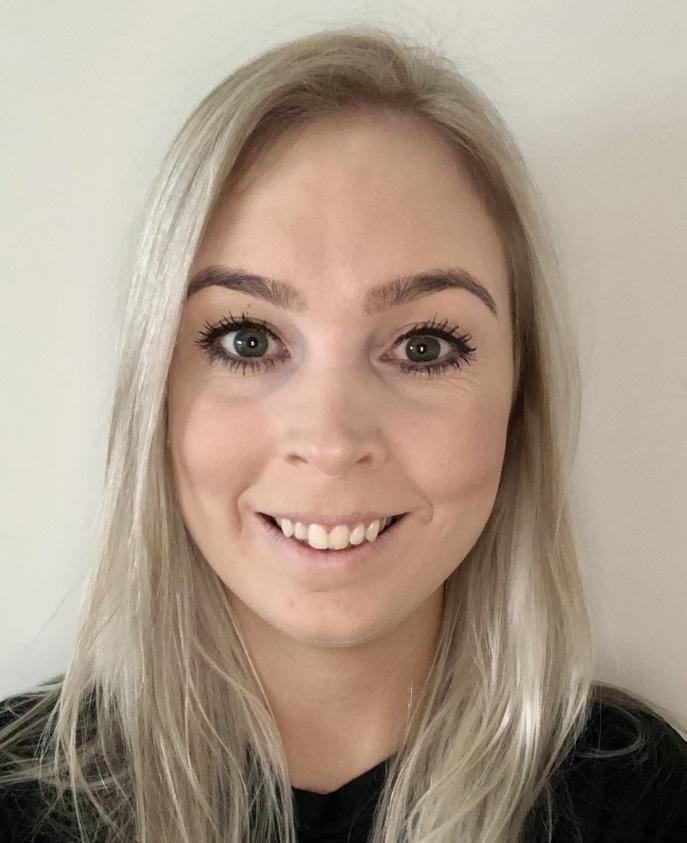
Editorial
Cora is the oldest participant at the WC
Cora Wijmans is representing the Netherlands at the World Championship in Oirschot. At 78 years old she is the oldest participant ever but in December she will turn 79.
Cora competes in all the pace disciplines riding her mare Remba frá Skógi but they are Dutch Champions in the pace test. This is the first World Championship for Cora and a place in the top 10 is the hope for this pair.

Cora has owned Remba since she was five and has trained her from the start. Remba is now 16 years old.
Most horses exported to Germany
In the first five months of the year, 665 horses were exported from Iceland, according to numbers from WorldFengur; 292 mares, 142 stallions and 231 geldings. More than half of them went to Germany or 337 in total. Of these 665 horses 27 of them had received first prize in FIZO. Highest rated of the exported horses were Spaði frá Stuðlum (total 8.73) and Organisti frá Horni I (total 8.72). Both went to Germany but Spaði will continue to the United States
It’s all about statistics
Looking over the fathers of the horses that are participating at the World Championship, Spuni frá Vesturkoti has the most offspring at the Championship, with six in total. Two of them in breeding and four in sport.
Next in line is Grímur frá Efsta-Seli with five offspring, three in breeding and two in sport. The brothers Álfasteinn and Álfur frá Selfossi have four offspring each.
Five mares have two representatives at the Championship. Minning fra Bendstrup has one in breeding, List fra Bendstrup, and one in sport, Muni fra Bendstrup. Minning fran Margretehof has two offspring in breeding representing Sweden, Merkúr and Mótor fra Smedjan.

Hrauna frá Húsavík has one offspring in breeding, and one in sport, Hersir and Höfði frá Húsavík. Tillit du Langeren has two ofspring in breeding representing France.Also Sæla (article on the right).
Looking at grandfathers Orri frá Þúfu í Landeyjum is behind 36 horses and Keilir frá Miðsitju twelve.
The breeding farm Kronshof has the most representatives of all breeding farms, with seven horses bred by them participating at the Championship. Four in breeding all representing Germany and three in sport, two representing Germany and one Norway.
The History of the World Championships 4 | Eiðfaxi International ...THIS&THAT
Sæla’s Legacy at the Championship
We all remember the performance of Sæla frá Þóreyjarnúpi and her rider Charlotte Cook when they won gold in 100 m. speed pass at the World Championship in Oirschot in 2017. Sæla and Charlotte represented Great Britain.

Now six years later while Sæla is enjoying motherhood two of her sons will be competing at the World Championship, Skinfaxi and Sólon fra Lysholm. Skinfaxi is representing Denmark with his rider Søren Madsen and Sólon Norway with his young rider Idunn Marie Pedersen. Both of them are competing in five-gait and the pace disciplines.
Two of her granddaughters will be in breeding, shown by Søren, List fra Bendstrup and Guðrún fra Bredgård. They are both daughters of Skinfaxi.
Weight study at the Championship
A research team at the Department of Equine Science of Hólar University will conduct a weight study at the Championship. The study is led by PhD.

Guðrún Jóhanna Stefánsdóttir and is part of Johannes Amplatz masters studies. They aim to perform research focusing on the body weight reatio (BWR) of riders and horses at the upcoming World Championship. The horses and riders will be weight in the days before the Championships. As the issue of animal welfare gains increased attention and industries have to demonstrate their legitimacy (Social license to operate), scientific research is fundamental. Instead of using criteria on ratio between rider and horse from other horse breeds and disciplines, it is necessary to collect data on the Icelandic horse.
Why orange?
Why do the Dutch wear the color orange to national events?
The Dutch wear orange because orange symbolizes national unity, and the Dutch signify national pride by wearing orange.
Orange refers to the family name of the Dutch Royal Family, the House of OrangeNassau, whose ancestor, William of Orange, founded the Netherlands and has thus been considered the national colour of the region for hundreds of years.
Eiðfaxi International | 5 Þórður Þorgeirsson
...THIS&THAT
He is my best friend”
Hulda Finnsdóttir hulda@eidfaxi.is
Viktoría Huld Hannesdóttir is a 10 year old horse girl, who is raised in the stable with her mom, dad and two siblings, Katla Dís and Brynjar Bjarmi.

Viktoría is a fan of all animals and knows nothing more fun than to go horseback riding.
Ihave been riding horses since I can remember. My first horse was named Spori and he was rather lazy. I now have two good mares that are named Snót and Agla. I have trained Agla since she was five years old and I want to show her myself in FIZO one day,” says Viktoría Huld who was lived in Skagafjörður until she was one year old, then she moved to Reykjavík for one year and back to Skagafjörður where she lived for three years, when her mother was learning at the University at Hólar.
“I started to go to riding seminars
6 | Eiðfaxi International
Interview “
at Sauðárkrókur when I was five years old. I rode our stallion Steinar frá Stíghúsi, who was also just five years old. Noone noticed that he was a stallion because he was really calm. I train him a lot and maybe I can compete on him next year. When my mom had finished Hólar we moved again to Reykjavík but a year ago we moved to Ás 2 which is located in the south of Iceland, near Hella, and I am hoping we never move again. I love it here. There are a lot of kids here my age that are also interested in horses and animals. I was at a riding seminar this winter and tomorrow I’m going to Leirubakki for a horse riding summer camp with my friends.”
One of a kind Þinur
Viktoría Huld riding the stallion Þinur frá Enni was on of the most memorable show at the Stóðhestaveislan that Eiðfaxi held last spring. Þinur is a first prize stallion and Viktoría’s favorite horse.

“He is my best friend, he is so sweet and always listens to me. This fall I got to ride him alone for the first time and I have been training him since. My mom has been helping me with him and I also took some riding lessons from Sigvaldi Lárus Guðmundsson, Flosi Ólafsson and Brynja Kristinsdóttir,” says Viktoría who enjoyed very much riding at the Stóðhestaveislan.
“My mom, dad and I decided to show three stallions at Stóðhestaveislan. That was really fun, I rode inside the riding hall ahead of them and the audience started
clapping so much I got a little bit shy. Þinur didn’t want to trot or show the spanish walk that we had practiced so I just decided to ride him in tölt.”
First year competing
Viktoría and Þinur have started their competition career together but Viktoría is finally old enough to start competing in childrens class.
“We won tölt T7 at the Reykjavíkur championship and then we competed at Fjórðungsmót which was a really fun road trip. We saw some reindeers and went swimming in the Lagarfljót. I made the finals and me and Þinur were doing great but then we accidentally took a turn on to the sports oval track so we had to leave the finals. I was very sad when it happened, it was not his fault he
Eiðfaxi International | 7
Viktoría and Þinur competing at Fjórðungsmót this summer.
Photo: Hafrún Eiríksdóttir
just misread my signals. I didn’t want Þinur to become sad so I picked up some carrots for him from the car and told him that everything would be okay, he did his best.”
Horse, fish and guinea pig breeder
Viktoría goes to school at Laugarland which she likes a lot but she has many friends there who share the same interest in horses. “When I come home I have something to eat and then go to the stable to train my horses, feed my guinea pigs and rabbits or I play with my friends. Then I eat dinner and go to sleep. Sometimes I do some chores to help out at home. We live on a farm and during the summer I sometimes wake up and go straight outside to herd the
horses home. We often go on horse trips and me and my cousin Una Björt ride like cowboys in full speed gallop before or after the horses that
are running free. That’s always fun,” says Viktoría
Viktoría has a lot of interest in breeding whether it’s guinea pigs, fishes or horses. “I own a mare that’s called Emelía Huld which I got when I was three years old and I picked out the name myself. I wanted one offspring after Þinur so I covered her with him this summer and I’m hoping to get a black mare with blaze, because then I’m going to try to exchange the foal for Þinur frá Enni but my mom owns him,” says Viktoría but her dream horse is a black mare with blaze, socks and blue eyes.
Viktoría has big dreams for the future but she wants to win Landsmót and make the national team to compete at a World Championship. “I also want to become as good as or even better than Olil Amble in riding gæðingalist,” says Viktoría finally.


8 | Eiðfaxi International
Viktoría riding Steinar frá Stíghúsi
Viktoría’s family at the Glacier Lagoon this summer with Þinur frá Enni. F.l. Younger brother Brynjar Bjarmi, her father Hannes Brynjar Sigurgeirsson, younger sister Katla Dís, her mother Ástríður Magnúsdóttir, Þinur frá Enni and Viktoría Huld

The Heart of Iceland
I was awestruck and inspired by the country of Iceland – its scenery and its people. And those horses! Their beauty is wild and somehow different from our little girl horse dreams. Copious manes and forelocks, unimaginably thick, seem to cloud their vision but can’t hinder their mission of carrying travelers as they’ve been meticulously trained to do.
Rebekah Godek
As riders, we’re aware of the power simmering beneath the saddle - power bred through centuries of rugged conditions. Our arms ache from holding the reins, guiding their gaits as though we have any say in their seamless way of going.

And yet, they make us imagine that we do. We are accomplished. We are powerful. We are the consummate equestrians. When our mounts slide into the natural paka-paka-pakapaka of the tolt, we beam with pride and glance at our companions to see if they recognize our prowess.
So many impressions fill my mind from only four days of riding. The snow-capped mountains ringing the sky at the edge of the Arctic Ocean, painted unfamiliar hues of purple, blue, and gray. The hardened hooves of our horses turning up red clay under the black lava sand; a soft sucking sound from each footfall reminding us that winter was not far gone. The rhythmic sound of the tolt – the heartbeat of Iceland – conjuring up sentiments of an ancient breed thriving in a harsh landscape for over 1,000 years.
Centuries ago, the wise parliament
10 | Eiðfaxi International
of Iceland outlawed the import of horses into the country. This hardy breed exemplified the heart of the people and their land – and they were unwilling to taint the ideal. When we think of majestic horses, our thoughts turn to Friesians and Arabians, but no breed can rival the purity and integrity of this robust Arctic animal. They’re majestic in their ability to survive harsh winters and thrive year-round in harsh landscapes. They’re majestic in their ability to tolt tirelessly for miles across varied and difficult terrain where wheeled vehicles dare not venture.
They’re majestic in their ability to connect with the herd for strength and security.
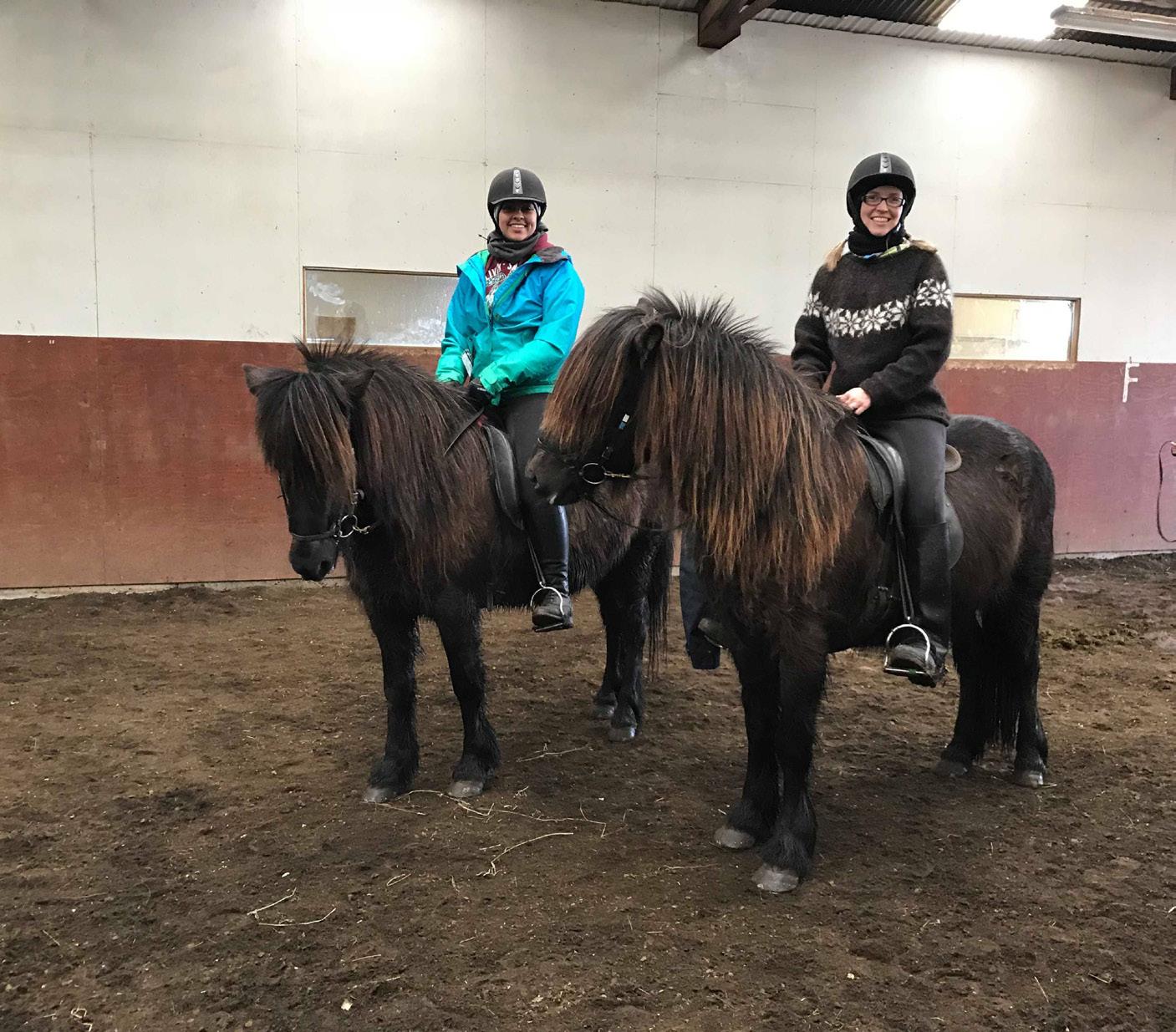
Toss out the images of noble steeds towering over the landscape and galloping thunderously across the fields. These noble steeds hug the ground and tolt furiously across the fields, snow, ice, mud, sand, pavement, brush, and any other part of the dynamic Icelandic landscape that emerges in front of them; without slowing a single rhythmic step.
In Iceland, emotion and creativity welled up inside me at every turn.
Back home, I desperately aspired to find words to capture the majesty and ancient feeling. But there is neither picture nor word that can capture that place. How can a picture give you air scented with ocean and sand and the pungent sweat of shaggy horses? How can words describe an ancient heartbeat gliding smoothly beneath you? How can either impart the heart of a horse never missing a step, as though his soul is somehow connected to the land that has been his home for centuries? I hope I can return some day and feel it all again.
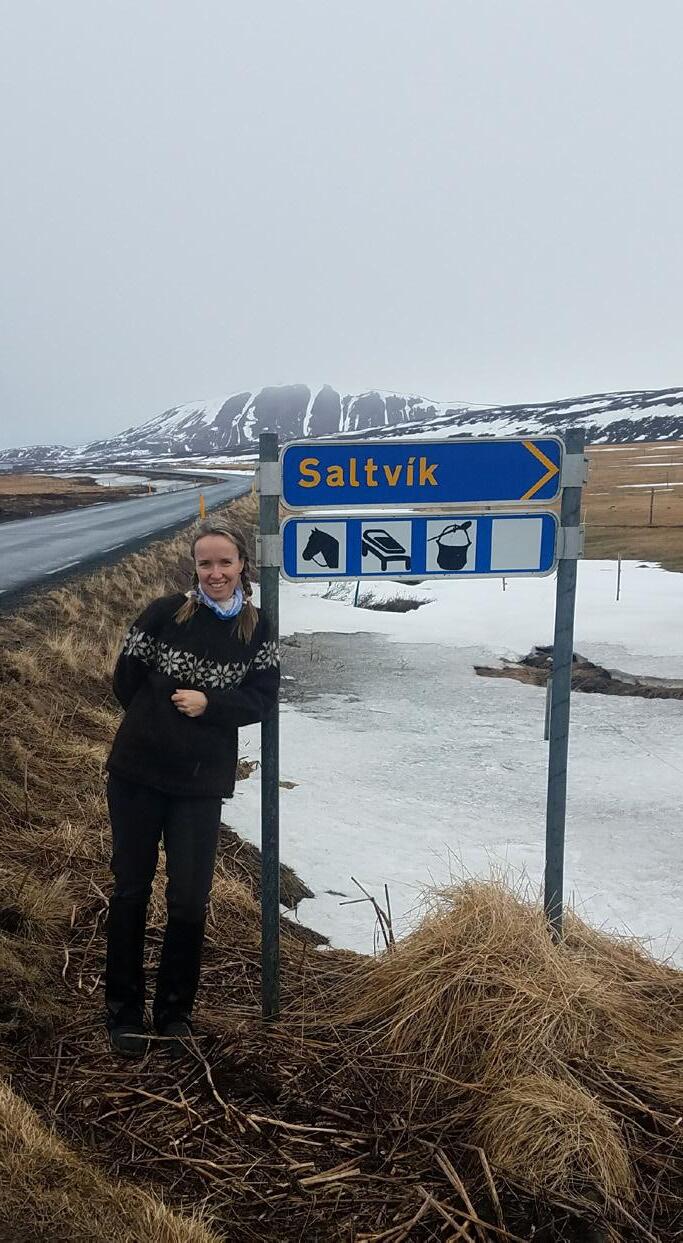
Eiðfaxi International | 11

12 | Eiðfaxi International
Tales about old World Champions Reminiscence
Unexpected European Champion in dressage
In almost all issues of Eiðfaxi readers can find stories about old heroes, stories told about a past event remembered by the narrator. In this article we have collected some of these stories told about former World Champions. Stories told by Albert Jónsson, Gunnar Arnarsson, Rúna Einarsdóttir, Daníel Jónsson, Sigurður V. Matthíasson, Atli Guðmundsson and Vignir Siggeirsson

Eiðfaxi International | 13
Hrafnkell Guðnason
Albert Jónsson and Ljóski frá Hofsstöðum
European Champions in Dressage in 1975
Ibought two horses from Sigurður Sæmundsson, Ljóski frá Hofsstöðum and a horse called Leiknir frá Dýrfinnustöðum. Ljóski was rather calm and easy going compared to Leiknir, he was rather difficult. This was probably in 1974 or ‘75, I was working at Stóra-Hof and had these two horses with me. As I said before Leiknir was rather difficult but quite amazing, he was a little bit pacey in the beginning but ended up being pretty good. I don’t know how it happened and that maybe dosen’t matter. These years I didn’t have a

lot of money so I wasn’t able to pay for them both so I returned Leiknir to Siggi and they ended up going to a European Championship. Leiknir was a genius.
I took Ljóski with me to the qualifying tournament for the European Championship in Austria in 1975 and we made the Icelandic team. While I was at the competition I didn’t stay at the same hotel as the other Icelanders so I didn’t drink as much as I would have done. I got a room with Piet Hoyos’s dad in a house that was really close to the
tracks but when I looked out the window I could see the track, so I was quite happy with it. I woke up really early one day and I heard from the sound system that the dressage competition was about to start. I thought to myself “well why not.” Ljóski was in a paddock near the track so I went and saddled him and rode him around a little bit. At this time you could just show up with the horse in the disciplines you wanted. So I went and when I was putting on the blue jacket someone tells me I need music for my program so I made a couple of Icelandic guys sing while I rode the program. I had no expectations so I thought that it went well. They stood their singing while I rode the program that the speaker told me to ride even though I didn’t understand a word in german. I didn’t even understand the numbers when they said them outloud after the program. It was a little bit later that Pétur Behrens and Reynir Aðalsteinsson walked up to me while the speaker was saying and I heard them calling out my name. Pétur and Reynir asked me if I had gone to the dressage this morning and I told them I did and they said well go on then and pick up your award. Apparently I was the European Champion in dressage. Hell this was fun, no other Icelander has ever won the dressage. Me and Ljóski also ended in third place in tölt and fourth in four-gait. He was a big hit with the Icelanders. A great horse who always did what was asked of him.
14 | Eiðfaxi International
Rúna Einarsdóttir and Freyr vom Northsternhof
European Champions in Five-gait Combination in 2009
Freyr comes to us in training at Frostwald and Hlynur Árnason who was then working for us starts him. Freyr was for sale. He was right away good on tölt but nothing else really. We bought him because his father was Fáni frá Hafsteinsstöðum and we wanted to get to know his offspring. The plan was always to sell him again.
When Hlynur quit working for us I started to train him. To be honest I didn’t like him that much, I was told to focus on four-gait with him and I thought that to be impossible because his trot was not that good and his canter either. To be honest he had created a little bit of tension in the household. I didn’t like training him and didn’t want people to try him out since I thought he was no good. There was no other choice for me than to just continue to train him at least until he was decent enough to let people try him and buy him. Me and Freyr practiced a lot together and things started to progress slowly. I decided to try out tölt T2 and things started to work out. He seemed to like it when I loosed the reins and let him be for a while.
We started to compete but let me tell you the road was rocky and sometimes I just wanted to throw in the towel and give up. The gait changes to canter were extremely difficult. He never wanted to canter on the right side but fortunately competitions were almost always

Eiðfaxi International | 15 Tales about old World Champions
ridden on the left side. He was an extremely difficult horse and I learned a lot from all our work. In the end I really enjoyed him and I care about him very much.
At the World Championship in 2007 we competed for the Icelandic team and I was pretty satisfied with our results, A finals in both T2 and five-gait. After the Championship a photo of me and him was published in the magazine Cavallo, a photo taken at a really bad moment and was supposed to stand for bad riding. This took a really big toll on me and I considered to stop riding horses at all. But I decided to just better myself and rise from the ashes.

We competed again at the World Championship in 2009 in Switzerland. That was our Championship, we ended second in tölt T2, five-gait and won the five-gait combination.
At the World Championship in 2011 in Austria I had the right to compete as a reigning World Champion in five-gait combination and after some thought I decided to show up again with Freyr even though we hadn’t competed together since the last World Championship. We ended in a-finals in both tölt T2 and five-gait, third Championship in a row.
Daníel Jónsson and Glóðafeykir frá Halakoti
Highest Judged 7 Years and Older Stallion in 2015
Igot the great honor of showing Glóðafeykir at the World Championship. He was fantastically trained by my friend, Einar Öder Magnússon. Einar had mentioned it to me that he would like to show him again in FIZO. It was a strange feeling to than be handed this project after Einar died.
Glóðafeykir is a solid horse, super well trained but it was amazing to be able to ride this horse.
The History of the World Championships 16 | Eiðfaxi International
Vignir Siggeirsson and Þyrill frá Vatnsleysu
European Champions in Tölt in 1997

Itook a job at Jón in Vatnsleysa in 1991 but then Þyrill was five years old and one of my projects. He was rather small, with a petite frame and a long and good neck. When I started training him I just rode him trot the whole winter to build him up. These years I thought a lot about building the horses up slowly. He showed right away that he was really light, willing and had good speed. In the spring I finished working for at Vatnsleysa and moved back south and rented a stable that Gunnar Arnarsson owned in Kvíarhóll in Ölfus. Þyrill was alway in the back of my mind. Me and Jón always kept in contact and I tried to get
him to send Þyrill to me. That year a Fjórðungsmót was held and I thought to myself it would be really fun to compete on him at the event. Jón ended sending me Þyrill in the middle of the winter but we both agreed that this horse could be something even though he was not trained much at that time. Þyrill won the Fjórðungsmót even though he was just six years old. That says a lot about the quality of the horse. Þyrill had this power and quality in the gates. He never lost his balance and he had this great willingnes and lightness.
We decide to try to make the national team for the WC in 1995. I
thought we did great but the judges didn’t agree. In 1996 we sold him to Germany. The new owner called me and wanted me to come and compete on him in Germany. I take him to one competition which we win and me and the owner start talking about the World Championship that would be held in Norway next year (1997). We decided the best thing to do was to get a good trainer for Þyrill to prepare him and then I would compete on him. I knew right away who would be the right man for the job and called Helgi Gíslason. He didn’t take anytime to think about it and went to Germany to start training him. I went regularly to Germany and competed on him in the spring to make ourselves noticeable for Siggi, the icelandic team leader. Birgir Gunnarsson in Germany also helped me a lot during this time with some fine tuning and stuff like that. All of this worked out in the end and Siggi selected us for the team. Now Jón and I were positive that this was it. We had the best tölt horse in the world and now was the chance to show it. It was rather a formality to show up to the Championship.
Us being selected was really controversial. There were even people that told me that we weren’t suppose to be there when I met them at the Championship. I didn’t let that have any effect on me and ended becoming World Champion in tölt. That is were our career ended. When you train a horse for a long time it will always be a part of you.
Eiðfaxi International | 17 Tales about old World Champions
Photo: Eiríkur Jónsson
Sigurður V. Matthíasson and Huginn frá Kjartansstöðum
European Champions in five-gait and five-gait comb. in 1995
Ihad seen Huginn with Þórður Þorgeirsson and Þorvaldur Sveinsson but Þorvaldur rode him in A finals in tölt at an Icelandic Championship. My dad and I were looking for a good five-gaited horse, a future competition horse, and went to Kjartansstaðir. We ended up buying the brothers; Huginn and Trostan. I loved Huginn, he was exactly my kind of horse, a four-gaiter but with pace. His tölt was always really good but I had to watch out to not make

him too good in tölt so it wouldn’t affect his pace. I trained him a lot in trot.
I took him to the qualifying competition for the World Championship in 1995 and we ended up with the highest score after the first round. When the second round was held the weather was really bad, raining and a lot of wind. We were showing walk, but we had shown a good program so far, when one door on the judged shed was always hitting back making
a sound that interrupted Huginn during the walk and we didn’t make the team. Few days later, Sigurbjörn Bárðarson decided to withdraw from riding Oddur frá Blönduósi at the WC, and ride Höfði frá Húsavík instead but Sigurbjörn and Höfði had a secure spot on the team (At this time the rider had to compete on the same horse to have a secure spot on the team). Because of that, Huginn and I made the team. I remember the day when I got the call but it was my birthday and it was Sigurður Sæmundsson who called me and told me.
I had heard that the horse Karly Zingsheim was riding, Feykir von Ringscheid, was a never seen before five-gaiter that no one could beat. I took it as a challenge and looked forward to going there and beating them. At this time you couldn’t look at videos of your opponents online. We had scouts who were taping the horses and then mailing you the videotapes. I remember watching a video of Karly and Feykir and thinking to myself that he was awesome. Their pace sprints, how Karly stopped him before the sprints, their canter changes and everything was just so smooth. But I told myself I could win that horse and with that thought I went to the Championship.
After the preliminary round we became second after Karly and Feykir so I decided to focus on the five-gait combination and we rode a decent tölt T2 program. I decided to ride him pace instead of the pace test. He had never gone into a starting box but I knew if he would come out on the
18 | Eiðfaxi International
right canter we would make a great time. We went into the box, it opens and Huginn goes out in cross canter. Also the next sprint. The second round was the next day and people in the team started telling me to forget about this and focus on the five-gait but I didn’t want to let this go and wanted to go for the gold in combination. The third sprint Huginn also goes on cross canter. They called a family meeting to try to talk me out of taking the fourth sprint but I told them that If I would win the combination gold I would also win the five-gait because then I had nothing to lose. With almost everyone against the decision we went the fourth sprint. Huginn went out of the box in the right canter, I made him gallop as fast as he could toward the line and didn’t think about changing to pace until at the line. On pace he went, across the finish line and the gold in five-gait combination was ours.
I’m sure that if I hadn’t won that gold I would have played defense in the finals in the fivegait. Instead I show up like a Hyena. Even though statistics said otherwise I was always going to win. Your mind does half the work and it didn’t hurt that I was riding a horse I knew well and knew what I could ask of him.
Atli Guðmundsson and Blá frá Úlfsstöðum
Highest judged 5 year old mare in 2001
Blá came to me from Magnús Sigurðsson at Úlfsstaðir, two months before being shown in FIZO in the spring of 2001. I liked her right away and showed her in good numbers. When she went back east to Magnús I asked him to let me know if he would ever like to sell her. A little time went by then he called me telling me Blá was for sale. Me, Gunnar Arnarson and Halldór Guðjónsson bought her together. We set our mind to the Championship held that summer and that worked out well but she ended highest in her age group. Blá was in many ways really special, always with her ears forward and with this high leg action tölt.

Eiðfaxi International | 19 Tales about old World Champions
Gunnar Arnarsson and Kolbakur frá Hvassafelli
World Champion in pace test PP1 in 1991
This is a horse I bought from Ólafur Jósefsson. A great five-gaited horse. Really trustworthy and fun to ride. Clear gaits and pacing came real easy for him. He didn’t do great things on pace right from the gecko but he always became better, more speed and he was really technical in the end. In 1991 we were chosen to be a pace horse in the Icelandic team at the European Championship in Sweden with pace test as an extra discipline for us. But surprisingly we became European Champions in the pace test and in 2nd place in pace. This was the only title that the Icelandic team won that Championship.

20 | Eiðfaxi International Tales about old World Champions
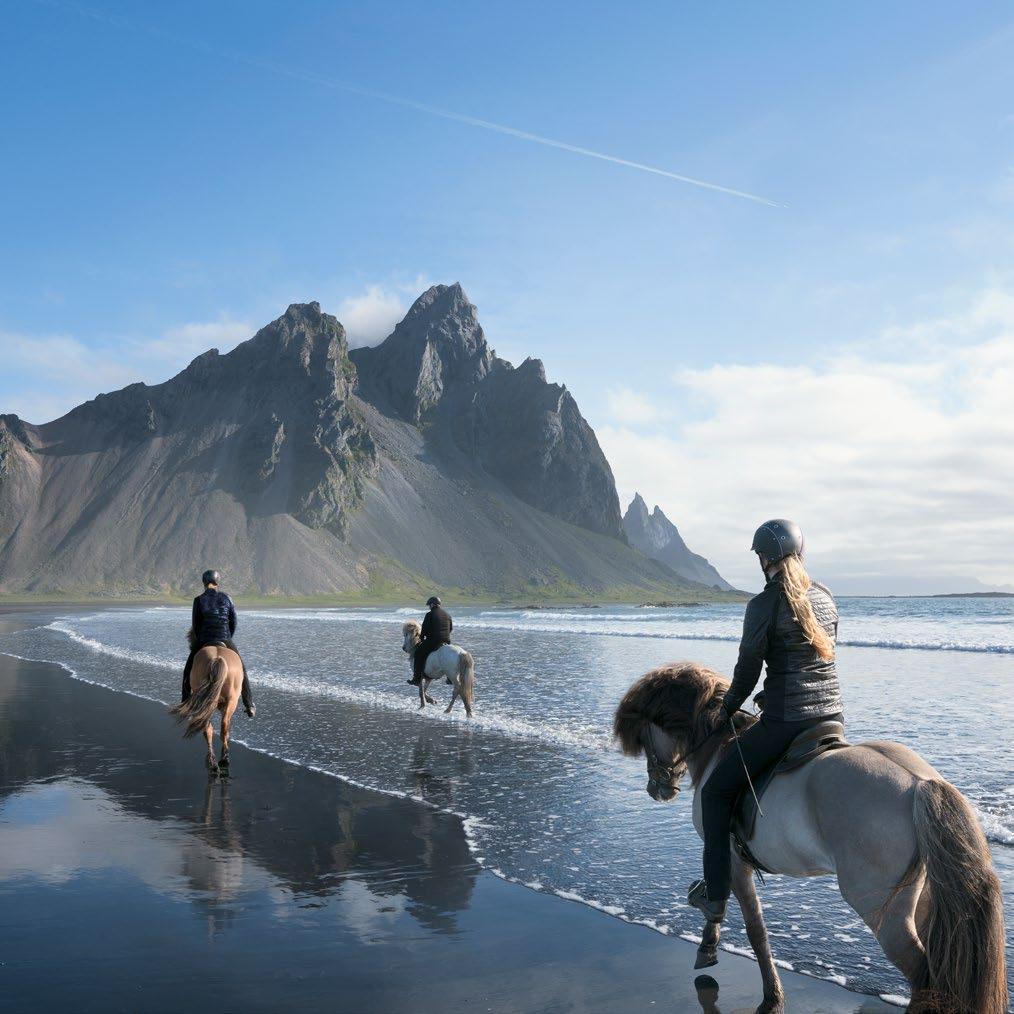
Meet the Icelandic horse: icelandair.com Direct flights to Iceland!
 Breeding farm of the year
Interview with Olil Amble & Bergur Jónsson
Hulda Finnsdóttir hulda@eidfaxi.is
Translation: Berglind Margo
Breeding farm of the year
Interview with Olil Amble & Bergur Jónsson
Hulda Finnsdóttir hulda@eidfaxi.is
Translation: Berglind Margo
This year, the titles “Breeding Farm of the Year” and “Competition Horse Farm of the Year” went to the same breeding farm. This is the fourth time that Ketilsstaðir/Syðri-Gegnishólar receives these titles in the same year. It is the seventh time they are awarded “Breeding Farm of the Year” and the sixth time they receive “Competition Horse Farm of the Year”. Olil Amble and Bergur Jónsson are the ones behind the breeding farm. They are not newcomers in the field and boast a magnificent breeding achievement over many years.

Eiðfaxi International | 23
“
The key is to have faith and following it through”
This is a particular recognition that tells you that you are doing something right and it’s nice to receive confirmation that you are among the best. Besides that, we are extremely proud and happy to receive this nominations,” says Olil, emphasizing how important it is for them to receive these breeding titles. “We may not experience any significant changes, but it’s always nice to receive a pat on the back. The title ‘The Competition Horse Farm of the Year‘ perhaps helps the breeder more in their operations than the other one since selling competition
horses is really what brings in more revenue,” adds Bergur.

They believe that the title “Breeding Farm of the Year” may have more significance because that title carries more weight in the eyes of most people as it is an acknowledgment that has been awarded for almost 30 years. However they are not sure which title matters more to them and say both titles are important in their eyes and support each other to some extent.
“On the larger market, the title of ‘Breeding Farm of the Year’ holds higher value than the ‘Competition Horse Farm’ title, but we feel that is starting
to change. With the introduction of stricter regulations in breeding shows, people understand less what is happening. Consequently, they trust and invest less in those shows, unfortunately. However, they do understand the competition aspect better. The futurity competition format is becoming very popular abroad, there young horses are showcased and receive positive feedback with a more relaxed approach. It doesn’t matter what we think or whether we find breeding shows important. If people don’t understand them and are constantly disappointed, they stop attending

24 | Eiðfaxi International
The trophies for The Breeding Farm of the Year and The Competition Horse Farm of the Year in 2022
Bergur og Olil with their second youngest grandchild, Fía Amble Friðgeirsdóttir
with their horses. People engage in this for entertainment, not just for living of off it, so you tend to turn to something you find fun. I hear a lot about this in my work, which I travel for to many places,” says Olil.
Emphasize on getting their mares to honorary prize
This year, Olil and Bergur presented nine horses, and eight of them received first prize with an average total score corrected for age of 8.21. In addition to these individually shown horses, six horses from their breeding received prizes for offspring.
Four mares received honorary prizes: Álöf and Spes frá Ketilsstöðum and Heilladís and Skjóða frá Selfossi. Two stallions, the brothers Álfarinn and Álfaklettur from Syðri-Gegnishólar, received first prize. The latter stallion stood at the top of his group at Landsmót.

“We greatly enjoy breeding horses and we put a lot of effort into not selling foals or young horses. We want to tame them ourselves and find a good path for them. We dedicate ourselves to bringing those mares that are likely to have the potential for honorary prize forward and we have a lot of fun doing it.
It’s important to us, and of course, we receive valuable information about the broodmare by training all her offspring,” says Olil, and Bergur adds, “The mare has so much to say. There are so many people who think too little about the mare. They jump forward when they see a stallion that has gotten a high score in breeding assessment and is popular, even though the mare may have nothing more to contribute than the fact that her reproductive organs are in good condition.”
Two strains meet
Eiðfaxi International | 25
Ásdís frá Syðri-Gegnishólun, 6 years old, by Álfaklettur frá Syðri-Gegnishólum and out of Grýla frá Stangarholti, in their father‘s offspring group at Landsmót. The rider is Bergur Jónsson. Mynd: Kolla Gr.
The horses from Olil and Bergur’s breeding are both associated with Ketilsstaðir and Syðri-Gegnishólar They both started breeding early; Bergur at around 12 years old and Olil in her thirties. It was in the year 2000 that they began to merge their breeding efforts, although not under a single name and there is a good reason why the horses are attributed

to either Syðri-Gegnishólar or Ketilsstaðir.
“This is, of course, a single breeding. The only thing we do differently is keeping track of the mares’ initial origins. Simply because we find it enjoyable. If it says Ketilsstaðir, we know that the horse has direct maternal lineage from there, and if the horse is registered from Syðri-
Gegnishólar, it means that the horse’s direct maternal lineage comes from Selfoss, Stangarholt, or Kleifar,” says Olil. However, one could say that in their breeding, two strains meet: on the one hand, from Kleifar, and on the other hand, from Ketilsstaðir. The Ketilsstaðir horses are longestablished horses from Bergur’s family, tracing their ancestry back
26 | Eiðfaxi International
Álfaklettur at Landsmót 2022 where he received first prize for offspring. The rider is his owner and breeder, Olil Amble. Mynd: Kolla Gr.
120 years without hesitation.
“I had tried to breed from many mares, but when it came down to it, it was the mares from Kleifar that were chosen,” adds Olil referring to Grýla frá Stangarholti, who was out of Spurning frá Kleifum, and became the mother of Álfadís frá Selfossi and Mugga frá Kleifum. Mugga is, among other things, the
great-grandmother of Gráhildur frá Selfossi, who received an honorary prize for offspring last year. Mugga is also the mother of Lygna frá Stangarholti, who has been one of the most successful broodmares in Gísli Gíslason and Mette Mannseth‘s breeding at Þúfur.

The broodmare is key
Every year, about twelve to fifteen foals are born on the farm and it can be a lot of work to take care of all of them effectively.
“It’s a lot of work to have so many horses in a single year if you want to follow through and give them all opportunities. Even if a horse is gelded, he has a great ancestry and should have a bright future ahead of himself, even if he‘s not destined to be a stallion. We place great emphasis on training the horses before selling them, so we know their capabilities. Upbringing and training are factors that greatly impact the overall outcome,” says Olil. Their breeding is based on mares that are all different but which share the common traits of being enjoyable to train, cooperative, and possessing exceptional traits. The mares they found particularly enjoyable to ride and had a good breeding assessments were the ones that entered their breeding.
“First and foremost, we have to like the mare in order for her to become one of our broodmares. It doesn’t necessarily depend on her breeding assessment. A mare with a total score of 8.05 can be much more remarkable to us than a mare with a total score of 8.30. Personally, I want the horses to be enjoyable and cooperative. Horses that are willing to do what I ask of them,” says Bergur, and Olil adds, “Yes, temperament is a significant factor, as well as energy. When I started this, it was the movements that captivated me, that they were impressive, and one
Eiðfaxi International | 27 Breeding farm of the year 2022 in Iceland
Bergur on his childhood land, Ketilsstaðir but Bergur and Olil‘s young horses and foals grow up here.
was even willing to overlook the fact that temperament wasn‘t enjoyable. Nowadays, things have changed. It makes a tremendous difference to find that the horse enjoys the task and shows interest in it. A broodmare should be enjoyable, receptive, and positive, with a willingness to work with the rider.”

As mentioned before, they have a great variety of broodmares that have different qualities. Within
the group, it is possible to find exceptional fivegaiters, graceful fourgaited ballerinas, tölt mares and everything in between.
“The fact that the mare possesses something that one desires to find in the next offspring is of great importance. Not everything one does in breeding yields the goal aimed at. The entire process of creating the horse, nurturing the dreams, following through, providing the
best conditions and then seeing what becomes of it; all of that is what makes one a breeder. The emotion and excitement that breeders experience by betting on and bringing mares to stallions and seeing what comes out of it, that’s where the fun lies. When one reaches the goal, then it‘s extra fun,” says Olil, adding that reaching the goal is not the same for everyone, but for them, it means obtaining a horse that is „a golden nugget“ which
28 | Eiðfaxi International
Álfgrímur frá Syðri-Gegnishólum, son of Álfadís frá Selfossi and Orri frá Þúfu í Landeyjum, ended up in 7th position in B-class at Landsmót ‘22.
Photo: Kolla Gr.
will get a great role in the future.
“Throughout time, we have been very cautious in selling mares and as a result, we are selling mares today that we would never have considered selling 10 years ago, simply because we can do so without it affecting our breeding,” they add.

More precious than gold
Olil remembers well the first mare
she owned that received first prize in breeding assessment. The assessment score took her by surprise, and she was a very proud and happy owner. However, the mare did not become a broodmare but was sold instead.
“It was very rare at that time to have a mare with first prize. However, there was nothing special about the mare that I wanted to continue with, even though she had some numbers on paper.”
At that same time, Olil decides to keep a mare that isn’t highly rated on paper, with a total score of 7.69; 7.65 for conformation and 7.73 for abilities. She pairs the mare with Adam frá Meðalfelli, and from that mix, the breeding wonder Álfadís
frá Selfossi is born. Of course, the mare in question is Grýla from Stangarholti, whom Olil holds in high regard.
“I didn’t really expect this, and
Eiðfaxi International | 29
Álfadís in the summer night, home at Syðri-Gegnishólar. With her is her son born in 2019, the father is Arður frá Brautarholti. She has 20 offspring and 15 of them have been shown in breeding assessment. She recevied honorary prize for offspring in 2011. Photo: Heidi Benson
„
I didn’t really expect this, and I would have been grateful for much less
I would have been grateful for much less. I was determined to keep Grýla, even though she had a low breeding assessment score. She was stressed and never showed herself as the amazing
mare she was at home. I was determined not to let her go and paired her with a horse that had similar movements. Grýla had incredibly big movements, extension, and reach,” says Olil. As mentioned before, she paired the mare with Adam.
“He was levelheaded and calm, and I have always believed that he never did more than he needed to. He was incredibly beautiful, good-tempered and reliable, and somehow they blended wonderfully. He seems to have been gold combined with these
high energy horses. For example, if we look at how Orri frá Þúfu came to be: he is by Otur frá Sauðárkróki, who often seemed to give too much energy, and a daughter of Adam. There comes this magical blend again.”
It can truly be said that Olil hit the bullseye with this pairing and achieved one of the greatest breeding successes. Álfadís leaves a significant mark on horse breeding, not only for Olil and Bergur but for Icelandic horse breeding as a whole.

“You have to be true to yourself and have faith in what you hold in your hands. Just like there, I decided to sell the first prize mare that perhaps most would have chosen to breed from. I chose to keep a mare that wasn’t as highly rated. I believe this is a key factor for the breederto have faith and follow it through,” says Olil and Bergur adds, “Yes, it’s so important not to be like a leaf in the wind, but to stand firm with oneself.”
If they are good it does not matter where they are from
30 | Eiðfaxi International
Ljósálfur frá Syðri-Gegnishólum out of Álfadís and by Lord frá Vatnsleysu at Landsmót 2022 in Lord‘s offspring group. Photo: Henk & Patty
„
If the way the horse is measured is so crucial, shouldn’t we pay closer attention to how the measurements are carried out
When choosing a breeding stallion for their mares, they place great importance on the horse having good lineage, size, and appearance. They prefer the horses to be beautiful and have a strong presence, whether it’s standing in the stable or being ridden. They do not choose specific bloodlines and do not care where good comes from.
“We try to think about the size and that they are well built. We are quite diverse and use what appeals to us and evokes joy within us. We use all kinds of breeding stallions as long as they have something that captivates us. We have used most of these stallions that are available, as long as they are not too closely related to our horses. It holds great value for a horse to have beauty, and they can have it even if they don’t get a sky high score for conformation,” says Bergur and Olil agrees. “We don’t think much of conformation if does not come with good ridden abilities. An exceptional breeding horse should be one of which you can make a competition horse and an outstanding leisure horse. In our minds, a horse is not a suitable breeding horse if it cannot perform in competition. We’re not saying that it must have already achieved something in competition, but you must see the potential in it, that it is that kind of horse.”
Having tamed, trained, and even shown the mares that breeders choose to include in their breeding gives them a certain advantage. They have a wealth of information about the mare that helps them pair
Performance of horses from the farm in competitions in 2022:
Sprengja frá Ketilsstöðum was German Champion in young adults class in tölt T1 (7,39), mid-european Champion in same class (7,78) and ended in 6th position in adult class with a score of 7,70.
Hlébarði frá Ketilsstöðum was in 2nd position in fivegait F1 at the Swiss Championships (7,40) and in 4th position in PP1 pace test (6,71).
Jónatan frá Syðri-Gegnishólum was Swiss Champion in loose rein tölt T4 (6,53).
Stefnir frá Ketilsstöðumwas in 13th position in fivegait F1 (6,27) at the Swiss Championships, and in 2nd position in fivegait (6,57) as well as in 1st position in tölt T1 (6,43) at Osi Weitingen
Dugur frá Ketilsstöðum was in 2nd position in loose rein tölt T2 at Osi Weitingen (6,83)
Meginn frá Ketilsstöðum was in 6th position in fourgait V1 at the German Championships (7,27)
Gígur frá Ketilsstöðum was in 4th position at the WR Sleipnir sport competition in fourgait V1 (7,13)
Álfaklettur frá Syðri-Gegnishólum was at the top of the preliminary round in fivegait F1 at the WR Sleipnir sport competition (7,30)
Spurning frá Syðri-Gegnishólum was in 5th position in fivegait F1 at the WR ranking sport competition (6,50) and ended in 2nd position in „parafimi“ in Suðurlandsdeildin (with a mare from another farm)
Álfgrímur frá Syðri-Gegnishólum ended in 7th position in B-flokkur at Landsmót (8,71), preliminary round 8,70 and semi-finals 8,64
Goði frá Ketilsstöðum was in 7th position in teenage class at Landsmót (8,57), preliminary round (8,57) and semi-finals 8,60. He was also in 4th position in Gæðingafimi in Meistaradeild Líflands og æskunnar (The Lífland and Youth Master League).
Fákur frá Ketilsstöðum was Reykjavík Champion in tölt T7 in teenage class (6,60)
Sigð frá Syðri-Gegnishólum was in 6th position in tölt T1 in Youth class at the Icelandic Championships (703) and won the Gæðingafimi in Meistaradeild Líflands og æskunnar
Baldursbrá frá Ketilsstöðum was in 6th position in Gæðingafimi in Meistaradeild Líflands og æskunnar (The Lífland and Youth Master League).
Silfra frá Syðri-Gegnishólum Silfra frá Syðri-Gegnishólum and a mare from another farm won „parafimi“ in the Suðurlandsdeild (South Iceland league).
Feykir frá Syðri-Gegnishólum (young adults class), Stinni frá Ketilsstöðum (A-class) og Fröken frá Ketilsstöðum (young adults class) competed for their horse club Sleipnir at Landsmót.
Eiðfaxi International | 31
her with a stallion in the future. The information about the stallion is not as extensive. The main things you have at hand about him are his pedigree, competition results if any, and perhaps the performance of his offspring. Olil and Bergur know their mares very well and try to seek additional information about the stallions whenever possible.
“We have much less information about the stallion than we do about the mare. Of course, we try to gather any additional information we can. It’s incredibly fun to see the horses in a regular riding hall or competing on an oval track. Riding hall shows are also entertaining, but the only downside is that you don’t have any supervision over the shoeing and weighted boots. Therefore, those can
be unreliable sources of information. Also, often in such shows, fivegaited horses are shown as outstanding in tölt, but no pace is shown or the pace is four-beated. We want to know what the horse can do when it shows all five gaits. If it can’t pace with that tölt, there’s little to rely on except for just to put on a show. Therefore, one must always choose the information one receives and examine it critically. In competition and breeding assessment though, we know that decent hoof equipment is in use.”

Want more open conversations
Olil and Bergur are strong individuals and are not known for holding back their opinions and criticism. They
both say that they miss the continuous conversation there was in the past. The conversation between those who set the rules and those who have to follow them. They both want to see the conversation take place and for the discussion to be more open to everyone as well as for different kinds of professionals to have the opportunity to contribute.
“There is a complete lack of conversation and discussion among all these stakeholders. There are great professionals in the equestrian world: riding instructors, trainers, show riders, tamers, competitors, breeding judges, sport judges, gæðinga judges, and breeders. We need to have many more conversations about what is good and what is right. It cannot be right that a small group of individuals decides everything for us about how our horses should be.”
In recent years, many emphasis changes have been made regarding the judging of breeding horses, and they feel that these changes were not adequately communicated to breeders and others who work with them.
“The way the horses are measured makes a tremendous difference, but we know that we can bring the horse to breeding assessment within a week’s interval, and the horse’s measurements are taken differently. If the way the horse is measured is so crucial, shouldn’t we pay closer attention to how the measurements are carried out?” says Olil, mentioning an incident where they brought a horse for judging
32 | Eiðfaxi International
Álfarinn frá Syðri-Gegnishólum and Olil Amble at the Reykjavíkurmeistaramóti (Reykjavík Championship). They went on to compete for Iceland at the World Championships in 2019 in fivegait.
and its height decreased by 4 cm on the withers in the same week. “This is not credible. At the very least, it’s thought-provoking and worthy of discussion. You wouldn’t find it acceptable if your carpenter measured like that,” adds Bergur. Showing the horse with loose reins in tölt and riding from the walk directly into tölt are two requirements that rider and horse must fulfill in order to receive a score of 9.0 or higher for tölt in breeding evaluations. Many show riders are unhappy with these requirements, and Olil and Bergur share the same opinion.
“Personally, I would have liked to see much more emphasis on collecting ability in tölt. I believe that speed changes would have been a better requirement. A good speed change demonstrates the horse’s complete tölt ability. You are showing slow tölt. You show that he has agility, balance, rhythm, speed, and collecting ability. All the qualities we want a good tölt to possess. I would have much rather seen speed changes in older horses rather than loose reins.”
Let‘s stand together
There is substance for a whole book to record all the ideas and opinions that Olil and Bergur have regarding equestrian sports in general, as they are very experienced and full of knowledge. The journalist directs the discussion towards the future and how they envision it.
“There is a lot happening. We have an amazing horse that captivates
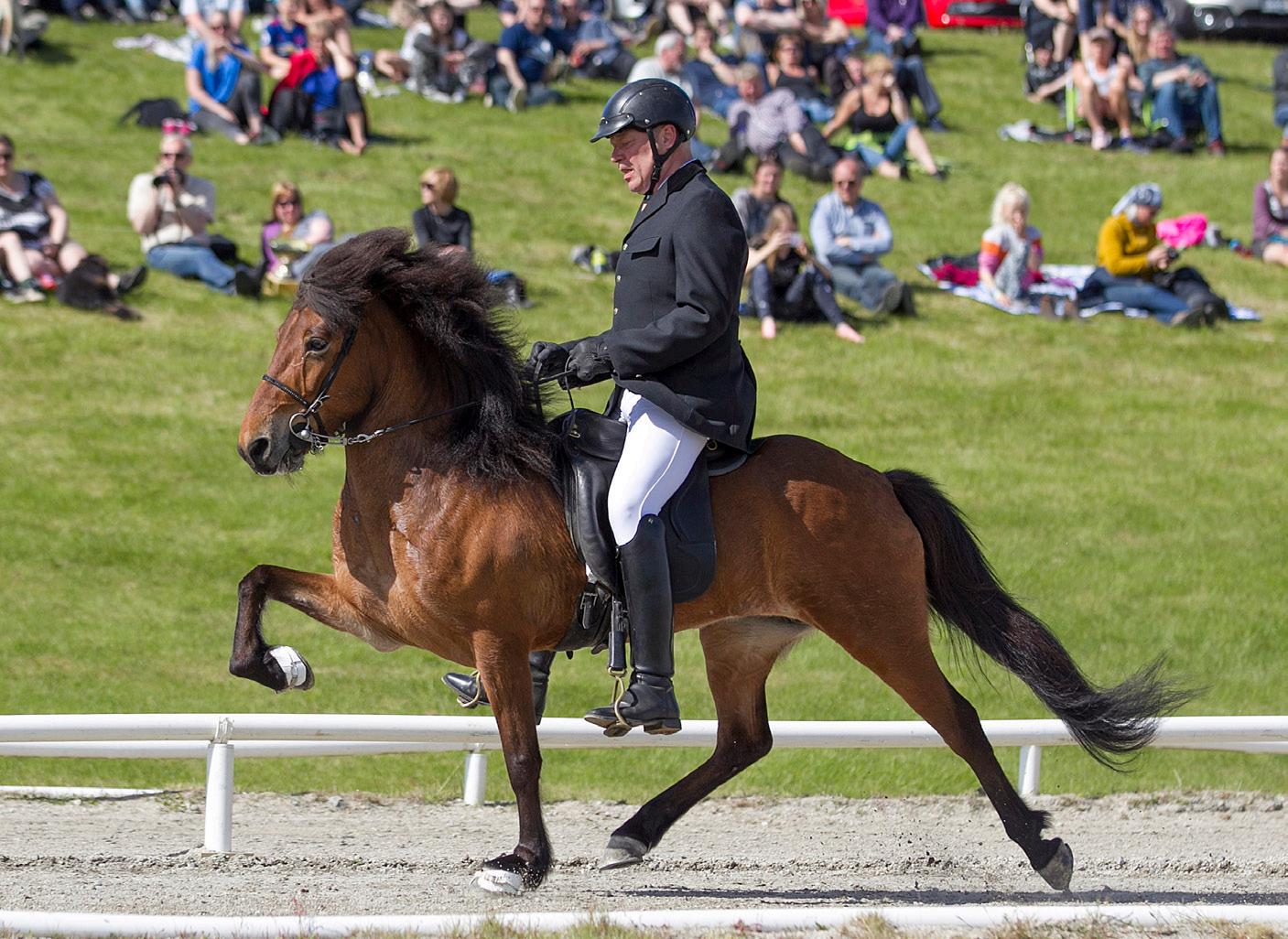
the market and there are many opportunities. Not to mention what would happen if the breed would become a tiny bit bigger; we have these international associations following us, claiming they can prove many of us are too big for the horse, so I believe we should try to increase the size of the horses, but do so carefully. We also have large and underutilized markets that we could improve upon. We would like to see more quality riding schools where people can learn from educated instructors and ride exceptionally well-trained horses. It would attract customers and expand the market. The riding course culture has come to stay in Iceland, and we will see much more of people coming together with good teachers, their horse,
and friends enjoying to learn more. “The future prospects are really good, but in order to continue with the system we have today, we need to work better and closer together. I would like to see all our top people in the equestrian field stand together and work towards the same goal, which is the well-being and success of the Icelandic horse,” says Olil, adding, “As things are today, things will always go well because there is such an abundance of exceptional horsemen and women in the country. However, it could go much better if we stood together more effectively.”
Don’t want to be the richest corpses in the cemetery
Regarding breeding and the
Eiðfaxi International | 33
Katla frá Ketilsstöðum and Bergur Jónsson. They had a successful competition career together. Katla received 8,90 for ridden abilities as a fourgaiter; that is the highest score a fourgaiter has ever received.
We don’t want to be the richest corpses in the cemetery. We simply want to allow ourselves to enjoy
operation at Syðri-Gegnishólar, they will continue unabated. In their hearts, they are horse breeders and will be throughout their lives.
“We simply intend to live life to the fullest as long as it is possible. We have reached a point where we can allow ourselves to ride the horses of our choosing for longer than we did before. For example, we allow ourselves to ride mares that, in the past, we would have put into breeding long ago. Also, we allow ourselves to keep a horse here and there that we want to own, like Álfaklettur, even though many do ask about him. We were saying the other day that we don’t want to be the richest corpses in the cemetery; we simply want to allow ourselves to enjoy,” says Olil. An exceptional facility has been steadily built on their land over the years with all the necessary amenities and in the best way possible.
“We have plenty of plans. We want to pay better attention to our staff. We have exceptional staff that we want to involve more, teach them and provide them with more
opportunities. We always intended to bring people here for instruction, but we have somewhat been lazy in doing so. We want to enjoy more of what we have been building. We will most likely continue to show horses in breeding shows, although currently it’s not as exciting as it used to be. Maybe we ourselves are changing, it’s not unlikely. Many older breeders have stopped showing breeding horses at a certain point. It was incredibly exciting and the most fun thing we did, but it’s not anymore. There are so many fun things happening, and it might just be nice to look ahead and try to find a new path. It might be worth considering a version of this Futurity competition, which is so popular in Germany. I think it could be a very exciting option, as it is a horse-friendly and entertaining approach to the search for future competition horses. We set
up a show in Ölfushöllin in 2020 in collaboration with Júlio Borba and Hafliði Halldórsson: „The Clinic“, which was a lot of fun, and we aim to do it again next year. There are plenty of ideas brewing within us; it’s not strange for one to try to channel ones energies into various areas in search of fulfillment and enjoyment,” they conclude
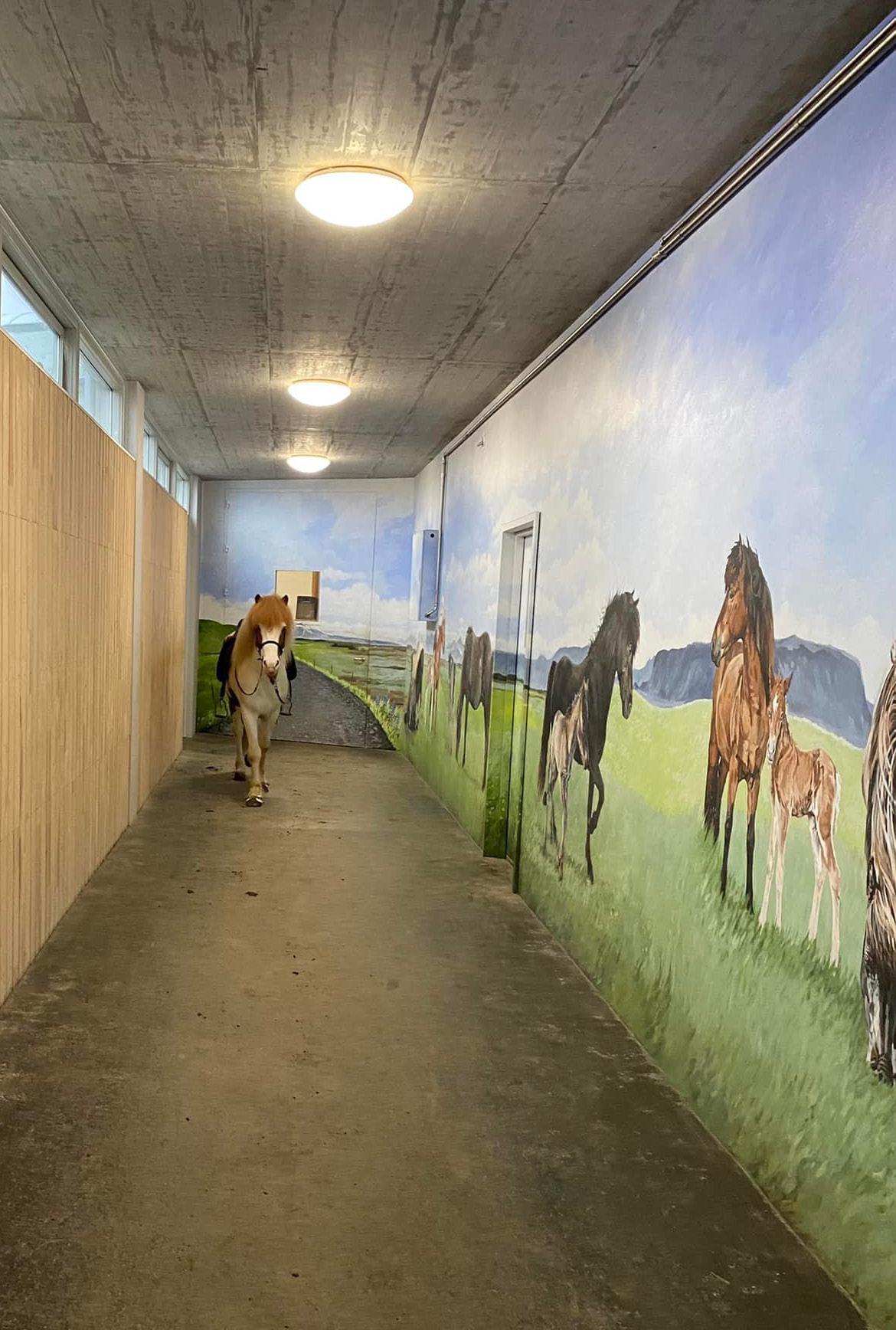
34 | Eiðfaxi International
Olil and Bergur have put a lot of effort into making their surroundings beautiful. Here is the entrance to their riding hall. The picture on the wall is of their broodmares and is hand-painted by Josefine Morell.
„



The History of The World Championships History

The largest event for the Icelandic horse held outside of Iceland
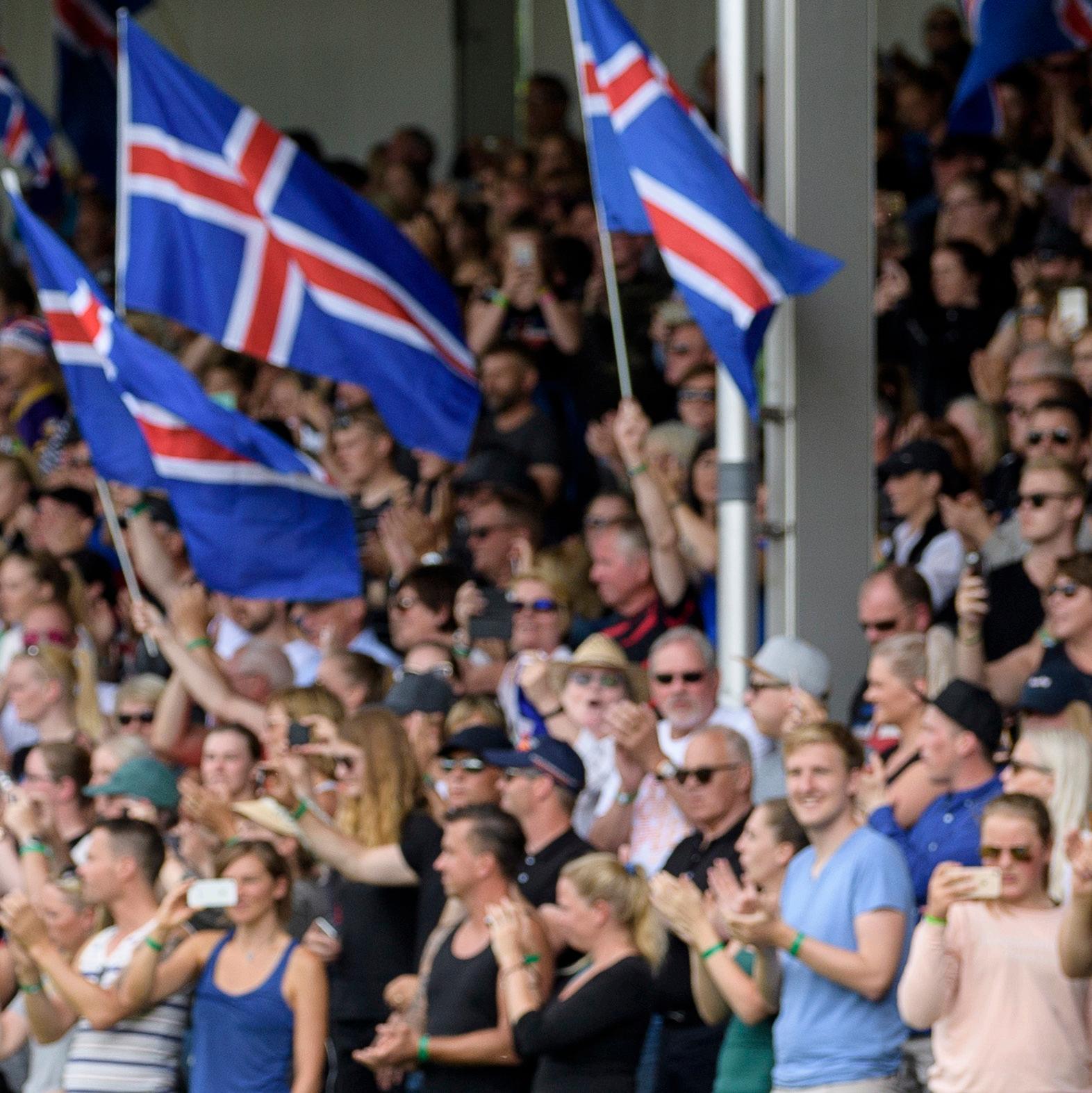
The World Championships are the largest event held outside of Iceland connected to the Icelandic horse. Every other year thousands of people gather at a predetermined location to compete and watch the Icelandic horse in all its glory.
The beginning of the World Championships can be traced back to Gunnar Bjarnason, as so many other things related to the Icelandic horse. He convinced the right people in Europe to form an association of Icelandic horse friends. FEIF was created and it stands for Föderation Europäischer Islandpferde-Freunde. FEIF was founded in 1969 and the primary goal was to organize an international competition. In 1970 the first European Championship for Icelandic horses was held in Aegidienberg in Germany, which was a precursor to the World Championship. The first World Championship was held in 1991, but the name of the competitions was changed after the number of FEIF member countries outside of Europe increased.
The World Championships are held every two years in one of the member countries. The event offers a sports competition as well as a breeding show. All member countries have the right to send 12 riders, 7 adults and 5 young adults but the selection of the riders is carried out in various ways depending on the nation. Today the World Championships are team events, i.e. all competitors in the event must belong to a team. However, all disciplines are individual disciplines and the winner of each discipline is named World Champion. Breeding horses appeared for the first time at a European Championship in 1983, but then the horses were not judged, just shown. In 1985, they were judged for the first time and it has been done ever since. As mentioned before, the first Championship was held in Germany, and for the first two decades, German riders were the ones to defeat. In the 1990s, Icelanders gained the upper hand and have been the strongest nation last events.
Following is the history of the European and World Championships, the 26th of which will take place in Oirschot in the Netherlands in August this year. This coverage will focus on the sports part of the Championships but the history of the breeding shows will have to wait for another time.
1970 - Aegidienberg, Germany
Oneday event
The first European Championship was held in Aegidienberg in Germany at Walter Feldmann’s ranch but he organized the event and it is said that he covered all the costs of the event himself. Participating nations were Germany, Iceland, Denmark, Austria, Switzerland and the Netherlands. Each nation had the right to send five horses to compete, which all nations did except the Dutch who sent three. The tournament started at 8 o’clock on Sunday and lasted until 6 o’clock in the evening. Except for one discipline that took place on Saturday night, the dressage. In Morgunblaðið, an Icelandic newspaper, on pages

203 you can read a quote from the dressage competition; “The Germans won this event with superiority, but the Icelanders did not participate. In fact, few if any Icelanders will have such a great knowledge of European riding schools that they will be able to sit a horse in a way suitable for this competition.”
Other disciplines were tölt, fourgait (tölt, trot, walk and gallop), fourgait where pace was shown instead of gallop, five-gait, pace and endurance race but in the endurance ras; “it was allowed to show all gaits except gallop. An exciting competition where each nation sent its team to the track and the best time of a single horse determined the results” (Morgunblaðið).
Competing for Iceland were Anton Guðlaugsson riding Gusti, Sigurður Magnússon riding Blossi frá Aðalbóli í Miðfirði and Reynir Aðalsteinsson riding Stjarni frá Svignaskarði, Logi and Hvellur. Reynir was second in the pace riding Hvellur and riding Stjarni he placed second in the tölt and the endurance race and won the four-gait.
“It was known that there would be a very close call between Reynir Aðalsteinsson, Iceland’s main rider at the Championships, riding Stjarni and Walter Feldmann senior riding his stallion Vörður and the Swiss girl Barla Maissen riding Víkingur. Walter Faledmann was the first one to enter the track together with his team members. Vörður’s time was magnificent. - Some time later, a group of Icelanders entered the track and Stjarni started an impressive run on his very fast tölt. And the result

38 | Eiðfaxi International
Reynir and Stjarni at the European Championship in 1970, winners of V1 Photo: Einar Gíslas.
was much to the delight of the audience. Stjarni had about 7 seconds faster time than Vörður. Then came the Swiss team and with them Barla Maissen on her Viking, who rode very aggressive pace one lap after another, but this endurance ride is three kilometers in total. And the end was that she skillfully shot both of them behind her” (Morgunblaðið). Barla Maissen secured two gold medals for Switzerland at the tournament, but the other one was in pace.
The nation with the highest score was awarded. Germany received the highest score, by far with 1,481.5 points. Iceland was in second place with 906 points. Walter Feldmann Jr. riding Funi fra Kaupvangi swept up the gold medals (5) and became the highest-scoring rider of the Championship with 390.8 points.
When the Championship was over an auction of the Icelandic horses took place, where Stjarni was sold for 220,000 ISK. “This auction was so exciting that it was like something out of a story. People can imagine it, when a 7-yearold gelding goes for a sum of 220,000 Icelandic krónur, even if this gelding is a great and impressive töltari....Skúli Kristjónsson from Svignaskarði, [breeder of Stjarni], was at the Championship and showed Stjarni himself when he was auctioned. First he rode him gracefully on the field, but then got off his back, walked in front of Stjarni and had him lift his legs forward on his shoulders to the great joy of the spectators. It added to the excitement of the auction.”
Germany 5 golds
Switzerland 2 golds
Iceland 1 golds
1972 - St.Moritz, Switzerland
The Championship of disappointment
The Icelanders showed up with a great team and gradually the number of countries participating began to increase. This year it was decided to increase the number of horses from five to seven. The icelandic riders at the Championships were Reynir Aðalsteinsson riding Dagur frá Núpum, Darka frá Deildartungu and Glæsir frá Einarsstöðum, Pétur Behrens riding Hrafn frá Þingnesi, Ágúst Oddsson riding Landi frá
Kolkuósi,
Árni Guðmundsson riding
Sleipnir frá Lágafelli and Ragnar Hinriksson riding Kláus frá Álfsnesi. According to information found about this tournament people had mixed feelings about it. There was a lot of tension between teams and FEIF officials began to wonder if the Championship should become more of an individual event and place less emphasis on the competition between nations. It also cast a shadow over the event when a rider for Denmark,

Eiðfaxi International | 39 The History of the World Championships
Barla and Vikingur flying at the Championship in 1970
Bert Jönsson, and his horse died in a collision on the way home from the Championship.
Sigurður Sæmundsson, once said in an interview with Morgunblaðið when he was the team leader of Iceland that the Championship in Switzerland was a fiasco. “It was an adventure and everything was up in the air. On the way from the airport in Zurich to the competition site, the driver insisted on tying the horses and Dagur frá Núpum got stuck and was unfit to compete. The stable guy was piss drunk and it took a long time to sort out the accommodation for horses and people. This championship was a fiasco for everyone and the reason it took three years until the next championship was held.”
The Championship did not go well for the Icelanders and they ended in fifth place in the team competition. As the year before Germany had the most points. Bruno Podlech riding Stjarni frá Svignaskarði won the tölt, Walter Feldmann jr. won the fivegait riding Funi fra Kaupvangi and Wolfgang Berg won the four-gait riding Gáski. The pace and cross country won Barla Maissen riding Víkingur and the dressage won Eveline Meier á Hassan - in total three gold to Switzerland.

After the Championship people began to wonder if there was a need in changing the rules in tölt but this “Hackney tölt” that Bruno and Stjarni showed was not the desired look that people wanted for the Icelandic horse. The future of endurance riding was also discussed and was this the last championship for this
discipline.
Iceland’s hopes of victory seemed to be tied to Sigurbjörn Eiríksson riding Dagur, but after Dagur was injured on the trailer on the way to St. Moritz, these hopes were dashed. At this event, Icelanders took part in the dressage for the first time. In Morgunblaðið in 1972 you can read the following about the competition; “This discipline did not go too well for us. Kláus jumped out of the track, and all the horses looked stressed compared to the other well-trained horses that were there.”
In the tölt, the Germans ranked in the top five. “Our horses fell behind after various mistakes. One of our best horses, in the tölt, Hrafn, ran around the field sensitive and without a tölt step....It was then already difficult to be an Icelander in St. Moritz. Be there as participants and not have any of the top 10 best horses in tölt. It is a lesson that we Icelanders must learn from, for the future, in terms of breeding and training,” wrote Morgunblaðið’s journalist on the occasion.
40 | Eiðfaxi International
Germany 5 golds Switzerland 3 golds
Walter Feldmann jr. riding Funi.
Photo: Aðsend
1975 - Semriach, Austurríki
Iceland wins the tölt for the first time
This Championship is historic for us Icelanders in the context that this was the first time Iceland won the Tölthorn. Reynir Aðalsteinsson riding Dagur frá Núpum won the tölt with flying colors. The tournament was also memorable because, to everyone’s surprise, Albert Jónsson won the B-dressage, in which the Germans had almost dominated. “This victory was no less unexpected for the reason that Albert and his horse Ljóski frá Hofsstöðum, two months before the competition, had never entered a paddock, much less rode an dressage exercise” (Morgunblaðið, 1983 tlb. 188 p. 25.).
It is estimated that 2000 people
were at the tournament. There were 48 contestants from eight nations. Norway and France participated for the first time, otherwise it was Austria, Denmark, the Netherlands, Germany and Switzerland. The Icelandic riders were Aðalsteinn Aðalsteinsson riding Hrafn from Kröggólfsstaðir, Reynir riding Dagur and Skúmur frá Hellu, Albert riding Ljóski, Sigurður Sæmundsson riding Hvinur frá Haga, Eyjólfur Ísólfsson riding Léttir frá Álfsnes, Trausti Þór Guðmundsson riding Stefnir frá Hreðavatni and Ragnheiður Sigurgrímsdóttir riding Gammur frá Hofsstöðum. She was the first woman to compete for Iceland at the
Championships.
At that time, there was a great variation in the competition disciplines between championships, as they were constantly evolving. However, one competition event has always remained almost intact, and that is the tölt competition. In this event, a multi-gait discipline was introduced, but then four-gaited and five-gaited horses competed together. The event replaced the four-gait and five-gait that had been separate events at the championships before. This arrangement was not used again at the European Championships. Show jumping was held for the first and only time, and the dressage competition was split in two groups.
The book Dream & Reality, published by FEIF, discusses the European Championships and how inexperienced the judges were at these first championships and this often affected the execution of the tournaments. The pace competition suffered from the horses reluctance to start which caused delays and the pace test was affected by the inexperience of the judges.
At this Championship, the Dutch won their first gold. Janneke Faber riding Léttir frá Innrihólm won the multi-gate. The Icelanders won two golds and the Germans four. Walter Feldmann Jr. and Funi from Kaupvangi were the highest ranking at the end of the tournament, just like the previous championships. Germany 6 golds

Iceland 2 golds
The Netherlands 1 gold
Switzerland 1 gold
Eiðfaxi International | 41 The History of the World Championships
Reynir and Dagur at FM1972 in Iceland
Photo: Einar Eylert Gíslas.
1977 - Skiveren, Danmörku

Dream finals in the pace race for Iceland
Sweden and Belgium had joined FEIF bringing the number of participating nations to ten. At this Championship the disciplines were tölt, four-gait, five-gait, pace, cross country and three different classes in dressage, one of it had to be ridden in trot and one in tölt.
For the first time, breeding horses were a part of the championships, but they were not judged, only introduced. Lotta frá Kröggólfstöðum
had two offspring competing at the championship so she was awarded an honor prize.
The year before, 1976, FEIF published their first set of formal competition rules, IPO, and these rules were used at this championship. These are the same rules that are being used today, FIPO, but they have changed a lot since they were first made.
Spectators were said to be around
3 - 4,000, which was not considered a lot at that time. “The spectators were not many by Icelandic standards, at least we would have thought that this was a poor turnout for the Landsmót” (Eiðfaxi 1977).
Before the Championship it was believed that Iceland would be victourious but according to sources they had never been so well prepared for a championship before. Indeed was the case.
Sigurður Sæmundsson was
42 | Eiðfaxi International
Siggi Sæm riding Leiknir and Alli Aðalsteinsson on the European Championship in Denmark in 1977
the highest ranking rider at the Championship riding Leiknir frá Dýrfinnustaðir. They won the pace with the time of 24.0 sec, which was considered an excellent time. In second place was Sigurbjörn Bárðarson riding Gýmir frá Miklholti, Rafnar Hinriksson riding Grettir was in third and in fourth place Reynir riding Stokkhólma-Blesi frá Stokkhólma. The top four places in the pace race went all to Iceland. In the combined points competition between riders, Sigurður was first, Reynir third, Aðalsteinn fourth and Sigurbjörn fifth. This was considered a great achievement, but at that time the highest-scoring rider and winning the tölt were considered the most coveted titles. The total score for the combined points was found by adding up the scores in tölt, fouror five-gait and pace, dressage or cross-country.
The French won their first gold medal ever at the Championship and that was in cross-country, but it was Martin Dischinger who won it riding Kópur frá Velli. Bernd Vith won two gold medals for the Germans, in tölt and four-gait, riding Fagri-Blakkur frá Hvítárbakka. Their name will be forever written in the History of the Championships as one of the most successful pairs. Walter Feldmann Jr. kept up the usual style and won three gold medals riding Eldjárn.


Germany 4 golds
Iceland 2 golds
Switzerland 2 golds
France 1 gold
Eiðfaxi International | 43 The History of the World Championships
Þrír stigahæstu keppendurnir, Sigurður, Walter Feldmann yngri og Reynir.
Vekringarnir tilbúnir í verðlaunaafhendingu.Sigurður á Leikni, Sigurbjörn á Gými, Ragnar á Gretti, Reynir á Stokkhólma-Blesa og Rudolph Bischoff á Hreini.
1979 - Uddel, the Netherlands Competed on borrowed horses
After a good performance in the last two championships Icelanders wanted to do better than last time. After the qualification round in Iceland it was clear that Iceland could send a very strong team and the goal was set high. The top five places in the five-gait were to be ours and the top three places in the pace as well. Of course, the highest ranking rider of the tournament was supposed to be Icelandic. At this point the Icelanders
had not won the Tölthornið and hopes were made to get it out of the hands of the Germans.
When the horses came to Holland, they got sick, infected with influenza and all the hopes and dreams of the Icelandic team collapsed. In the 9th issue of Eiðfaxi in 1979 the position of the Icelandic riders at the beginning of the championship is described like this; “It was a shocking experience for the riders to watch as one horse after another began to cough and their

temperature rose to 40-41 degrees. Instead of training and preparing for the competition and showing the superiority of the horses from Iceland, the task of the owners and riders was only to nurse sick horses.”
This was a devastating blow for the Icelandic team, they would not get to compete on their horses. The Germans responded quickly and offered to lend the Icelanders horses to compete on. The invitation was accepted and the horses were quickly sent to Holland. It was a close call, but the Icelandic riders had just two hours to get to know their horses before the competition started. It wasn’t just the Icelanders whose horses got sick, because the Swedes had the same problem and competed on borrowed horses as well. This illness taught people to pay more attention to infection prevention and also it would be good to have spare horses or riders ready for the championships. At this championship, warm-up horses were supposed to be used for the first time, but they ended up being borrowed instead of the sick horses.
But the flu wasn’t the only thing hitting the Icelandic team because several team members got food poisoning and were unable to compete. Therefore Aðalsteinn Aðalsteinsson, Reynir Aðalsteinsson, Sigurður Sæmundsson og Ragnar Hinriksson were the only ones able to compete.
How fast things can change. The championship that started as a nightmare quickly turned out to be a victorious and joyous
44 | Eiðfaxi International
Ragnar Hinriksson riding Fróði frá Ásgeirsbrekku
Photo : Sigurgeir Sigurjónsson
time. Ragnar became a three-time European champion riding Fróði frá Ásgeirsbrekku. They won the five-gait, pace and Ragnar was the highest ranking rider. When the Icelandic riders heard what loan horses they would receive they knew that it would not be an easy task to show Fróði well, but he was known for being temperamental, tight on the reins and occasionally jumping off the track in the middle of the competition. In an interview with Ragnar that appeared in Eiðfaxi Haust 2020, he describes the fivegait a finals; “Fróði was a talented horse, but he was considered quite hard-tempered, eager running horse and was not promising for success. I only got one ride to get to know him and then straight onto the oval track. I found him to have considerable ability and tölt well but he was stiff on the reins. There was no time to dwell on such things. It got off to a good start but in the middle of the program I found he was starting to think about jumping off the track. Then there was nothing else to do but solve it right there and then, and I resorted to the idea of putting my
leg, which was facing away from the judges, into the horse’s muzzle. It was enough for the horse to stop thinking outside the track and continue.”
Reynir was third in five-gait and Aðalsteinn fifth in four-gait, which was considered a good result, but at that time it was a discipline that Icelanders had always struggled with. In Morgunblaðið in 1983,

197th issue, on page 25 there is a description of the championship in the Netherlands; “When the Icelandic team entered the track in the Netherlands, their chances of a medal were slim to none, but when it came down to it, they were overall the moral winners and Ragnar Hinriks was a three-time European champion.”

It should be mentioned that Barla Maissen and Víkingur competing for Switzerland won gold in pace at this championship, but they also won the pace at the first European Championship in 1970 and again in 1972. This time Víkingur was 21 years old and winning his fifth title. Barla, Reynir and Johannes Hoyos all had the same time.
Germany 4 gull
Iceland 3
Netherland 2
Switzerland 1
Austria 1
| 45 The History of the World Championships
First time competed in pace test
The sixth European Championship and this time ten nations participated and 60 horses. The competition started on Friday and ended on Sunday.
For the first time riders competed in pace test (PP1) but this was just for trial so not a competition for a European title. The Icelandic
riders ended in first four places. The Germans ruled the four-gait wing and took home most of the gold medals. The cross-country waned even more in popularity, but the track had obstacles that were so difficult that few horses and riders finished the race. As before, the oval track disciplines were most popular.

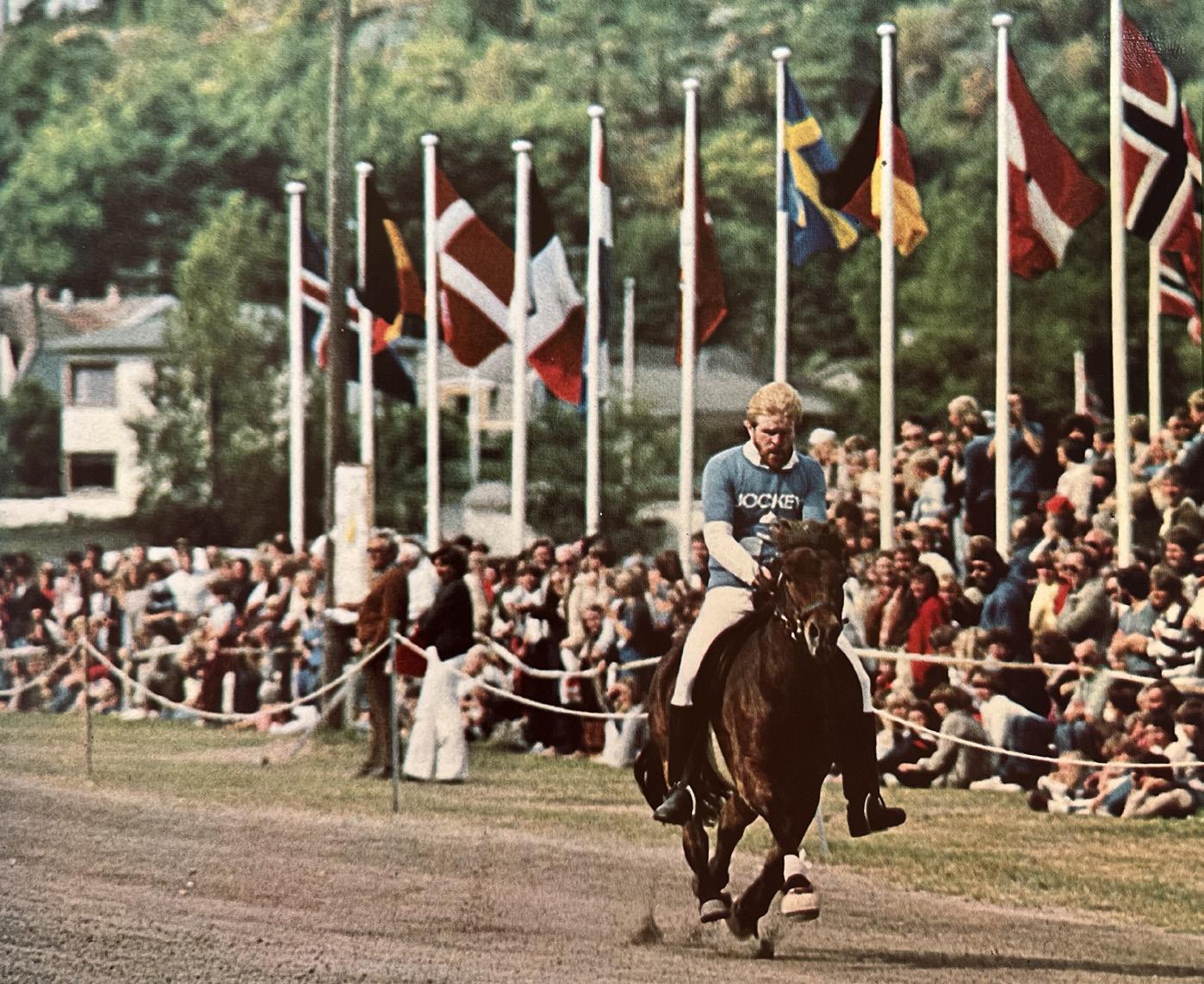
Attention was drawn to the fact that the top three riders in the tölt were all women, but it is worth noting that there were women in all teams except the Icelandic one. Only once had a woman competed for Iceland, but that was in ‘75 in Austria.
At the European Championships it was believed that Iceland’s main potential was in pace and five-gait but little chance of finals in tölt and fourgait. Christina Mathiesen defended her title in tölt riding Gammur frá
Hofsstaðir and Bernd Vith riding Fagri-Blakkur won four-gait third championships in a row and their fourth title. Two Icelanders made it to the finals in five-gait, Benedikt Þorbjörnsson riding Valsa frá
Lambhaga and Ragnar Hinriksson riding Nasi frá Akureyri. Walter Feldmann won the five-gait riding Eldjárn and this was also Eldjárn’s last race.
Sigurbjörn was riding Adam frá Hólum, which he had only used as a pace horse in the past. However, he decided to compete with him in all four disciplines that you need to take part in to become the highest ranking rider of the championship. After just a little adjustment Adam became an all round competition horse and Sigurbjörn won the title. They won the pace with the time 23.0 sec and the pace test (not an official event and therefore they did not get a title).
The Norwegians got their first gold and it was in cross-country, the rider was Nils Henning Sonne Andersen riding Rex frá Ártúni.
46 |
1981 - Larvik, Noregi
Germany 4 golds - Iceland 2 golds - Norway 1 gold
Sigurbjörn and Adam frá Hólum
The wonder awaits you
Immerse yourself in the geothermal bliss of Blue Lagoon Water —a nourishing marvel found nowhere else in Iceland.

Discover the water. Experience the wonder.
Scan code and book now
1983 - Roderath, Germany
Germany and Iceland with four gold each
Ten nations came to compete and each with seven horses, except the Belgians and Swedes who had four each. It is noticeable that the Icelanders had a great advantage in five-gait and pace at the first championships that were held. “Our chances of success in four-gait and tölt are vanishingly small, and people live in hope that something unexpected will happen on those fronts. As for the five-gait and pace, it is no secret that victory is the only thing Icelanders can be satisfied with.” (Morgunblaðið 1983).
Iceland won four gold medals out of nine possible and had representatives in all finals. Riders were chosen
at a qualifying competition held in July at Hella and those who competed on behalf of Iceland at the Championship in Roderath were Aðalsteinn Aðalsteinsson riding Baldur frá Sandhólum, Eyjólfur Ísleifsson riding Krákur frá Reykjavík, Reynir Aðalsteinsson riding Sproti Frá Torfastöðum, Tómas Ragnarsson riding Fjölnir frá Kvíabekk, Gunnar Arnarson riding Galsi frá Sólheimatungu, Lárus Sigmundsson riding Bjarmi frá Kirkjubæ and Olil Amble riding Blikar frá Höskuldsstöðum.
It is estimated that around 7,000 people attended the competition
and around 300 were Icelandic. Up until the year 1983, there had been competition for the title of the highest ranking rider of the championship, and an Icelander had won that title in the last three tournaments before. In 1983 they changed the rules and now riders competed for two such titles; one for five-gait combination and one for four-gait combination. In order for riders to be eligible to compete for these titles, they had to participate in four events. In tölt, five-gait, pace race or pace test and dressage to be eligible for five-gait combination or they had to compete in dressage, four-gait, tölt and
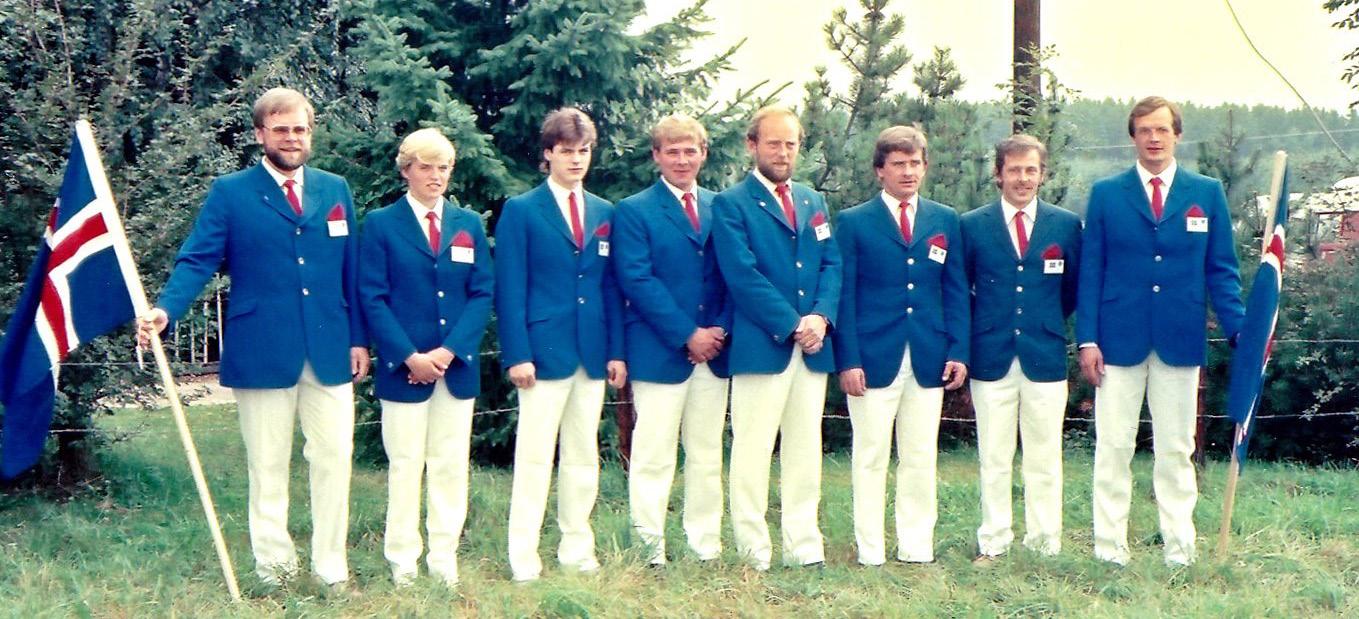
48 | Eiðfaxi International
The Icelandic team. TL: Eyjólfur Ísólfsson, Olil Amble, Tómas Ragnarsson, Gunnar Arnarson, Reynir Aðalsteinsson, Aðalsteinn Aðalsteinsson, Sigurður Sæmundsson og Lárus Sigmundsson
cross-country. However even if not awarded Eiðfaxi published the results of the highest ranking riders and it was noted that the five Icelandic riders; Tómas, Reynir, Eyjólfur, Aðalsteinn and Gunnar had finished 2nd, 3rd, 4th, 5th and 7th place.
A sure victory for Iceland in the pace test but Aðalsteinn ended in first place and Ragnar in third. The Icelanders also owned the pace race. Tómas riding Fjölnir won the pace with the time 21.7 sec, but the current world record was 21.6 sec, narrow difference there. Reynir was second riding Sproti and Aðalsteinn third riding Baldur. In addition to the gold in the pace race Tómas and Fjölnir won the five-gait combination.
“The last day of the tournament started
with dressage at eight in the morning, but somehow the Icelanders seemed to be in a more disobedient mood. At least there were no awards in this discipline. From noon, what can be called the highlight of the tournament began, the results in the fivegait competition……Aðalsteinn riding Baldur and Tómas riding Fjölnir were neck and neck in the finals and enormous cheers broke out. The winner had to be decided by a special duel between them. Aðalsteinn won the duel when three out of five judges awarded him victory. Reynir Aðalsteinsson riding Sproti won third place, Hoyos riding Sóti was fourth and Eyjólfur Ísólfsson riding Krákur was fifth. This was a final that the Icelandic spectators will never forget.” (Tíminn, 1983, issue. 212, p. 4).
Heidi Nilsen won gold in crosscountry competing for Norway, but
she was riding Hera frá Kirkjubæ. Walter Feldmann Jr. won one gold for the Germans and Hans Georg Gundlach won tölt and four-g vom air riding Skolli vom Hestarhof.

At this championship as well as in previous tournaments, the main problems were the use of drugs and riders were being disqualified due to the administration of drugs. All kinds of different equipment, bridles, hoof guards, etc. were also being used. This was a persistent problem at this championship as well as in previous tournaments, and it was clear that something had to be done.
Iceland 4 golds
Norway 1 gold
Eiðfaxi International | 49 The History of the World Championships
Germany 4 golds
Winners in pace, Tómas Ragnarsson riding Fjölnir to the right
Unexpected results and complaints
After the Icelandic horses got sick during the 1979 championship, a decision was made to export the horses as late as possible. For the championship in 1985, the horses had to be exported earlier than was thought desirable, as the horses were transported by ship. The trip took five days and the sea was very good. No horse got sick and everyone was in good spirits when they arrived at the competition site.
Before the championship people were moderately optimistic about
Iceland’s success. Some had theories about Icelanders sending secondclass horses to every other European Championship as they were saving the good horses for Landsmót that was held the following year. This theory had a lot of support and as Valdimar Kristinsson wrote in the Icelandic newspaper Morgunblaðið he believed it to be true, backed up with the results of the Icelandic team in previous championships.
Competing for Iceland were Eiríkur Guðmundsson riding Hildingur
frá Hofsstaðaseli and Kristján
Birgisson riding Háleggur frá SyðraDalsgerði, competing at EC for the first time. With more experience were Aðalsteinn Aðalsteinsson riding Rúbín frá Stokkhólma, Sigurbjörn

Bárðarson riding Neisti frá Kolkuósi, Benedikt Þorbjörnsson riding Styrmir frá Seli, Lárus Sigmundsson riding Hörður frá Bjóluhjáleigu og Hreggviður Eyvindsson riding Fróði frá Kolkuósi. Before the competition it was believed the Icelandic team would be most successful in pace and less successful in five-gait. It therefore came as a surprise to many when the only EC title won by an Icelander was in five-gait, but Benedikt won the discipline riding Styrmir frá Seli. There was also great satisfaction among Icelanders when Sigurbjörn Bárðarson unexpectedly reached the A finals in tölt, but Sigurbjörn was riding Neisti frá Kolkuós, a fivegaiter, and they were not considered great achievers in this discipline at that time.
As mentioned in the preface, it was at this tournament that breeding horses were judged for the first time. The highest judged stallion was Gáski frá Gullberastöðum (t. 8.25) and the highest judged mare was Hilda frá Ólafsvík (t. 8.21).
Valdimar Kristinsson described the breeding show in the following way in Morgunblaðið, in 1985: “This was some kind of pocket version of breeding shows in Iceland. Þorkell Bjarnason announced the verdicts, while Gunnar Jónsson, from Denmark, interpreted in Danish, German and English, so that the
50 | Eiðfaxi International
1985 - Vårgårda, Svíþjóð
message would hopefully reach all the spectators who listened. In the category of stallions, 8 horses were shown and 6 mares. Of the stallions, there were 4 that can be considered good, although one of them was not usable due to its small size.”
Several complaints arose during the tournament, and Icelanders were among the complainants. They appealed against the judgments in the pace test, but they were dissatisfied with the judgment of the judge who judged the downward transition. Aðalsteinn was arguing with the head judge about the matter and missed the second sprint so he was disqualified. Eiríkur was also disqualified because he forgot to wear a helmet in the second sprint. After this there was great dissatisfaction among the Icelandic team.
At this Championship, you could see that the difference in quality between nations both in terms of riding and quality of the horses was getting smaller. This time the most successful teams were Austria, Norway and Denmark, although the Germans stayed there course winning the tölt and four-gait. Wolfgang Berg riding Funi won the tölt and Daniela Schmitz riding Seifur frá Kirkjubæ won the four-gait.

Austria 1 gold - Iceland 1 gold - Germany 3 golds - Denmark 2 golds - Norway 1 gold
1987 - Weistrach, Austurríki Tölthornið heim eftir 12 ára útlegð
This Championships was considered to be grand and the surroundings very beautiful. The result of the Icelandic team was considered good and the most important part of it was that for the first time in a long time the Tölthorn was on its way back to Iceland after 12 years in Germany. The Tölthorn was and is the most sought-after trophy of the World Championships, so this was a welcome victory for us Icelanders. It was Sigurbjörn Bárðarson who won it riding Brjánn frá Hólum.
“When the results were announced, the Icelandic spectators and other Nordic people went nuts out of excitement. Rarely or never have there been such lively celebrations at the EC. - The Tölthorn had returned
home after 12 years of exile in Germany.” (Eiðfaxa 9. issue. 1987, p. 17).
These were not the only gold medals won by Icelanders, but Reynir Aðalsteinsson riding Spói won the pace test, the pace and the five-gait combinations.
The Austrians showed up with a good team and won one gold medal and placed in the top three places in the five-gait. With the home crowd cheering them on. Bernd Vith landed his fourth victory in four-gait, this time at Örvar. Peter Schröder for Austria won the five-gait riding Ásta vom Birkenhain.
Iceland 4
Germany 3
Austria 1
Netherlands 1
Eiðfaxi International | 51 The History of the World Championships
Reynir and Spóai they won the pace test, pace race and combination.
1989 - Wilhelmsborg, Denmark
Cross-country held for the first time
Five newcomers were in the Icelandic team at the Championship in Denmark, but two team members were experienced; Sigurbjörn Bárðarson this time riding Skemill frá Krossanesi and Aðalsteinn Aðalsteinsson riding Snjall frá Gerðum. The other riders were Atli Guðmundsson riding Fjalar frá Fossvöllum, Hinrik Bragason riding Vafi frá Hvassafelli, Baldvin Ari Guðlaugsson riding Tryggur frá Vallanesi, Jón Pétur Ólafsson riding Glaumur frá Sauðárkróki and Einar Öder Magnússon riding Fjalar frá Hafsteinsstöðum.
There were high hopes for the team and predictions of three or four titles. However, these predictions did not come true and this was the Icelandic team’s worst European championship in a long time. The Germans came, saw and conquered, but they won five of the eight European championships titles. They sent a very strong team. Walter Feldmann, one of the most famous German riders at that time, did not make the team and that spoke volumes for the team’s strength. This time Bernd Vith won the tölt riding Rauður vom Ellenbach, Sandra Feldmann won the four-gait riding Glampi vom Erbeldinger Hof, Andreas Trappe won the five-gait riding Gnýr frá Blomli, Vera Reber won the pace riding Frosti frá Fáskrúðarbakka and

52 | Eiðfaxi International
Jón Pétur Ólafsson and Glaumur won the only gold for Iceland and in pace Photo: Collection
Karly Zingsheim won the dressage riding Loftfari vom Basselthof. Few changes were made but instead of competing on a 200 m. track in pace they now raced on a 250 m. pace track. The grading scale was moved from 1-15 to 1-10. The grounds where the championship was held was considered poor and there was quite a lot of dissatisfaction with it. Construction started far too late, but the European Championship was the first tournament held at the site. The tracks were not good and the organization needed a lot of improvement, for example there weren’t even enough pens for the horses to begin with. Entries for the cross-country race were at an alltime low and this was the last time the discipline was held. This could have been influenced by the decision that the cross-country was now not
included in the competition to become the highest ranking rider. 11 riders were registered in the cross-country, but only five participated. The Finns won the event, their first gold, but it was Satu Paul who competed for Finland. “It was amazing to observe the audacity of the Finn who let her horse gallop at full speed down steep slopes and dash over obstacles as if they were nothing” (Hestar og menn 1989). The tölt continued to be the most popular event of the championships, with 89 pairs taking part. The organizer didn’t think of a spectator spot for the breeding track and therefore the breeding show received little attention.
Jón Pétur Ólafsson riding Glaumur won the Icelanders’ only gold medal at the tournament, and it was in the pace test. They finished second in the 250 m. pace and Aðalsteinn was
super close to winning the tölt riding Snjall frá Gerðum.
“When it came to the fast tölt in the finals, Aðalsteinn was in second to third place together with Sigurbjörn, while Bernd Vith was in first place. You could see it in Aðalstein’s expression that he intended to win the fast tölt and in the end only one point decided the winner. Aðalsteinn received 10 from three judges and 9.5 from two. However, the judges gave the German too high for the fast pace tölt, as his horse, Röður, does not have or did not show a fast tölt of more than 8.5.”
The Norwegian, Unn Kroghen became the highest ranking rider of the tournament and the Germans were undoubtedly the winners of this championship.

Germany 5 golds
Iceland 1 gold
Norway 1 gold
Finland 1 gold
Eiðfaxi International | 53
Aðalsteinn Aðalsteinsson and Snjall frá Gerðum came real close to winning the tölt
Photo: From collection
1991 - Norrköping, Sweden

First World Champion in tölt T2
This time fourteen nations took part in the competition and many agreed that the organizers did a great job. They skipped the cross-country this championship, but despite that, people thought the schedule was tight, but the tournament started on Wednesday. Horses and riders stayed at the championships site and many of them in tents. After this tournament, people started to wonder how it would be possible to make the event more attractive to attract more spectators.
The success of the Icelandic team was rather meager and worse than was hoped for. The Icelandic team won one gold, one silver and three bronze medals. Gunnar Arnarsson’s

victory riding Kolbaki in the pace test was the only gold and they also took 3rd place in the 250 m. pace race. Hinrik Bragason finished second in the tölt riding Pjakkur and Sigurbjörn Bárðarson finished third riding Kraki. High hopes were tied to Snúður, but he was considered the best horse in five-gait. He got lame the day before the tournament and therefore could not participate.
The Germans were almost invincible in the four-gaited disciplines but they had won the fourgait and the tölt nine times out of eleven. Andreas Trappe won both of these disciplines at the tournament riding the stallion Týr vom Rappenhof, which attracted a lot of attention. However, it must be said
54 | Eiðfaxi International
Gunnar Arnarsson riding Kolbakur frá Hvassafelli won the only gold for Iceland and in pace test.



1993 - Spaarnwoude, Hollandi The most success for Iceland
It had rained a lot in the Netherlands and it had been a rather cold summer. Although 160 volunteers tried to do everything they could to prepare the area, it was very wet. The area was several meters below sea level and no matter what was tried to be done to the tracks, they were very wet. It rained throughout the final day, which made it difficult for the organizers. It was estimated that there were 6,000 spectators. Three nations sent competitors to the World Championships for the first time, the Faroe Islands, Luxembourg and Slovenia, but one rider was from each country. Dogs were a problem at the event, but the Dutch girl Carla van Nunen ran into trouble during the preliminary round in tölt when a puppy jumped onto the track as
she began her program. The puppy chased Carla the whole program. She was invited to go again, but she declined the invitation.
People were somewhat optimistic before the championship with the performance of the Icelandic national team, but the goal was ofcourse to win a gold medal in the five-gaited disciplines. The success of the team was even better than expected and the best result in the history of the championships for the Icelandic team. The hope that Hinrik Bragason would win the pace and Sigurbjörn Bárðarson the pace test came true and in addition Sigurbjörn won the five-gait and the combination. Hinrik was riding Eitli frá Akureyri and Sigurbjörn was riding Höfði frá Húsavík. The

Icelandic riders were not only winning gold medals but they also made it to the finals in various disciplines. In total they won four golds, two silvers, two bronzes, one fourth place and four riders placed fifth. Thirteen awards in total, but previously the team had achieved a maximum of twelve awards in Roderath in Germany.
Andreas Trappe had the right to defend two titles riding the stallion Týr vom Rappenhof and he decided to only compete in tölt and skip the fou-rgait. However he made a costly mistake when he wrote half a circle too little on the slow tölt and therefore did not receive a final score. In an interview after the tournament, Andreas said that he had asked one of the judges what his score would have been and he believed it to be around 8.50 which would have earned him the pole position after the preliminaries. However, Jolly Schrenk won the gold medal for the Germans and the four-gait riding Ófeigur von der Wegwarte.
Of the 95 horses that took part in the championship, 52 were born in Iceland. Icelanders were dominant in the five-gaited disciplines and the Germans in the four-gaited disciplines. The top horses in the four-gait were born in Germany, and the 10 best horses in the pace test, the 6 best horses in the pace race and eight of the ten horses that reached the finals in five-gait were all born in Iceland.
56 | Eiðfaxi International
Iceland 4 golds - Germany 3 golds - Austria 1 gold
Racing towards victory, Hinrik Bragason riding Eitill frá Akureyri
1995 - Fehraltorf, Switzerland
All the Icelandic riders in finals
This Championship is said to have been one of the most crowded tournaments ever. It is estimated that 15 - 20 thousand people bought entry tickets. This time Icelanders won three gold medals and all the Icelandic riders were in A finals, which had not happened before.
The brightest stars of the tournament were the German Jolly Schrenk and the Icelander Sigurður V. Matthíasson. Sigurður won the five-gait riding Huginn frá Kjartansstöðum and was the highest ranking rider overall. He thereby became the youngest rider ever to become a double world champion,
but he was just nineteen years old. Jolly Schrenk won the four-gait and the tölt riding Ófeigur von der Wegwarte, second championship in a row. Ófeigur was a very good fourgaited horse, but his strongest gaits were fast tempo tölt and canter. “The competition in tölt and four-gait was almost ruled by the world champion Jolly Schrenck, from Germany, riding Ófeigur, and it can be safely said that the competition in both disciplines was primarily about second place” (Morgunblaðið 1995).
Sigurbjörn competed riding Höfði frá Húsavík again and they won the pace test, second championship in a row. Einar Öder Magnússon finished in second place in the pace test and
five-gait.
It was considered remarkable that the Dane Rikke Jensen riding Baldur frá Sandhólum won the 250 meter race, but Baldur first competed at the European Championships in 1978, then for the Icelandic team with his rider Aðalsteinn Aðalsteinsson. Then Aðalsteinn and Baldur won gold in the pace and five-gait. Baldur was a multiple European and Nordic champion, but he put his competitive shoes on the shelf after this championship.


Germany 3
Iceland 3
Denmark 1
The Netherlands 1
Austria 1
Eiðfaxi International | 57 The History of the World Championships
Sigurður V. Matthíasson won the five-gait riding Huginn frá Kjartansstöðum and became the highest ranking rider. He became the youngest rider to ever win two titles at a Championship but he was only just nineteen.
1997 - Seljord, Noregi Iceland takes it all, almost..
Before the championship in Norway there was a lot of talk in Iceland about Sigurður Sæmundsson, choice of riders, but he was the team captain. He chose Vignir Siggeirsson riding Þyrill frá Vatnsleysu and Styrmir Árnason riding Boði frá Gerðum. He chose them both after the qualifying competition and was criticized a lot for that. However, these were the
riders that won gold for Iceland, Vignir riding Þyrill in tölt and Styrmir riding Boði in five-gait. Because of these results it was believed that the power of the national team captain would increase in the future.
Other gold medal winners for Iceland were Logi Laxdal riding Sprengi-Hvellur frá Efsta-Seli in pace, Sigurbjörn Bárðarson in pace test and five-gait riding Gordon frá
Stóru-Ásgeirsá. These were the first two titles for Sigurbjörn and Gordon but they would be more in the future. “With that, the Icelanders won everything that matters. In this country, people don’t put a lot of importance on dressage and tölt T2, so it can be said that the team has achieved everything that was aimed for’’ (Tíminn, 1997, 148. issue.)

Before this you could say that the Championships had been a competition between two nations, Iceland and Germany, who won this time 5:1. However, other nations were starting to be real successful dividing the gold among four nations this time. Karly Zingsheim won the five-gait for the Germans riding Feykir von Rinkscheid, the Austrian Doris Kainzbauer won the dressage riding Kopar frá Hrepphólum and the Swedish Ylva Hagander won the tölt riding Mökkur frá Varmalæk.
After the championship in Norway, there was a lot of talk about how good the team spirit in the Icelandic team had been and how that played a big part in the team’s success. Another thing that is said to have played a big part in the success was that riders did not consume alcohol during the event.
Iceland 5 golds
Germany 1 gold
Sweden 1 gold
Austria 1 gold
58 | Eiðfaxi International The History of the World Championships
Vignir Siggeirsson and Þyrill frá Vatnsleysu won the tölt in Seljord Photo: Eiríkur Jónsson
RIDING GEAR
Elegant and functional for every occasion
SAFETY & STYLE
We are the official Uvex dealer at the World Championships
HRÍMNIR SADDLES
Our saddles are developed in close cooperation with top trainers and veterinarians

ICELANDIC DESIGN
Discover our bridle collection inspired by Icelandic nature and heritage
www.hrimnir.shop / hrimnir.collection @hrimnircollection @hrimnircollection SHOP NOW AT OU R STAND N o . 46
1999 - Rieden, Germany
A World Record was set
The Icelandic team had a rough start at this Championship but the ending was good. These years the success of the Icelandic team changed from being only in the five-gaited disciplines to the four-gaited to. The Icelanders had won tölt and four-gait at the last Championship and the goal was to do the same at this Championship. These goals were met but Jóhann Rúnar Skúlason riding Fengur frá Íbishóli won the tölt and Olil
Amble riding Kjarkur frá Horni won the four-gait. The Icelanders took the first three places in the

four-gait which had never happened before. In second place was Ásgeir Svan Herbertsson riding Farsæll frá Arnarhóli and in third Rúna Einarsdóttir-Zingsheim riding Snerpa frá Dalsmynni. It was noticed that Olil had managed to secure first place over Ásgeir but that had never happened before. “Olil Amble did great things with Kjarkur at the Championship, she won with flying colors the previously undefeated Ásgeir Svan Herbertsson riding Farsæll frá Arnarhóli, but this will be the first time that this pair does not win a competition in four-gait in which they participate. There have been dramatic
changes in Kjarkur with Olil and it is clear that she has done her homework since the qualifying tournament.” (Morgunblaðið, 1999, 179. issue).
Auðunn Kristjánsson secured the gold for Iceland in five-gait riding Baldur frá Bakka and Sigurbjörn Bárðarson and Gordon frá StóruÁsgeirsá won the 250 m. pace and the combination. Sigurbjörn and Gordon set a World Record in the pace with the time of 21.16 sec. Iceland received five golds in total, two silvers and one bronze medal.
Will Covert riding Blær frá Sigluvík won the first gold medal for the US but he and Blær won the tölt T2. This is the only gold that a US rider has won at the Championships to date. The Icelandic riders had been really successful in pace tests at the Championships over the years winning it eight times out of nine. This time the gold went to Austria, Höskuldur Aðalsteinsson riding Ketill frá Glæsibæ II. In other news, the Germans had a significantly poor performance at the Championship, but they were expected to win many titles at home. They won one title and that was in dressage, Jolly Schrenk riding Ófeigur, won it with a considerable advantage. Otherwise they won silver in tölt, tölt T2 and five-gait but high hopes were tied to Karly Zingsheim in five-gait, he was the defending champion. However it didn’t go so well for him in the finals and he finished at the bottom.
60 | Eiðfaxi International
Iceland 5 golds - Austria 1 goldUSA 1 gold - Germany 1 gold
Sigurbjörn and Gordon became World Champions in 250 m. pace and combination in 1999
2001 - Stadl Paura, Austria Icelanders
on a winning streak
This Championships was considered over all a success for Iceland. Icelanders won four gold medals. Hafliði Halldórsson won the tölt in a very historic final.
“As usual the tölt competition was the highlight of the World Championship in Stadl Paura in Austria, and although there were often agitated tölt finals at these Championships, it was clear that the top was reached in this regard, even though the end of the competition was tragic. Hafliði Halldórsson riding Valíant frá Heggsstöðum, had made big statements, that there was no doubt who would be victoriuous. When the finals started it was clear, right from the start, in the slow tempo tölt that this would be a difficult final for Hafliði and Valíant because Karly and Dökkvi were putting on quite a show” (Morgunblaðið, 2001, issue 188).
Karly and Dökkvi had quite some advantage before the fast tempo tölt but they had a score of 8.91 and Hafliði and Valíant had 8.50. In the end Hafliði and Valíant ended up as Champions because Dökkvi jumped off the oval track in the middle of the fast tempo tölt. In Morgunblaðið in 2001 this event is described as follows: “Hafliði and Valíant went all in riding the fast tempo tölt and everything seemed to be going well until the second to last lap when Valíant lost his balance for a short time on the short side, but as soon as this happens, Dökkvi goes into the other short side and heads straight into a meter-high

Eiðfaxi International | 61 The History of the World Championships
fence and out of the track. Shortly before this happened, the tölt finals had ceased to be a beautiful and exciting show, but had turned into its distorted form, where five beautiful tölters were about to give up and the riders had started shouting to the judges that the finals should be stopped. The reason why Dökkvi went off the track was obvious; he was exhausted, and it was interesting that he left the track where Karly’s wife, Rúna Einarsdóttir, was standing at the field, but not where the gate on the oval track was. It can be assumed that he was seeking relief from this abuse from his friend.”
Apart from this incident, the Championship was quite good and many fun changes were made. One of them was that the spectators were allowed to be more active, but no restrictions were made on the cheering of the spectators,
2003 - Herning, Denmark
The Holy Trinity
The facilities and the venue site were considered to be very good, the program was well set up and the Danes were complemented for a well executed Championship.It is estimated that 10,000 people attended the tournament. If anything was to criticize it was that some people thought security was too strict. “You can see signs that there is a lot of emphasis on regulation within FEIF. Firstly you can mention the secret monitoring of riders and their
who often resembled spectators at a football match in the English Premier League. The horses at the Championships were getting better and the number of better riders and horses were increasing so riders had to work extra hard for every seat in the finals.
Vignir Jónasson won two golds in five-gait and combination riding Klakkur frá Búlandi and they also received the bronze medal in the pace test. Styrmir Árnason won his second World Champion title after winning the four-gait riding Farsæll frá Arnarhóli and they ended in third place in tölt.
At this Championship the 100 m. pace was introduced and Sigurbjörn Bárðarson and Gordon frá StóruÁsgeirsá won that discipline (it didn’t
count as a title). Sigurbjörn and Gordon didn’t do as well as they’d hoped in their main discipline but they ended in second place in the 250 m. pace. Anna Skúladóttir, representing Sweden, won the 250 m. pace riding Mjölnir frá Dalbæ. Some thought the victory was controversial since Mjölnir went off the pace in the last meters but the sprint was judged valid. The Swedes also won the pace test, rider Johann Häggberg riding Askur fra Håkansgården and the Danish Anne Balslev won the tölt T2 riding Hrammur frá Þóreyjarnúpi. Karly and Dökkvi won the freestyle for Germany.
Iceland 5 golds Sweden 2 golds Denmark 1 gold Germany 1 gold
treatment of their horses during the Championships. Judges were sent at random times to areas where the riders were training their horses and they were also roaming around the stables” (Morgunblaðið, 5th of August, 2003).
Before the Championship Icelanders had modest expectaition and the Icelandic team had a rough start but ended delivering good results. The great victories in the three oval track disciplines were far from easy. A sweet victory was won in the four-gait
but the joy of victory is undoubtedly never as sweet as when the victory is unexpected. Berglind Ragnarsdóttir victory in four-gait riding Bassi frá Möðruvöllum was exactly that. Before the finals, many had already written off an Icelandic victory in the discipline and the continuous winning streak of the Germans since 1997 would continue. Berglind rode on to the track cool as a cucumber and with a smile on her face. Many believe that her attitude is what put her rivals off balance. Bassi was in a
62 | Eiðfaxi International
good mood and with every gait he just got better and better.
“The right word for the performance of Berglind and Bassi is a conquest because, as has been said, the four-gait was considered a lost cause. Bassi has never been as good as he is right now and exactly at the right moment” (Morgunblaðið, August 5, 2003).
Expectations were high for good results in the tölt, but when the preliminaries were almost over the
Icelanders began to be restless. Jóhann Rúnar Skúlason did not disappoint and delivered a brilliant performance riding Snarpur frá Kjartansstöðum and a heavy load was lifted off the Icelandic fans.
In five-gait all confidence was place on Vignir Jónasson riding Klakkur frá Búlandi and Sigurður V. Matthíasson riding Fálki frá Sauðárkróki but both
had won World Championships titles in this discipline and had a lot of experience and competitive spirit. After the walk it was clear that the Finnish rider Nicola Bergmann riding Bruni frá Súlukoti was not going to go easy on them. She had been in joint ninth place after the preliminaries. Before the pace sprints she was placed second with Vignir in third and really close to Sigurður in first. In the end Sigurður emerged as the winner with only 0.04 points difference between him and Nicola.
The Swedes dominated the pace. They won double in 250 m. pace and triple in the 100 m. pace. It was Magnus Lindquist, Magnús Skúlason and Johan Häggberg who divided the gold medals brotherly between them and the silver medals fairly equally and one of them got a bronze medal. Johann won the fivegait combination and the Norwegian Stian Pedersen won the four-gait combination.
The Germans won one gold, Silke Feuchthofen won the tölt T2 riding Hrafnkatla vom Mühlenbach. The Germans had begun to concede a lot at the World Championships and many said that it was clear that their supremacy was over.

At this Championship each nation was allowed to send three young adults to compete. They were awarded by how they ranked in the preliminaries but they didn’t ride any finals.
Sweden 4 golds
Iceland 3 golds
Norway 1 gold
Germany 1 gold
Eiðfaxi International | 63 The History of the World Championships
Sigurður V. Matthíasson and Fálki frá Sauðárkróki, World Champions in five-gait.
2005 - Norrköping, Svíþjóð A score record in Tölt
This Championship will probably always be remembered for boots and umbrellas but it rained a lot in the first few days and the venue site was really muddy which definitely left its mark on the Championship.
The Championship started on Monday with breeding judgment and ended on a Sunday. Expectations for the success of the Icelandic team were high but the team was thought likely to do great things, which
turned out to be the case. The team won five golds plus two in the young adult class. Jóhann R. Skúlason won his third World Championship title in a row in tölt, this time riding Hvinur frá Holtsmúla. He showed his superiority when he won the tölt with the highest score ever given at a World Championship or 9.28. He received one 10 for fast tempo tölt.
The competition in four-gait was thrilling and there was only a 0.04 difference between Sigurður
Sigurðarson riding Silfurtoppur frá
Lækjamóti and the Norwegian Stian Pedersen riding Jarl frá Miðkrika. Stian and Jarl had to settle for silver both in tölt and four-gait but their success in the preliminary round secured them gold in the four-gait combination, together with Jóhann and Hvinur. Icelanders were in the top two places in five-gait but Styrmir Árnason riding Hlynur frá Kjarnholtum took home the gold and Vignir Jónasson was in second place riding Hrannar von SvadaKol-Kir.

Sweden, the Netherlands and Germany had very strong teams so Icelanders were given a lot of competition at the Championship. Although Icelanders had been, in the past years, in top places in the oval track disciplines they have not performed as well as they should on the pace track. The Swedes ruled over the pace disciplines and took all the top spots at the Championships just like they did in 2003 in Herning. This time it was Magnús Skúlason riding Mjölnir frá Dalbæ who won the pace test and the 250 m. pace and Anna Skúlason won the 100m. pace riding Brynja frá Glæsibæ. Silke Feuchthofen defended her title in the tölt T2 riding Hrafnkatla vom Mühlenbach, but they competed for Germany.
Iceland 5 golds
Sweden 3 golds
Norway 1 gold
Germany 1 gold
64 | Eiðfaxi International The History of the World Championships
Jóhann og Hvinur competed at the WC in 2005, 2007 and 2009, winning five titles
100 ICELANDIC HORSES 5 GAITS 100% ACTION

QUALIFICATION SOUTH: MUNICH
6 & 7 January, 2024: Tölt 4G 5G
Olympia-Reithalle
QUALIFICATION NORTH: LUHMÜHLEN
14 January, 2024: Tölt
4 February, 2024: 4G 5G
AZL Salzbergen
QUALIFICATION MIDDLE: KAUFUNGEN
28 January, 2024: Tölt
14 February, 2024: 4G 5G
Gestüt Ellenbach
GRAND FINALE: MÜNSTER
9 March, 2024
Westfälisches Pferdezentrum
VIKING MASTERS
2024 WWW.VIKINGMASTERS.NET
EYJA & EIÐFAXI PRESENT
The Championship were Kraftur was the star
The Icelanders had a very good result at the Championship but they won six gold medals, three silver and one bronze. Sigursteinn Sumarliðason was the first to win a title for Iceland at this event. He won the pace test riding Kolbeinn frá Þóroddsstöðum and they received silver in 250 m. pace.
Þórarinn Eymundsson riding Kraftur frá Bringu had an incredibly good tournament, but it doesn’t happen often that a five-gaiter becomes second in the tölt finals and also becomes World Champion in five-gait and five-gait combination. Bergþór Eggertsson won both the 250 m. and 100 m. pace riding Lótus von Aldenghoor.


Jóhann Skúlason and Hvinur frá Holtsmúla came very close to defending their title in tölt but they lost a shoe riding the fast tempo tölt in the final. Very disappointing but they were in a pretty good position after the speed changes with a good lead, a score of 9.00. The Norwegian Stian Pedersen won the tölt and fourgait riding Jarl frá Miðkrika. They attracted well-deserved attention. Perhaps their time had come, but they had previously won silver twice at the World Championships in the same disciplines.
Jolly Schrenk secured her sixth World Champion title and her first and only one in tölt T2. She rode Laxnes vom Störtal.
Iceland 6 golds - Norway 2 golds - Germany 1 gold
66 | Eiðfaxi International
2007 - Oirschot, the Netherlands
Þórarinn Eymundsson and Kraftur frá Bringu
Bergþór Eggertsson and Lótus von Aldenghoor
2009 - Brunnadern, Switzerland
Icelanders giving in in the pace disciplines
Nineteen nations qualified for the Championship and 15,000 spectators were at the event. The journey of the Icelandic horses went well despite being quite long. However, the horses didnðt like the heat so much, which was over 30 degrees. Before the Championship, Einar Öder Magnússon, the Icelandic national team leader at the time was asked to predict the team’s performance, but he did not want to reveal much. “I dare not make any predictions about the number of medals or the number of titles at this Championship. I think I just have to say that Iceland needs a lot of gold these days, so we’ll bring home as much heavy metal as we can.”
There were high expectations for Þórarinn Eymundsson and Kraftur frá Bringu, who were the reigning World Champions. However, their performances in the preliminary round didn’t go well so the chances of defending their titles went out the window. Daníel Jónsson riding Tónn frá Ólafsbergi took pole position in fivegait, but in the finals the performance on trot went badly and the possibility of gold went with it. Rúna Einarsdóttir did well in the finals but ended in second place. Stian Pedersen riding Tindur frá Varmalæk secured the gold with good pace sprints. Rúna became a World Champion in five-gait combination. She also received silver in tölt T2 but the winner there was the young adult, Tina Pedersen riding Kolgrímur från Slätterne.
Iceland did not have a representative in the finals in four-gait but Jóhann R. Skúlason riding Hvinur frá Holtsmúla withdrew from the finals to focus on the tölt. World

Eiðfaxi International | 67 The History of the World Championships
Þórarinn riding Kraftur and Jóhann riding Hvinur, celebratin the top two places in tölt
Champion in four-gait was Lena Trappe, from Germany, riding Vaskur von Lindenhof. The victory in the tölt finals was between Jóhann and Þórarinn riding Kraftur. After some withdrawals from finals in tölt Þórarinn and Kraftur ended in b-finals, winning them that landed them in a finals. This time all shoes stayed on Hvinur and he and Jóhann had a really good show on the fast tempo tölt. They landed the gold in tölt and also became World Champions in four-gait combination.
There was a Swedish victory in the pace test but Guðmundur Einarsson won a safe victory with a score of 8.67 while riding Sproti frá Sjávarborg. The Icelandic team riders didn’t even come close to them but the best result was achieved by Valdimar Bergstað riding Oríon frá Læjarbotni but they finished in seventh place.
An impressive result since Valdimar was competing as a young adult. The Icelandic team did a better job in the 250 m. pace and after the third sprint it came clear that no one would go near Bergþór Eggertsson and Lótus fra Aldgenhoor. Despite opting out of the fourth sprint, like many others, due to a thunderstorm, the gold became theirs. The gold in 100 m. pace went to Denmark, but the winner was Tania Højvang Olsen riding Sólon fra Strø.
The 2009 World Championship will no doubt be remembered by many for the sake that it was the first time that a rider was expelled from the Icelandic team in the middle of the competition. Þórður Þorgeirsson, a breeding rider in the Icelandic national team, was fired from the team due to disciplinary violations. The decision attracted a lot of

attention and was considered to be controversial by some. Looking back it was the right and necessary step for the future development of the team.
The team’s success earned Iceland the team trophy, but in the team competition, the results of the two best riders of the respective country in each discipline count.

Iceland 4 golds
Norway 2 golds
Denmark 1 gold
Germany 1 gold
68 | Eiðfaxi International




Þórður Þorgeirsson HOTEL HOLT Hotel Holt focuses on having everything first class – the service, the rooms and of course the atmosphere is unique! Explore our website at holt.is or contact us at the email address holt@holt.is or by phone at 552-5700 ART HOTEL 1965
2011 - St. Radegund, Austria
The Netherlands with their second gold
Iceland sent a full team of riders and horses to Austria. According to an article that appeared in Morgunblaðið in 2011 it was possible to criticize a lot in the event planning and executions. It is believed that less than 5,000 guests were at the competition, which was good, because the area could not have held more people.

The results of the Icelandic national team were good but the team won the team trophy again. The biggest victory for Iceland was winning the tölt, fifth time in a row. Winner was Jóhann Rúnar Skúlason this time riding Hnokki frá Fellskoti.

In the five-gait the Swedes were victorious but they won both silver and gold in that discipline. The World Champion was Magnús Skúlason riding Hraunar frá Efri-Rauðalæk. In the fourgait the fight for the gold was between the Norwegians but Anne Stine Haugen ended up winning it riding Muni frá Kvistum.
Icelanders were hopeful of victory in tölt T2 as Eyjólfur Þorsteinsson riding Ósk frá Þingnesi had a great show in the preliminaries and had a fairly safe lead before the finals. The reigning world Champion Tina Kalmo Pedersen was not going to give up that easily and ended up winning the finals. Close call but Eyjólfur ended up as a World Champion in four-gait combination.
In the pace disciplines Elvar Einarsson was a very likely candidate for Iceland in the 100 m. pace and you could say that he got his fifteen minute of fame when he received the best time riding Kóngur frá Lækjamóti. After the race was over it was revealed that the timing device had broken during one sprint for the former World Champion Tania Olsen from Denmark and therefore she got to go again. She got a better time than Elvar and therefore he had to settle for silver. Bergþór Eggertsson and Lótus fra Aldenghoor showed their supremacy and won their third World Champion title in 250 m. pace. The Dutch won their second gold at a World Championship but they had not won a gold medal since 1987. Sigurður Marinusson riding Eilimi vom Lindenhof won the pace test.
Iceland 3 gull
Norway 2 gull
Sweden 2 gull
The Netherlands 1 gull
Denmark 1 gull
The History of the World Championships 70 | Eiðfaxi International

2013 - Berlín, Þýskalandi
First time exclusive finals for young riders
The Championship in Berlin was disappointing. It was advertised as an event which would set the standards for other events. The disappointment was considerable, the riders were very dissatisfied with their horses’ facilities and the spectators were also disappointed. The view from the grandstands was limited, the food was not good and information flow was limited since everything was mainly in german. However many liked the fact that the event site was
so close to the center of Berlin. The attendance at the Championship was good with over 13,000 tickets sold, three times more than at the last Championship.
The Icelandic team won three golds, three silvers and three bronze medals, and that is not counting the success of the young riders that did a great job also. Highlight of the competition was the tölt finals. Jóhann and Hnokki were defending champions and they did not disappoint.
“Jóhann never had any doubt that he would not win this as he chose the song First we take Manhattan, then we take Berlin for their preliminary program. When the speaker began to read their score, the crowd went wild, and it was not certain if the German steel in the grandstands would hold. Jóhann and Hnokki scored 9.20, 0.9 commas higher than Nils and Moli who were in second place. Such a high score in a preliminary round had never been seen” (Eiðfaxi, 2019, issue 8). Jóhann and Hnokki went on winning the finals with a historic score of 9.61, where

72 | Eiðfaxi International
Jóhann R. Skúlason celebrates his sixth title in a row
they received four tens for fast tempo tölt.
Many thought that an Icelandic victory in tölt T2 was definite but like many other things the equestrian sport can be unpredictable. This was the fourth time that an Icelander ended in second place in the finals. In 2007 it was Eyjólfur Þorsteinsson riding Hárekur frá Vindási, 2009 Rúna Einarsdóttir riding Freyr vom Nordsternhof, 2011 Eyjólfur again this time riding Ósk frá Þingnesi and this year it was Jakob Svavar Sigurðsson riding Alur frá Lundum II. Julie Christiansen won the discipline riding Straumur frá Skeljabrekku, they represented Denmark.

Magnús Skúlason became the first one to defend his World
Championship title in five-gait riding Hraunar frá Efri-Rauðalæk. It was a German victory in four-gait, not the first time and also not the last, but Frauke Schenzel won it riding Tígull vom Kronshof.
Sigurður Marínusson defended his title in the pace test and winning the 100 m. pace was Josefin Birkebro riding Gná frá Dahlgården representing Sweden. Bergþór and Lótus got their fastest time in their first sprint in the 250 m. pace and the gold was theirs, winning it the fourth Championship in a row and their fifth title.
Adding the young adults to the World Championships had been a successful experiment and gave the event added value. At this
Championship, for the first time, young adults were offered to ride exclusive finals, not with the adults. Konráð Valur Sveinsson won two titles for Iceland in 250 m. and 100 m. pace riding Þórdís frá Lækjarbotnum. The german young riders won three golds, in tölt T2, four-gait and fivegait combination.
Iceland 3 golds
Sweden 3 golds
The Netherlands 1 gold
Denmark 1 gold
Germany 1 gold
Young adults:
Germany 3 golds
Iceland 2 golds
Norway 2 golds
The Switzerland 1 gold
Sweden 1 gold
Eiðfaxi International | 73 The History of the World Championships
The young rider Konráð Valur Sveinsson won 250 m. and 100 m. pace riding Þórdís
„
When the speaker began to read their score, the crowd went wild, and it was not certain if the German steel in the grandstands would hold
2015 - Herning, Denmark A fairytale ride for Kristín and Þokki
The atmosphere was great before the Championship in Herning and a lot of excitement. The Championship that was held there in 2013 was considered by many to be the most successful World Championship in recent years.
The competition was fierce at the race track but still in the greatest brotherhood. Horsemanship was refined and the judges did a great
job, mostly. If anything was to be criticized it was the judging of the pace test. Also it was a poor end to an otherwise good job as the judges disagreed with the pace score for the World Champion in five-gait who received anywhere from 2.5 to 7.5 for pace. What characterized the competition was how equal it was and no one had already won their discipline, as it had been sometimes. The results were more often than
not favorable to the Icelanders, but where they did not receive the gold they were really close.
The tölt finals were a real life Cinderella fairytale. The Finn, Katie Brumpton, won the b-finals and went all the way up to third place riding Smári från Askagården. This was also the best result for the Finn’s at the Championship. The star of the Tölt however was without a doubt Kristín Lárusdóttir but she impressed everyone, both the audience and the judges with her excellent riding and modesty. She took the lead after the speed changes and won a safe victory riding Þokki frá Efstu-Grund.
Vignir Jónasson won quite unexpectedly the tölt riding Ivan från Hammarby but they were fifth before the finals. Reynir Örn Pálmason finished in second place riding Greifi frá Holtsmúla and they also ended second in five-gait but won the five-gait combination. The reigning World Champion, Magnús Skúlason, had to settle for fifth place in the five-gait. This time the gold went to Denmark, Julie Christiansen won it riding Hugur frá Flugumýri II. They secured the gold with excellent ground gaits but the judges had very different opinions on the quality of the pace and she got between 2.5 to 7.5 for that part.
It had been ten years since Iceland had won the four-gait so it was a sweet victory for Guðmundur Björgvinsson and Hrímnir frá Ósi who defeated Nils Christian Larsen riding Viktor fra Diisa in an exciting A finals, but the difference was 0.04 in points.

74 | Eiðfaxi International
Kristín Lárusdóttir and Þokki frá Efstu-Grund
The pace racing was exciting at the Championship but some great times were achieved and awesome victories. However, there were two things that overshadowed the competition: how slow the execution and the rearrangement for the second round as well as the unevenness of the judges in the pace test. But this has been a recurrent problem for the Championships. Teitur Árnason secured a gold for the Icelandic team in the pace test riding Tumi frá Borgarhóli. They competed against Guðmundur Einarsson riding Sproti frá Sjávarborg and they were incredibly even. In the 250 m. pace Søren Madsen riding Hárekur frá Hákoti set á World Record of 21.49 sec., in his last sprint, and everyone thought the title was theirs for sure. But in the second to last group there was Guðmundur riding Sproti and Teitur riding Tumi. They went the sprint together and Guðmundur equaled the newly set world record. Since his other time, 21.79 sec., was better then Søren’s and Hárekur’s other time, 21.82 sec., Guðmundur and Sproti became World Champions in the 250 m. pace race.Teitur and Tumi ended in third place with their all time record of 21.51 sec. The German Helmut Bramesfeld riding Blöndal frá Störtal won the 100 m. pace. This Championship the team cup went to Sweden but they won gold in tölt T2 and in 250 m. pace along with gold in four-gait, 250 m. pace and 100 m. pace in the young adult class. The success of the Icelandic young adults did disappoint but other golds in YR went to Denmark, Switzerland and Germany.
Iceland 4 golds
Sweden 2 golds
Germany 2 golds
Denmark 1 gold
Young adults:
Sweden 3 golds
Denmark 2 golds
Switzerland 2 golds
Germany 2 golds
Guðmundur Björgvinsson og Hrímnir frá Ósi won the four-gait but it had been ten years since Iceland had won that discipline

Eiðfaxi International | 75 The History of the World Championships
2017 - Oirschot, the Netherlands
Gold, silver and bronze go to Iceland
The World Championship in the Netherlands was considered extremely well executed when it came to the facilities for the spectators. The stands for the spectators were all covered and the marketing area was covered with steel plates, but this was done to avoid the ground being covered in mud. It was clear that new standards were set when it came to facilities for the guests at the World Championships. The results of the Icelandic team were acceptable but the biggest
disappointment was not getting gold in the five-gait. Þórarinn Eymundsson was only 0.03 from the victory but the gold went to Germany, Frauke Schenzel riding Gustur vom Kronshof. Frauke was third after the preliminaries and Þórarinn in pole position. Frauke and Gustur landed the win with their well executed pace sprints.
Triple victory for Iceland in tölt. Jakob Svavar Sigurðsson became World Champion riding Gloría frá Skúfslæk, but his victory was

unquestionable receiving the highest scores for every section. Jakob and Gloría had a really good performance in the preliminary round which secured them the pole position and in the finals they had the same secure performance. In second place was Jóhann Rúnar Skúlason riding Finnbogi frá Minni-Reykjum and third Guðmundur F. Björgvinsson riding Straumur frá Feti.
Johanna Tryggvason became the World Champion in tölt T2 riding Fönix frá Syðra-Holti. Johanna was in second place after the preliminary round and it was obvious that the fight for the gold would be close because only a few commas separated her and Jolly Schrenk who took the pole position. With an outstanding performance in tölt with loose reins and receiving a score of 9.17 for that section, Jóhanna and Fönix secured their victory.
The finals in the four-gait were colored in black, red and yellow but the Germans Jolly Schrenk riding Glæsir von Gut Wertheim, Irene Reber riding Þokki frá Efstu-Grund and Johanna Tryggvason riding Fönix frá Syðra-Holti secured the top three seats, respectively.
The British won their first gold at the Championships but Charlotte Cook riding Sæla frá Þóreyjarnúpi won the 100 m. pace. Her riding style drew a lot of attention but it resembled the one jockeys use when riding big horses in trot or gallop races. Markus Albrecht-Schoch and Kóngur frá Lækjamóti secured the gold for Switzerland in the 250 m.
76 | Eiðfaxi International
Jakob Svavar Sigurðsson and Gloría frá Skúfslæk won the tölt
pace. Their time was 0.05 from the current world record and also their best time at the time. A lot of people were talking about Lone Sneve from Norway and her success in the pace race but she and her horse StóriDímon frá Hraukbæ won both the 100 m. and 250 m. pace in the young adults class and their time would have landed them the fifth and second place, respectively, in the adult class.
Two former World Champions in pace tests were registered at the World Championship this year and most thought that they would be the most likely to win the title. But as we know it ain’t over until the fat lady sings and after the first sprint it came clear that Magnús Skúlason riding his 8 year old mare Valsa frá Brösarpsgården had not come just to play. They came to win and rightfully did so with the score of 9.09.

The Icelandic young adults did a great job securing three golds for Iceland. Gústaf Ásgeir Hinriksson
won the four-gait riding Pistill frá
Litlu-Brekku and Konráð Valur
Sveinsson riding Sleipnir frá Skör won the pace test; he also came second and third in 250m. and 100 m. pace. For Germany Olivia Ritschel won two golds, tölt and four-gait combination riding Alvar frá Stóra-Hofi and Brynja Sophie
Arnason riding Skuggi frá Hofi won the five-gait combination. The Swede Clara Olsson won tölt T2 riding Þór frá Kaldbak

Germany 4 gull
Sweden 2 gull
Iceland 1 gull
Switzerland 1 gull
Great Britain 1 gull
Young adults:
Iceland 3 gull
Germany 3 gull
Norway 2 gull
Sweden 1 gull
| 77 The History of the World Championships
Gústaf Ásgeir Hinriksson won the four-gait YR riding Pistill frá Liltu-Brekku.
Konráð Valur became World Champion in pace test YR riding Sleipnir frá Skör.
2019 - Berlin, Germany
Jóhann saves Iceland
It is estimated that 10,000 people bought tickets to the event and 15 nations participated in the competition and breeding show. The number of riders representing each country differed but Iceland and Germany had the biggest teams with nineteen riders in sport and six horses in breeding. Out of all the nations that sent teams to the Championship Slovenia had the smallest team with only one team member. There were a lot of expectations before the Championship and Icelanders believed that victory in all oval track disciplines was definite. These predictions did not come true and if it hadn’t been for Jóhann Rúnar Skúlason riding Finnbogi frá MinniReykjum the golds would have been zero.
At the Championship the Tölthorn went to Iceland for the tenth Championship in a row. The last one to win it for another country was Stian Pedersen riding Jarl frá Miðkrika in 2007, they competed for Norway. Jóhann Rúnar Skúlason won the tölt for the seventh time now riding Finnbogi frá Minni-Reykjum and they upheld the honor of the Icelanders with victory in tölt, four-gait and four-gait combinations. The only golds won at the oval track for Iceland. The other two went to Denmark. Julie Christiansen won her second title in tölt T2, now riding Stormur frá Hemlu II and Jón Stenild won the five-gait riding Eilífur

78 | Eiðfaxi International
fra Teglborg.
Magnús Skúlason won the fivegait combination. He was thought to be the one most likely to win the pace test again riding Valsa från Brösarpsgården. After the first sprint the audience believed that the chances of gold for other riders were very slim but Magnús and Valsa received 9.58. For sure the title would be his. But in life nothing is certain and in the second sprint when Magnús and Valsa were slowing down Valsa went to cross canter and received 0.0 for that part of the sprint. This made it possible for Teitur Árnason riding Dynfari frá Steinnesi to end as the World Champion, quite unexpectedly. Iceland also secured the gold in pace test young riders but Benjamín Sandur Ingólfsson won the discipline riding Messa frá Káragerði. The Icelanders kept collecting gold
medals in the pace dispclines but Guðmundur Björgvinsson riding Glúmur frá Þóroddsstöðum won

the 250 m. pace and Konráð Valur Sveinsson won the 100 m. pace riding Losti frá Ekru.
Seven golds for Iceland and the team trophy was theirs. The success of the German young adults was noticeable. Franziska Muser riding Spölur frá Njarðvík won the tölt, four-gait and the four-gait combination, Helen Klaas riding Víf van’t Groote Veld won the 100 m. pace and Elsa Teverud won the five-gait combination. Five golds for Germany all won by young adults.

Iceland 6 gull
Denmark 2 gull
Sweden 1 gull
Young adults: Germany 5 gull
Sweden 2 gull
Iceland 1 gull
Norway 1 gull
Eiðfaxi International | 79 The History of the World Championships
Top three in pace test, Teitur Árnason, Magnús Skúlason and Bergþór Eggertsson.
Photo: Sofie Lathinen Carlsson
Guðmundur and Glúmur, World Champion in 250m. pace
Photo: Sofie Lathinen Carlsson
2023 - Oirschot, the Netherlands
This will be the 26th Championship that has been held and the 16th World Championship. The Championships are an great opportunity to experience the biggest stars in breeding and sports. Horses and riders travel from all over the world to compete for the medals and this time the participating nations are seventeen. 162 riders and horses are registered in sport and 39 breeding horses are registered.

The Netherlands will be the host country but previous Championships held in Oirschot have been very well executed and spectators and participants have always been happy at the events. Above you can see a map of the event. The competition starts on Tuesday with ridden abilities and later that evening the PP1 pace test. To the left you can see the program and on next pages you can see and read a little about the teams and team members. Starting with the hosting team - The Netherlands and then in alphabetical order.

The History of the World Championships
2023 - Oirschot, the Netherlands
The program


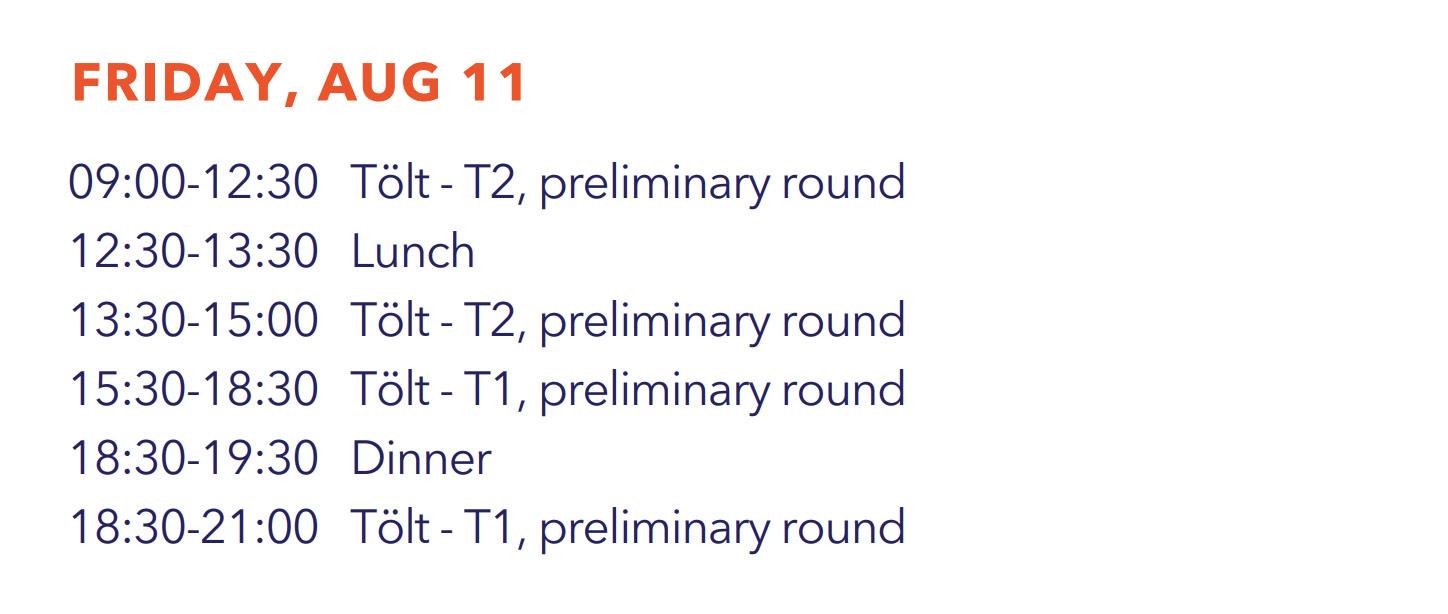





THE
NETHERLANDS | National team at the World Championship 2023

The Netherlands was one of the six member countries that founded FEIF in 1969.
The first gold medal was won at the European Championship in 1975. Janneke Faber won it riding Léttir frá Innrihólmi in Mehrgang 4/5 gait. In total the Netherlands have won six gold medals, the latest in 2013 in PP1. Sigurður Marinusson won it riding Atli frá Norður-Hvammi. He was defending his title from 2011 also in PP1 then riding Eilimi vom Lindenhof.
The Netherlands are this year’s host - hosting the 26th Championship and the 16th World Championship. This is the fifth time that the Netherlands host a Championship and the third time it’s held in Oirschot.

Competing for the Netherlands at this World Championship are six adults and six young adults. In the team is Cora Wijmans, 79 years old, riding her mare Remba frá Skógi and they are registered in all the pace disciplines.

82 | Eiðfaxi International The Teams at the World Championship in 2023
Photo: NSIJP
Anne-Lene van Engelen
Age: 36 | 2nd WC
Fákur frá Mið-Fossum
Age: 12 | Stallion
F: Fláki frá Blesastöðum 1A
M:Birta frá Mið-Fossum
Disciplines & best score:
Five-gait F1: 7.10
Christa Rike
Age: 24 | 4th WC
Barón frá Waldthorst
Age: 13 | Stallion
F: Ísar frá Keldudal
M: Hít frá Saltvík
Disciplines & best score:
Fivegait F1: 6.87
Tölt T1
Pace test PP1
Cora Wijmans
Age: 79 | 1st WC
Remba frá Skógi
Age: 16 | Mare
F: Depill frá Votmúla 1
M: Eldey frá Oddhóli
Disciplines & best score:
Pace 100 m. P2: 8,05”
Pace 250 m. P1: 25,07”
Pace test PP1: 7.42
Marit Scheen
1st WC
Týr vom Schloßberg
Age: 16 | Stallion
F: Trúr frá Wetsinghe
M:Kolfinna frá Egilsstaðabæ
Disciplines & best score:
Tölt T2: 7.20
Four-gait V1: 6.23
Reserve: Anne-Lene van Engelen riding Rökkvi frá Vatnshömrum and Esmee Versteeg riding Svartur vom Maischeiderland






Marjolein
Strikkers
6th WC
Spjót frá Fitjum
Age: 22 | Mare
F: Hávarður frá Hávarðarkoti
M: Spurning frá Flugumýri
Disciplines & best score:
Pace 100 m. P2: 7.78”
Pace 250 m. P1: 22.63”
Valerie Helvoort-Kortrijk

Age: 50 | 1st WC
Glymjandi frá Íbishóli
Age: 12 | Gelding
F: Dynjandi frá Íbishóli
M: Salka frá Tumabrekku
Disciplines & best score:
Tölt T2: 7.40
Four-gait V1:
Eiðfaxi International | 83
Mynd: Henk Peterse
Mynd: Henk Peterse
Mynd: Henk Peterse
Dromelot van Helvoort
Age: 17 | 1st WC
Rokkur f. Ytra-Vallholti
Age: 12 | Gelding
F: Hvinur frá Blönduósi
M: Brynja frá Ytra-Vallholti
Disciplines & best score: Tölt T1: 7.07
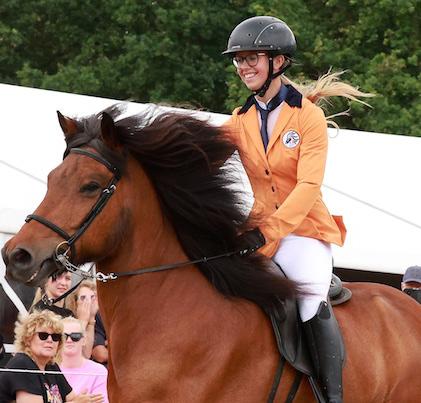
Four-gait V1: 6.80
Esmee Versteeg
Age: 21 | 2nd WC
Hugur Vestra-Fíflholti
Age: 14 | Gelding
F: Tindur frá Heiði
M: Hula frá Vestra-Fíflholti
Disciplines & best score: Tölt T1: 7.28
Freya Spee
Age: 19 | 1st WC
Djorn frá Nýttland
Age: 13 | Gelding
F: Surtur frá Wetsinghe
M: Diljá frá Nýttland
Disciplines & best score: Tölt T2: 7.00

Iris Wijker
Age: 16 | 1st WC
Fáni frá Waldthorst
Age: 11 | Stallion
F: Viktor fra Diisa
M: Lýsa från Håkansgården
Disciplines & best score:
Four-gait V1: 6.57
Tölt T1
GOLD MEDALS

2013 PP1 Sigurður Marínus. Atli frá Norður-Hvammi
Julie Klomp
Age: 18 | 1st WC
Ofsi frá Wyler
Age: 12 | Gelding




F: Keilir frá Miðsitju
M: Ör von Laeisenhof
Disciplines & best score:
Five-gait F1: 6.37
Tölt T2: 6.63
Pace 100 m. P2
Photo: Vera van Praag
Lisa Leereveld
Age: 20 | 2nd WC
Tindra von Hof Gladur
Age: 13 | Gelding
F: Glaður frá Hólabaki
M: Táta vom gelben Berg
Disciplines & best score:
Tölt T2: 7.03
Four-gait V1:
2011 PP1 Sigurður Marínus. Eilimi vom Lindenhof
1995 D Carla von Nunen Byr Schloss Neubronn
1987 CC Carla von Nunen Fróði frá Breidablik
1979 CC Jeanette Vring Kópur frá Hólmi
1975 MX Janneke Faber Léttir frá Innrihólmi
84 | Eiðfaxi International
YOUNG ADULTS:

AUSTRIA | National team at the World Championship 2023

Austria was one of six member countries that founded FEIF in 1969. Austria has participated in the European Championships and the World Championships from the start in 1970 and has hosted the event four times.

The first gold medal was won in 1979. Johannes Hoyos riding Ljóri frá Eiríksstöðum had the same time as Ragnar Hinriksson riding Fróði frá Ásgeirsbrekku and Barla Barandun riding Víkingur in the pace race. Since then Austria has won nine gold medals but it has been 24 years since they have won one. The last one was won in 1999 by Höskuldur Aðalsteinsson riding Ketill frá Glæsibæ in pace test. Most gold medals were won in 1991, three in total; tölt T2, dressage and combination.
Competing for Austria at this World Championship are seven seniors and five young adults. Trainer is Hinrik Bragason and team leader is Susanne Jelinski

86 | Eiðfaxi International
Anna-Lisa Zingsheim
Age: 31 | 2nd WC
Örn frá Brimnesi
Age: 13 | Stallion
F: Spuni frá Vesturkoti
M: Karfla frá Brimnesi
Disciplines & best score:
250 m. pace P1: 23.34”
100 m. pace P2: 7.78”
Pace test PP1: 7.50
Carina Piber
Age: 35 | 7th WC
Milljarður f. Stóra-Aðalsk.
Age: 7 | Stallion
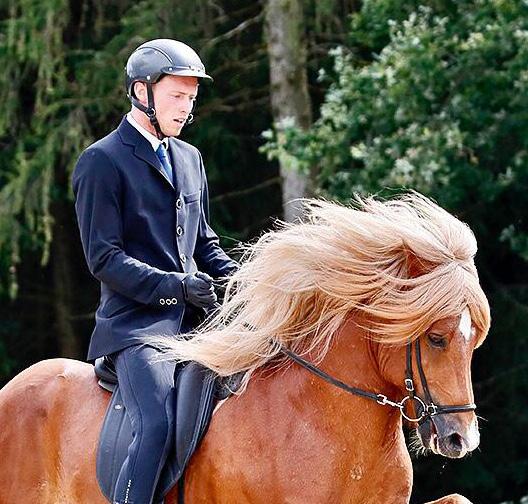

F: Aðall frá Nýjabæ
M: Perla frá Neðra-Skarði
Disciplines & best score:
Fivegait F1: 7.20
Pace test PP1: 6.29
Tölt T1
Gerrit Sager
5th WC | 1 title
Kveikur frá Hrísdal
Age: 10 | Gelding
F: Frakkur frá Langholti
M: Glóð frá Kýrholti
Disciplines & best score: Tölt T2: 7.97
Helga Hochstöger
Age: 48 | 2nd WC
Nóri von Oed
Age: 15 | Gelding
F: Nasi vom Auenthal
M: Máría frá Miklaholtsseli
Disciplines & best score:
Pace 100 m. P2: 7.55”
Pace 250 m. P1: 22.83”
Pace test PP1: 8.50
Reserve: Daniela Sasse riding Klassi frá Atnarstaðakoti, Gerrit Sager riding Baron frá Bala 1 and Johanna Kirchmayr riding Kolfreyja fra Rørvik




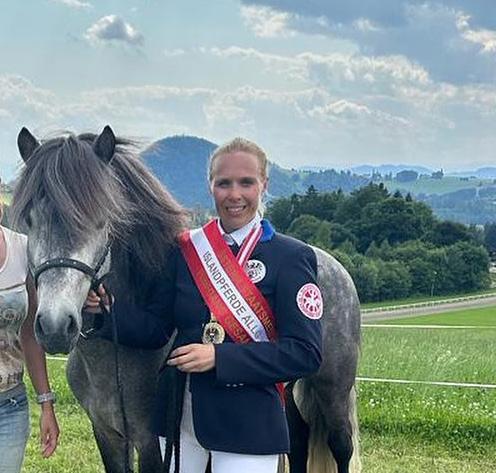
Petra Gastl
Age: 36 | 1st WC
Höfði frá Húsavík
Age: 9 | Stallion
F: Korgur frá Ingólfshvoli
M: Hrauna frá Húsavík
Disciplines & best score:
Tölt T1: 7.00
Fourgait V1: 7.20
Pierre Sandsten Hoyos
Age: 25 | 4th WC | 1 title YR
Búi frá Húsavík
Age: 15 | Stallion
F: Hróður frá Refsstöðum
M: Dúsa frá Húsavík
Disciplines & best score:
Fivegait F1: 7.87
Piet Hoyos
20th WC
Brynjar frá Bakkakoti
Age: 12 | Stallion
F: Frakkur frá Langholti
M: Smella frá Bakkakoti
Disciplines & best score:
Fivegait F1: 7.73
Tölt T2: 7.63
Pace test PP1
Eiðfaxi International | 87
YOUNG ADULTS:
Johanna Osterkorn
Age: 17 | 1st WC
Björt frá Bitru
Age: 15 | Mare
F: Aðall frá Nýjabæ
M: Dúkka frá Laugavöllum
Disciplines & best score:
Pace test PP1: 6.58
Pace 250 m. P1: 24,38”
Pace 100 m. P2: 8,36”
Alma Brandstätter
Age: 15 | 1st WC
Frigg frá Austurási
Age: 14 | Mare
F: Rammi frá Búlandi
M: Glíma frá Sauðhaga 2
Disciplines & best score:
Five-gait F1: 6.37
Pace test PP1
Anna Sager
Christian Leitner
Age: 20 | 2nd WC
Steggur frá Hrísdal
Age: 14 | Stallion
F: Þristur frá Feti
M: Mánadís frá Margrétarhofi
Disciplines & best score:
Tölt T1: 8.28
Four-gait V1: 7.83
Krummi frá Höfðabakka
Age: 13 | Gelding



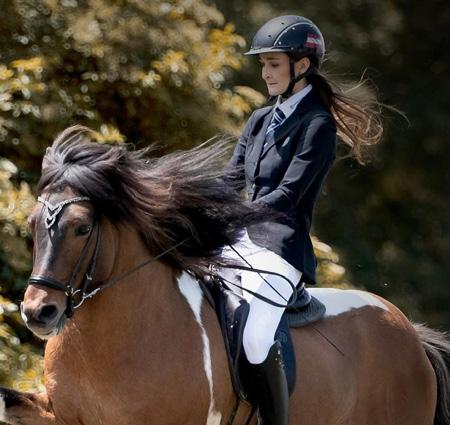

F: Sveinn-Hervar f. Þúfu í L.
M: Dagrún frá Höfðabakka
Disciplines & best score:
Tölt T2: 7.37
Four-gait V1
Lorraine Essl
Age: 17 | 1st WC
Silfurtoppur frá Tungu
Age: 14 | Gelding
F: Stimpill frá Vatni
M: Lotta frá Tungu
Disciplines & best score:
Fivegait F1: 6.40
Tölt T2: 6.90
Pace test PP1&Pace 100m.P2
GOLD MEDALS

1999 P1 Höskuldur AðalsteinsKetill frá Glæsibæ
1997 FS Doris Kainzbauer Kopar frá Hrepphólum
1995 FS Doris Kainzbauer Kopar frá Hrepphólum
1993 T2 Gerrit Schurl Kórak frá Neðri-Ási
1991 T2 Johannes Hoyos Fjölnir frá Kvíabekk
1991 FS Birgitta Karmus Tridi
1991 CX Johannes Hoyos Fjölnir frá Kvíabekk
1987 F1 Peter Schröder Asta vom Birkenheim
1985 CX Johannes Hoyos Fjölnir frá Kvíabekk
1979 P1 Johannes Hoyos Ljóri frá Eiríksstöðum
88 | Eiðfaxi International
2nd WC
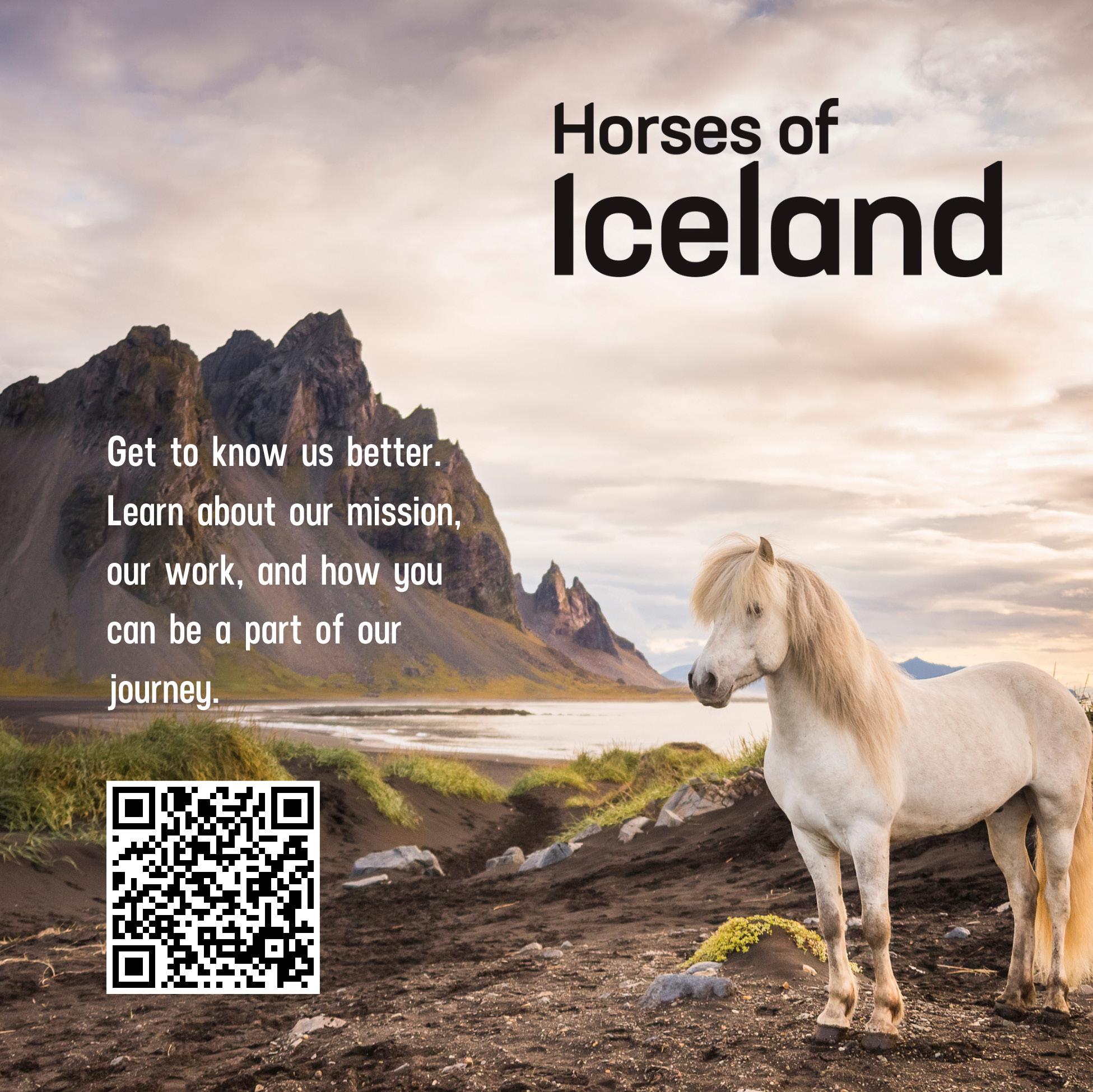
2023
Frans Goetschalckx
Age: 66 | 4th WC
Smellur f. Leysingjast.
Age: 22 | Gelding
F: Stígandi f. Leysingjastöðum II
M: Stjarna f. Leysingjastöðum II
Disciplines & best score:
Tölt T2: 6.67
YOUNG ADULTS:
Jin Van Werven
Age: 24 | 3rd WC
Kolbeinn f. Jespersgaarde
Age: 15 | Stallion
F: Sleipnir fra Moselundgård
M: Erla frá Akurgerði
Disciplines & best score:
Tölt T2: 7.47
Four-gait V1: 6.90
Nelly Himschoot
Age: 32 | 1st WC
Hrönn vom Hochwaldhof
Age: 13 | Mare
F: Dollar frá Sperðli
M: Hrímfaxa vom Hochwaldhof
Disciplines & best score: Tölt T1: 6.50
Belgium joined FEIF in 1975 and participated in their first Championship in 1977. Belgian rider has never won a gold medal.


Competing for Belgium at the Championship in Holland are three adults and three young adults. Team leader for sport is Kristof Van Looy.


Emma Rottiers
Age: 20 | 1st WC
Kleópatra f Branstöðum
Age: 8 | Mare
F: Moli frá Skriðu
M: Kolgríma Tinnud.f Litla-Húsið
Disciplines & best score:
Tölt T1: 6.30
Four-gait V1: 6.03
Hebe Lise Lembrechts
Age: 15 | 1st WC
Skrýmir frá Wyler
Age: 17 | Gelding



F: Skorri frá Gunnarsholti
M: Sara frá Vestur-Meðalholtum
Disciplines & best score:
Tölt T2: 7.17
Four-gait V1: 6.50
Paulien Rottiers
Age: 17 | 1st WC
Baldvin frá Sunnuholti
Age: 11 | Stallion
F: Óskar frá Blesastöðum 1A
M: Birta frá Sauðadalsá
Disciplines & best score: Four-gait V1: 6.60
90 | Eiðfaxi International The Teams at the World Championship in 2023
BELGIUM | National team at the World Championship
Photo: Henk Peterse
Photo: Henk Peterse




Eiðfaxi International LANDSMÓT HESTAMANNA REYKJAVÍK 1.-7. JÚLÍ 2024
AVAILABLE AT TIX.IS landsmothestamanna landsmotreykjavik www.landsmot.is
TICKETS
Julie Louise Christiansen
Age: 46 | 9th WC | 3 titles
“I had a major riding accident in 2015 where I hit my head quite a bit. It helps a lot with sunglasses. That’s why people almost always see me with sunglasses on”
Felix f Blesastöðum 1A
Age: 12 | Gelding
F: Fláki frá Blesastöðum 1A
M: Fjallarós frá Litlalandi Ásahr.
Disciplines & best score:
Tölt T2: 8.33
Fourgait V1: 7.63
Jon Stenild
Age: 40 | 3rd WC | 1 title
“My goal for the WC is to stay true to my training approach and enjoy the days in Holland together with Eilífur and my supporting family”
Eilífur fra Teglborg
Age: 13 | Stallion
F: Hamur frá Blesastöðum 2
M: Pen fra Langtved
Disciplines & best score: Fivegait F1: 8.00
Denmark was one of six member countries that founded FEIF in 1969. Denmark has participated in the European Championships and the World Championships from the start in 1970.


The first gold medal was won in 1985 but at that tournament members of the Danish team won two gold medals. Dorte Rasmussen riding Blossi fra Endrup Hegn won the pace race and Lone Jensen riding Grani fra Nymindegab won the freestyle.


Since then Denmark has won ten gold medals, the latest in fivegait and tölt T2. Most gold medals were won in 2015, three in total; fivegait, tölt (YR) and fourgait combination (YR).
Competing for Denmark at this World Championship are nine seniors and five young adults. Trainer is Anton Páll Níelsson.
92 | Eiðfaxi International
DENMARK | National team at the World Championship 2023
Reigning World Champion F1
Reigning World Champion T2
Photo: Hejndorf foto
Sys Pilegaard
Age: 31 | 2nd WC
Abel fra Tyrevoldsdal
Age: 12 | Stallion
F: Oliver frá Kvistum
M: Drótt frá Oddhóli
Disciplines & best score:
Tölt T1: 8.93
Anne Frank Andresen
Age: 29 | 1st WC
Vökull frá Leirubakka
Age: 12 | Stallion
F: Héðinn frá Feti
M: Embla frá Árbakka
Disciplines & best score:
Fivegait F1: 7.40
Tölt T1: 7.03
Pace test: 7.13
Frederikke Stougård
Age: 28 | 4th WC
Austri frá Úlfsstöðum

Age: 14 | Stallion
F: Bragi frá Kópavogi
M: Sýn frá Söguey
Disciplines & best score:
Tölt T1: 8.43
Fourgait V1: 7.73
Natalie Fischer
Age: 24 | 1st WC
Ímnir fra Egeskov
Age: 14 | Gelding
F: Gaukur frá Innri-Skeljabrekku
M: Glóra frá Hofi
Disciplines & best score:
Pace 100 m. P2: 7.31”
Pace 250 m. P1: 21.90”
Reserve: Charlotte Cook and Gæfa frá Bessastöðum and Duld frá Ytra-Dalsgerði. Alberte Smith and Arnar from Store Skovgaard. Young rider: Júlía Guðmundsdóttir and Baldi frá Feti.






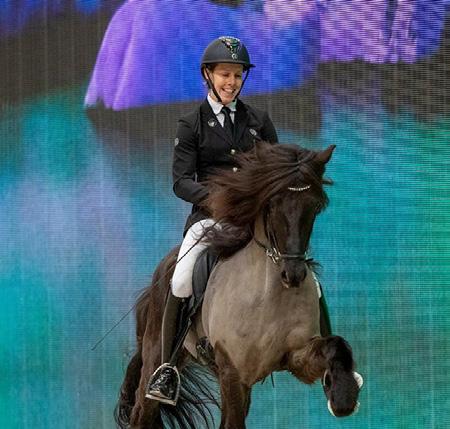
Dennis Hedebo Johansen
Age: 40 | 4th WC
Muni fra Bendstrup
Age: 14 | Stallion
F: Tenór frá Auðsholtshjáleigu
M: Minning fra Bendstrup
Disciplines & best score:
Tölt T1: 8.23
Fourgait V1: 7.83
Steffi Svendsen
Age: 46 | 6th WC
Saga from Teland
Age: 8 | Mare
F: Sævar fra Teland
M: Sara fra Teland
Disciplines & best score:
Pace test PP1: 8.17
Five-gait F1 & Tölt T1
Søren Madsen
Age: 36 | 5th WC
Skinfaxi from Lysholm
Age: 11 | Stallion
F: Kiljan frá Steinnesi
M: Sæla frá Þóreyjarnúpi
Disciplines & best score:
Fivegait F1: 7.47
Tölt T1: 7.27
Pace test PP1: 7.79
Pace 250 m. 23.61”
Pace 100 m. 8.14”
Eiðfaxi International | 93
YOUNG ADULTS:
Signe Kaavé
Reynir f. Margrétarhofi
Age: 11 | Stallion
F: Þrumufleygur frá Álfhólum
M: Askja frá Margrétarhofi
Disciplines & best score:
Tölt T1: 6.80
Fourgait V1: 6.03
Amanda Frandsen
Age: 18 | 1st WC
Tinna frá Litlalandi
Age: 8 | Mare
F: Hringur frá Gunnarsstöðum I
M: Vaka frá Tungu
Disciplines & best score:
Tölt T1: 6.70
Fourgait V1: 7.00
Molly Emilie Ejlersen
Freja Løvgreen
Age: 19 | 1st WC
Meyvant frá Feti
Age: 17 | Stallion
F: Hnokki frá Fellskoti
M: Papey frá Dalsmynni
Disciplines & best score: Tölt T2: 7.17




Fjölvi fra Hedegaard
Age: 16 | Gelding

F: Geisli frá Reykjavík
M: Náttfreyja fra Hedegaard
Disciplines & best score:
Pace 100 m. P2: 7.99”
Pace 250 m. P1: 23.11”
Pace test PP1: 6.29
Rebecca H. Taulborg
Age: 17 | 1st WC
Tindra f. Kirstineholm
Age: 8 | Mare
F: Tónn frá Ólafsbergi
M: Hylling frá Votmúla 2
Disciplines & best score:
Pace test PP1: 7.50
Pace 100 m. P2: 7.73”
Fivegait F1: 6.57
Tölt T1: 6.07
GOLD MEDALS

2019 T2 Julie Christiansen Stormur frá Hemlu I
2019 F1 Jón Stenild Eilífur fra Teglborg
2015 F1 Julie Christiansen Hugur f. Flugumýri II
2015 T1(YR) Caroline Poulsen Helgi frá Stafholti
2015 C4(YR) Caroline Poulsen Helgi frá Stafholti
2013 T2 Julie Christiansen Straumur f. Seljabrekku
2011 P2 Tania Højvang Olsen Sólon fra Strø
2009 P2 Tania Højvang Olsen Sólon fra Strø
2001 T2 Anne Balslev Hrammur f. Þóreyjarn.
1995 P1 Rikke Jensen Baldur frá Sandhólar
1985 P1 Dorte Rasmussen Blossi fra Endrup Hegn
1985 FS Lone Jensen Grani fra Nymindgab
94 | Eiðfaxi International
1st WC
1st WC
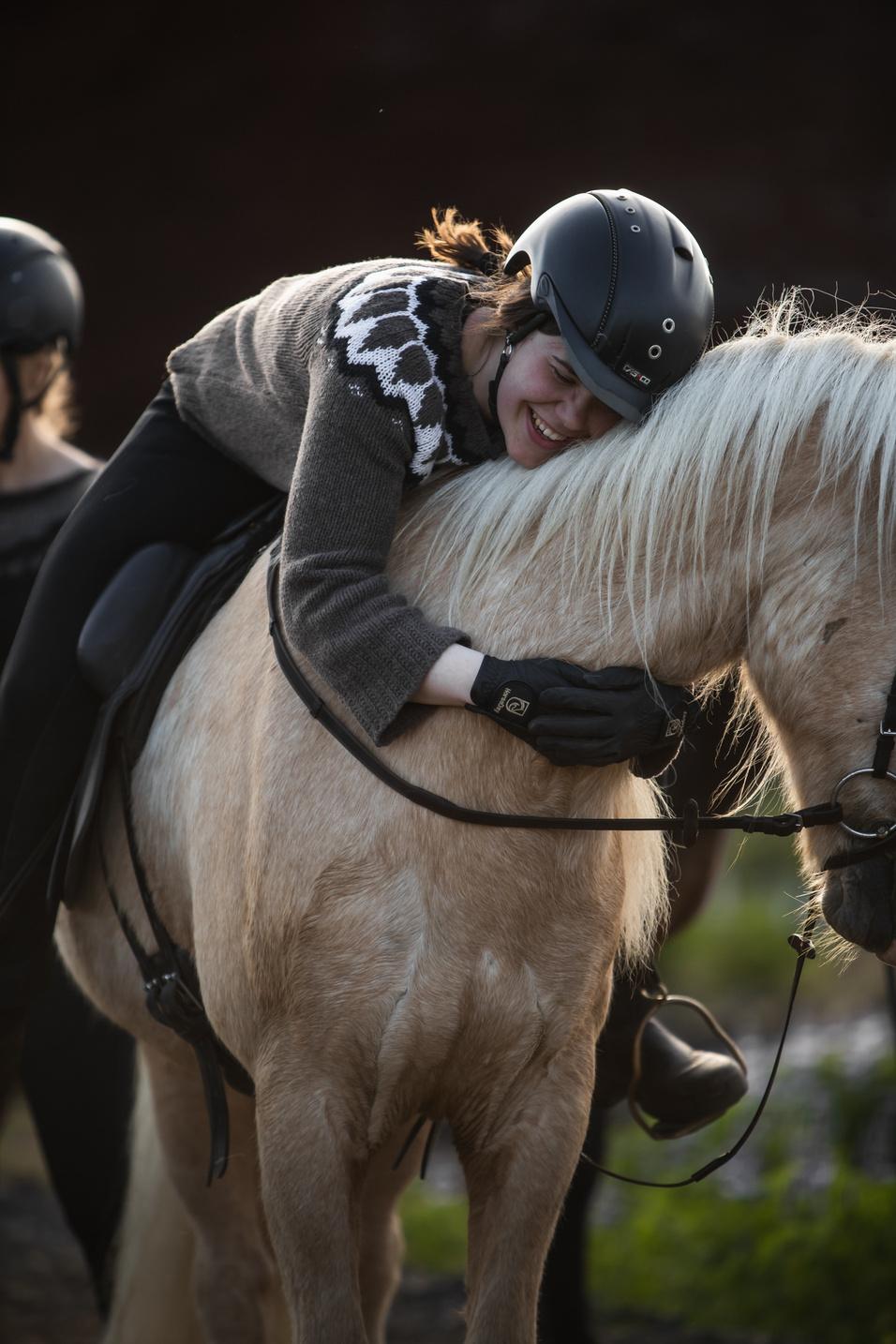




Distance Sessions Time
FAROE ISLANDS | National team at the World Championship 2023


Óskar frá Breiðstöðum
Age: 12 | Stallion
F: Herjólfur Ragnheiðarstöðum
M: Fantasía frá Breiðstöðum
Elin V. Tindskard
Age: 40 | 5th WC
Disciplines & best score:
Tölt T2: 7.70
Four-gait V1: 6.77
Knút A. Svabo Lützen
Age: 55 | 1st WC
Kári frá Ásbrú
Age: 13 | Gelding

F: Kappi frá Kommu
M: Samba frá Miðsitju
Disciplines & best score:
Tölt T1: 8.11
Four-gait V1: 7.30
Age: 16 | 1st WC
Bertha Maria Davidsd.
Age: 19 | 1st WC
Kopar frá Hrauni
Ester Dahl á Heygum
Age: 17 | 1st WC
Dalvar frá Dalbæ II
In 1991 the Faroe Islands joined FEIF and they participated at their first Championship in 1993 in Spaarnwoude in the Netherlands. Then they sent one rider to compete. At this Championship five riders will participate, two aults and three young adulrs. Team leader is Sedea Bjarnadottir Nolsø.

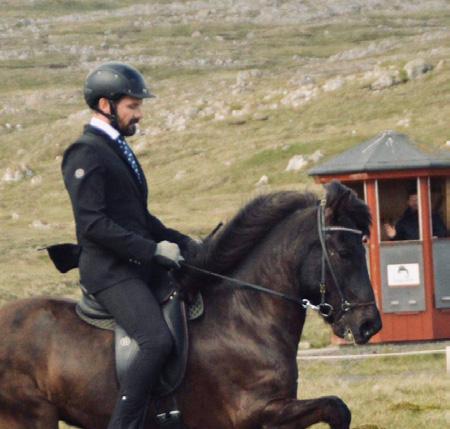

Age: 11 | Stallion
F: Viktor fra Diisa
M: Nona frá Mosfelli
Disciplines & best score:
Tölt T1: 7.43
Fourgait V1
Age: 12 | Gelding

F: Möller frá Blesastöðum 1A
M: Könnun frá Kirkjubæ
Disciplines & best score:
Tölt T1: 6.70
Fourgait V1: 6.47
Age: 13 | Stallion
F: Fálki frá Geirshlíð
M: Bón frá Leysingjastöðum II
Disciplines & best score:
Five-gait F1: 6.57
Pace test PP1 - Tölt T1
Pace race 100 m. P2
96 | Eiðfaxi International The Teams at the World Championship in 2023
Sílas vom Forstwald
Rakel Brattalid Tindskard
YOUNG ADULTS:







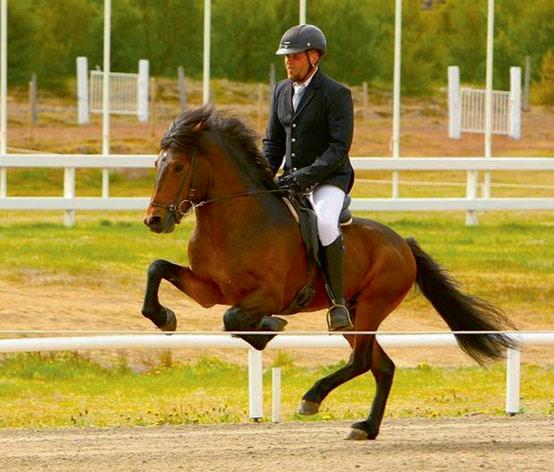
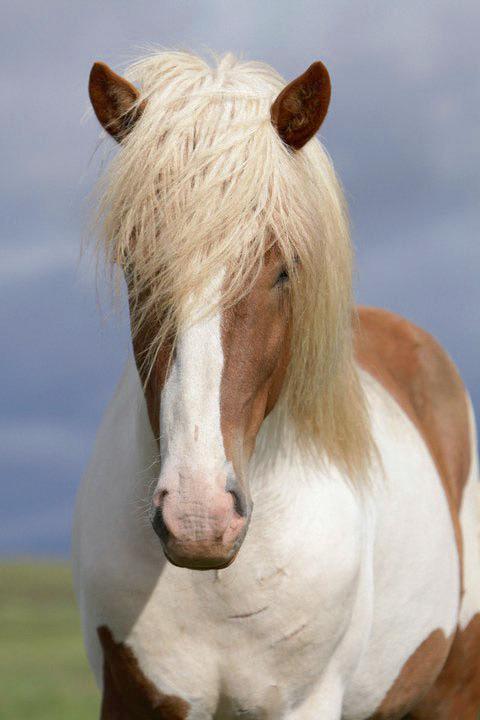



Finndu okkur á facebook HROSSARÆKTARBÚ
FINLAND | National team at the World Championship 2023

Finland joins FEIF in 1983 and participated in their first Championship in 1987. At that Championship Satu Paul riding Eitill frá Hnausum ended in 4th place in cross-country. In 1989 they ended up winning that discipline and winning the first and only gold medal Finland has received at these Championships. Satu and Eitill are one of Finland’s most successful pairs at the Championships. Competing for Finland at this World Championship are seven adults and three young adults. A fun fact - Katie Sundin Brumpton is riding Depill från Fögruhlíð who is the son of Smári från Askagården but Katie and Smári ended in 3rd place in tölt T1 at the WC2015. Best result of Finland in tölt T1.
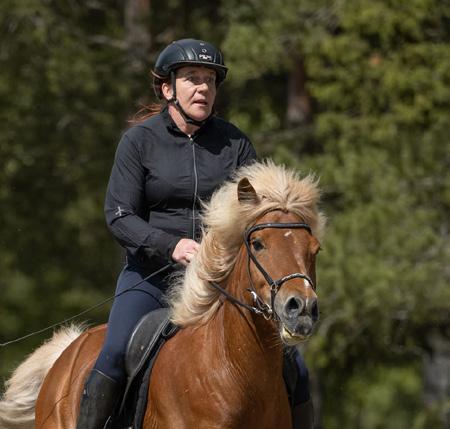

Annika Kyrklund
4th WC
Flipi frá Haukholtum
Age: 18 | Gelding


F: Rökkvi frá Hárlaugsstöðum
M: Fjöður frá Haukholtum
Disciplines & best score:
Pace 100 m. P2: 8,47”
Pace 250 m. P1: 24,32”
Pace test PP1
Arnór Dan Kristinsson
Age: 25 | 1st WC
Vegur frá Kagaðarhóli
Age: 13 | Stallion

F: Seiður frá Flugumýri II
M: Ópera frá Dvergsstöðum
Disciplines & best score:
Fivegait F1: 6.77
Tölt T1: 7.03
Pace test:
Julia Wejberg
Age: 39 | 1st WC
Tjaldari fra Heimnesi
Age: 11 | Stallion
F: Thrymur från Järsta
M: Tjáning frá Grafarkoti
Disciplines & best score:
Tölt T2: 6.80
Katie Sundin Brumpton
Age: 33 | 8th WC
Depill från Fögruhlíð
Age: 11 | Stallion
F: Smári från Askagården
M: Aleiga från Ekeby
Disciplines & best score:
Tölt T1:
Four-gait V1:7.43
Photo: Johanna Vaurio-Teräväinen.
Reserve: Katie Sundin Brumpton riding

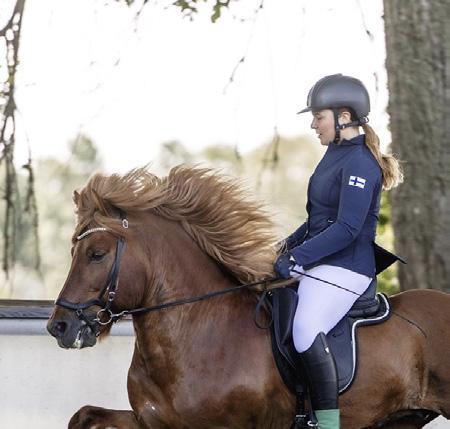

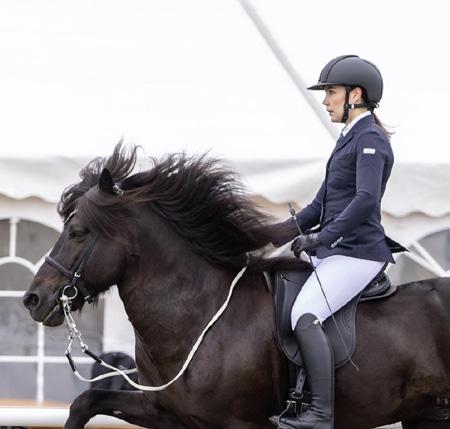

Salvar frá Klukku, Veera Niemi riding

Steina fra Kaakkola and Veera Sirén riding
Jarl frá Mið-Fossum.
Laura Nyström
Age: 28 | 1st WC
Gilda fra Stenkullagård
Age: 10 | Mare
F: Hraunar frá Austurkoti
M: Lúna fra Stenkullagård
Disciplines & best score:
Five-gait F1: 6.40
Tölt T1, Pace test PP1 & Pace 100 m. P1
YOUNG ADULTS:
Maija Hahlin
Age: 72 | 1st WC
Darri frá Hjarðartúni
Age: 14 | Stallion
F: Hnokki frá Fellskoti
M: Dögg frá Breiðholti, Gbr.
Disciplines & best score:
Tölt T2: 6.90
Veera Sirén
Age: 26 | 5th WC
Viktor frá Reykjavík
Age: 8 | Stallion
F: Sveinn-Hervar f. Þúfu í Land.

M: Fortíð frá Kastalabrekku
Disciplines & best score:
Tölt T2: 7.20
Four-gait V1
GOLD MEDAL

1989 CC Satu Paul Eitill frá Hnausum
Gerda-Eerika Viinanen
Age: 20 | 2nd WC
Svala frá Minni-Borg
Age: 19 | Mare
F: Glóðar frá Reykjavík
M: Svanhildur frá Minni-Borg
Disciplines & best score:
Pace 250 m. P1: 23,35”
Pace 100 m. P2: ,68”
Pace test PP1: 7.04
Miina Sarsama
Age: 18 | 1st WC
Freir fra Kaakkola
Age: 14 | Stallion
F: Röðull frá Holtsmúla 1
M: Freyja fra Terriniemi
Disciplines & best score:
Tölt T1: 6.87
Four-gait V1: 6.83
Veera Niemi
Age: 19 | 1st WC
Hekla fra Víðarbrekku
Age: 17 | Mare
F: Hrynjandi fra Fageräng
M: Katla frá Jórvík 2
Disciplines & best score:
Pace 250 m. P1: 24,26”
Pace 100 m. P2: 8,57”
Pace test PP1: 5.46
FRANCE | National team at the World Championship 2023

Berglind I. Árnadóttir
Age: 49 | 2nd WC
Kurr frá Koltursey
Age: 11 | Stallion
F: Stáli frá Kjarri
M: Fjöður frá Gamla-Hrauni
Disciplines & best score:
Tölt T1: 6.80
Four-gait V1: 6.40
Julie Darbon
Age: 23 | 1st WC
Byrnir frá Vorsabæ II
Age: 13 | Stallion
F: Stirnir frá Vorsabæ II
M: Nös frá Vorsabæ II
Disciplines & best score:
Tölt T2: 7.00
Four-gait V1: 6.33
Rauðhetta f. Þúfu í Kjós
Age: 14 | Stallion
F: Herkúles f. Ragnheiðarst.
M: Þyrnirós frá Þúfu í Kjós
Elías Þórhallsson
Age: 53 | 2nd WC
Disciplines & best score:
Tölt T1: 7.27
Fourgait V1: 7.07
Mathieu Dischinger
Age: 58 | 4th WC
Gustur frá Yztafelli
Age: 12 | Gelding

F: Seiður frá Flugumýri II
M: Salvör frá Búlandi
Disciplines & best score: Tölt T1: 6.07
Fourgait V1: 6.13
Pascale Kugler
Age: 57 | 6th WC
Herjólfur f.Ragnheiðarst.
Age: 17 | Stallion
F: Gígjar frá Auðsholtshjáleigu
M: Hending frá Úlfsstöðum
Disciplines & best score:

Tölt T1: 7.50
Four-gait V1
France joins FEIF in 1971 but they didn’t participate at the Championships until 1975 in Semriach, Austria. There France placed third in the dressage B competition. The only gold medal that France has won was in 1977 and it was Martin Dischinger riding Kópur frá Velli who won the cross-country. France placed 4th in four-gait at EC in 1989 and again at the WC in 1991. At that same Championship France placed 8th and 9th in tölt T1.



At this Championship five riders will participate. Team leader is Nadia des Courtis and trainer is Andrea WeissBalz

100 | Eiðfaxi International The Teams at the World Championship in 2023
GOLD MEDAL
1977 CC Martin Dischinger Kópur frá Velli


Reigning WC in T1, V1 & C4 YR
Franziska Müser
Age: 24 | 2nd WC | 3 titles YR
Spá frá Kvistum
Age: 11 | Mare
F: Spuni frá Vesturkoti
M: Frigg frá Heiði
Disciplines & best score:
Five-gait F1: 7.0
Tölt T2
Reigning WC in P2 YR
Helen Klaas
Age: 24 | 2nd WC | 1 title YR
“I mean he is an amazing tölt horse and always ready to work. But his true passion is eating. I have never met a horse who loves eating so much.”
Kolgrímur vom Neddernhof
Age: 17 | Stallion
F: Kopernikus vom Heesberg
M: Bylgja vom Neddernhof
Disciplines & best score: Tölt T2: 7.40
Four-gait V1
Germany was one of six member countries that founded FEIF in 1969 and has participated in the Championships from the start in 1970.
Germany is the 2nd most successful nation winning a total of 79 gold medals. Their golden years were from 1970 - 1995 where riders like Walter Feldmann, Bruno Podlech, Bernd Vith, Andreas Trappe and Jolly Schrenk won multiple golds. In 2011 Germany won no gold medals for the first time and that maybe gave them the boost they needed because in the last four Championships they have won 4, 4, 7 and 5 gold medals. Where young riders have played a big part but last Championship all gold medals were won by young adults.

Representing Germany this year are seven adult riders and seven young adults. Team leader is Marlise Grimm and Olil Amble is the trainer.



102 | Eiðfaxi International
GERMANY | National team at the World Championship 2023
Photo: Neddens
Alexander Fedorov
Age: 27 | 1st WC
Hrólfur frá Hafnarfirði
Age: 20 | Gelding
F: Toppur frá Eyjólfsstöðum
M: Hrönn frá Ytri-Reykjum
Disciplines & best score:
Pace 250 m. P1: 21,52”
Pace 100 m. P2: 7,46”
Pace test PP1: 7.42
Daniel C. Schulz
Age: 46 | 1st WC
Spuni vom Heesberg
Age: 16 | Gelding
F: Glotti frá Sveinatungu
M: Mýra frá Hallkelsstaðahlíð
Disciplines & best score: Tölt T2: 8.73
Frauke Schenzel
Age: 37 | 10th WC | 2 titles
Jódís vom Kronshof
Age: 12 | Mare
F: Viktor fra Diisa
M: Næpa vom Kronshof
Disciplines & best score: Tölt T1: 8.37
Four-gait V1: 8.17
Laura Enderes
Age: 34 | 1st WC
Fannar von der Elschenau
Age: 13 | Gelding
F: Hritur vom Schloßberg

M: Fluga frá Hvolsvelli
Disciplines & best score:
Pace 100 m. P2: 7,56”
Pace test PP1: 8.79
Reserve: Frauke Schenzel riding Óðinn vom Habichtswald and Celina Probst riding Mjölnir vom Lipperthof.

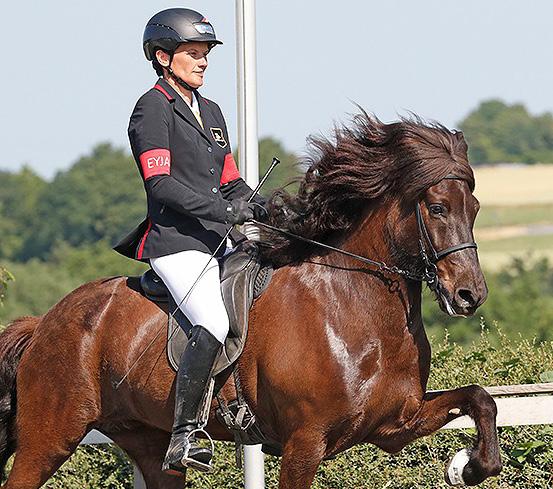


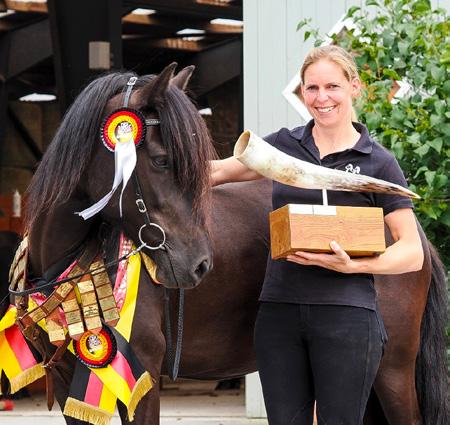


Lisa Schürger
Age: 33 | 4th WC
Kjalar f. Strandarhjáleigu
Age: 17 | Gelding
F: Borgar frá Strandarhjáleigu
M: Lukka frá Hvolsvelli
Disciplines & best score:
Tölt T1: 8.43
Four-gait V1: 7.63
Susanne Birgisson
Age: 45 | 1st WC
Króna von der Hartmühle
Age: 9 | Mare
F: Grímur frá Efsta-Seli
M: Píla von Ellenbach
Disciplines & best score:
Tölt T2: 8.43
Four-gait V1: 7.63
Vicky Eggertsson
6th WC
Gandur vom Sperlinghof
Age: 13 | Stallion
F: Atli frá Norður-Hvammi
M: Gnótt frá Árbæ
Disciplines & best score:
Five-gait F1: 7.77
Tölt T2: 7.93
Pace test PP1
Eiðfaxi International | 103
YOUNG ADULTS:
Nina Kesenheimer
Age: 20 | 1st WC
Krummi vom Pekenberg
Age: 22 | Gelding



F: Kolskeggur frá Keldudal
M: Krumma vom Zippchen
Disciplines & best score:
Pace test PP1: 7.50
Pace 250 m. P1: 22,68”
Pace 100 m. P2: 7,68”
Finja Polenz
Age: 18 | 1st WC
Nótt vom Kronshof
Age: 8 | Mare
F: Teigur vom Kronshof
M: Rökkva vom Eschental
Disciplines & best score:
Five-gait F1: 6.93
Tölt T2:7.13
Lena Becker
Age: 21 | 1st WC
Bikar frá Ytra-Vallholti
Age: 12 | Stallion

F: Blysfari frá Fremra-Hálsi
M: Gáta frá Ytra-Vallholti
Disciplines & best score: Tölt T2: 7.13

Four-gait V1:
Lisa S. O. Stühring
Age: 18 | 1st WC
Elja vom Hollerbusch
Age: 15 | Mare
F: Bokki frá Akureyri
M: Eldey vom Störtal
Disciplines & best score:
Pace 250 m. P1: 23,16”
Pace 100m. P2: 8,04”
Pace test PP1: 6.83
Sophia Henke
Age: 21 | 1st WC
Hilmir (Omar) v. Forstwald
Age: 11 | Stallion
F: Naddur vom Schluensee
M: Föl vom Forstwald
Disciplines & best score:
Four-gait F1: 6.83
Tölt T2: 7.23
GOLD MEDALS

1970 T1 Walter Feldmann jr. Funi f. Kaupavangi
1970 V1 Walter Feldmann jr. Funi f. Kaupavangi
1970 F1 Walter Feldmann jr. Funi f. Kaupavangi
1970 DS Walter Feldmann jr. Funi f. Kaupavangi
1970 CX Walter Feldmann jr. Funi f. Kaupavangi
1972 T1 Bruno Podlech Stjarni frá Svignaskarði
1972 V1 Wolfgang Berg Gáski
1972 F1 Walter Feldmann jr. Funi f. Kaupavangi
1972 LR Joachim Berg Vafi
1972 CX Walter Feldmann jr. Funi f. Kaupavangi
1975 NT Walter Feldmann jr. Funi f. Kaupavangi
1975 MX Walter Feldmann jr. Funi f. Kaupavangi
1975 P1 Bruno Podlech Hreinn f Gullberast.
1975 DC Walter Feldmann jr. Funi f. Kaupavangi
1975 CC Walter Feldmann jr. Funi f. Kaupavangi
104 | Eiðfaxi International
Photo: Neddens
GOLD MEDALS
1975 CX Walter Feldmann jr. Funi f. Kaupavangi
1977 T1 Bernd Vith Fagri-Blakkur Hvít.
1977 V1 Bernd Vith Fagri-Blakkur Hvít.
1977 F1 Walter Feldmann jr. Eldjarn Langelandsg.
1977 D.3 Walter Feldmann jr. Eldjarn Langelandsg.
1977 CX Walter Feldmann jr. Eldjarn Langelandsg.
1979 T1 Christiane Mathies. Gammur f. Hofsst.
1979 V1 Bernd Vith Fagri-Blakkur Hvít.
1979 D.1 Walter Schmitz Baldur frá Stokkhólma
1979 D.3 Christiane Mathies. Gammur f. Hofsst.
1981 T1 Christiane Mathies. Gammur f. Hofsst.
1981 V1 Bernd Vith Fagri-Blakkur Hvít.
1981 F1 Walter Feldmann jr. Eldjarn Langelandsg.
1981 DS Walter Feldmann jr. Eldjarn Langelandsg.
1983 T1 Hans-Georg Gundl. Skolli v. Hestarhof
1983 V1 Hans-Georg Gundl. Skolli v. Hestarhof
1983 DS Walter Feldmann jr. Magnus v. Grenzland
1983 C5 Walter Feldmann jr. Magnus v. Grenzland
1985 T1 Wolfgang Berg Funi
1985 V1 Daniela Schmitz Seifur frá Kirkjubæ
GOLD MEDALS


2001 FS Karly Zingsheim Dökkvi frá Mosfelli
2003 T2 Silke Feuchthofen Hrafnkatla Mühlenbach
2005 T2 Silke Feuchthofen Hrafnkatla Mühlenbach
2007 T2 Jolly Schrenk Laxness vom Störtdal
2009 V1 Lena Trappe Vaskur vom Lindenhof
2013 V1 Frauke Schenzel Tígull vom Kronshof
2013 T2YR Charlotte Passau Uni vom Kronshof
2013 V1YR Johanna Beuk Merkur von Birkenlund
2013 C5YR Elisabeth K. Schaaf Njörður v. Schluensee
2015 P2 Helmut Bramesfeld Blöndal vom Störtal
2015 C4 Fohanna Tryggvas. Fönix frá Syðra-Holti
2015 T2YR Lucie Maxheimer Stjörn vom Eifelhaus
2015 F1YR Marvin Heinze Myrkvi vom Quillerhof
2017 V1 Jolly Schrenk Glæsir Gut Wertheim
2017 T2 Johanna Tryggvas. Fönix frá Syðra-Holti
2017 F1 Frauke Schenzel Gustur vom Kronshof

2017 C5 Johanna Tryggvas. Fönix frá Syðra-Holti
2017 T1YR Olivia Ritschel Alvar frá Stóra-Hofi
2017 C4YR Olivia Ritschel Alvar frá Stóra-Hofi
2017 C5YR Brynja S. Arnason Skuggi frá Hofi I
2019 T1YR Franziska Mueser Spölur frá Njarðvík
2019 V1YR Franziska Mueser Spölur frá Njarðvík
2019 C4YR Franziska Mueser Spölur frá Njarðvík
2019 F1YR Leonie Hoppe Fylkir vom Kranichtal
2019 P2YR Helen Klaas Víf van ´t Groote Veld
Örvar
C5 Karly Zingsheim Loftfari vom Basselthof 1989 T1 Bernd Vith Rauður vom Ellenbach 1989 V1 Sandra Feldmann Glampi Erbeldinger H. 1989 F1 Andreas Trappe Gnýr frá Blomli
Karly Zingsheim Loftfari vom Basselthof 1991 T1 Andreas Trappe Tyr vom Rappenhof 1991 V1 Andreas Trappe Tyr vom Rappenhof 1991 F1 Carina Heller Glaumur f. Sauðárkróki 1993 T1 Jolly Schrenk Ofeigur der Wegwarte 1993 V1 Jolly Schrenk Ofeigur der Wegwarte 1993 DS Sandra Feldmann Glampi Erbeldinger H.
T1 Jolly Schrenk Ofeigur der Wegwarte
V1 Jolly Schrenk Ofeigur der Wegwarte
1985 P1 Vera Reber Frosti Fárskrúðarbakka 1987 V1 Bernd Vith
1987 DS Helmut Lange Björt SchlossNeubronn 1987
1989 P1 Vera Reber Frosti Fárskrúðarbakka 1989 DS
1995
1995
Füchtensch. Mergur
Karly Zingsheim Feykir von Rinkscheid
FS Jolly Schrenk Ofeigur der Wegwarte
1995 T2 Gaby
Wendalinushof 1997 F1
1999
GREAT BRITAIN | National team at the World Championship 2023

Aidan Carson
3rd WC
Lukku-Láki f. Stenshult
Age: 11 | Stallion
F: Magnus fra Moselundgård
M: Aleiga från Stenshult
Disciplines & best score:
Five-gait F1: 6.60
Tölt T1 & Pace test PP1
Emilia Wogan
Age: 22 | 1st WC
Kolbeinn f. Efri-Rauðalæk
Age: 12 | Gelding
F: Hrímnir frá Ósi
M: Drottning frá Efri-Rauðalæk
Disciplines & best score:
Tölt T1: 6.3
Four-gait V1: 6.28
Britain joined FEIF in 1988 the same year as the USA. In all the years Britain has participated in the Championship it has only won one gold medal. That was in the year 2017. Charlotte Cook and Sæla frá Þóreyjarnúpi won the 100 m. pace. Riding with a unique style which resembles the one that jockeys in racing use.
Representing Britain this year are six adult riders and one young adult. Trainer is Baldvin Ari Guðlaugsson.

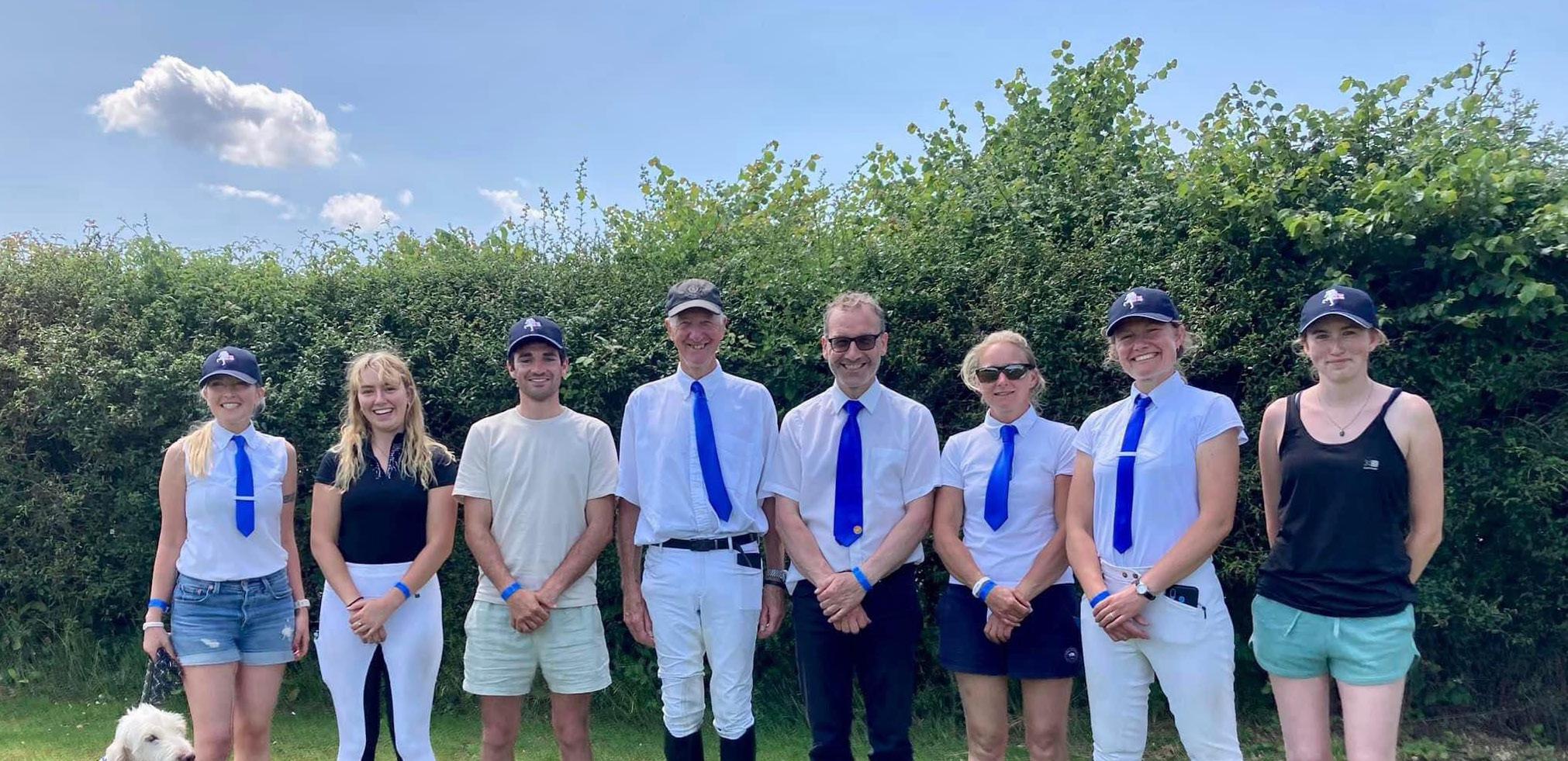
Reserve: Mike Adams riding Háfeti frá
Hurðarbaki

106 | Eiðfaxi International
Freija Glansdorp
Age: 40 | 2nd WC
Ljóri frá Efri-Rauðalæk
Age: 17 | Gelding
F: Krókur frá Efri-Rauðalæk
M: Laxdalsljóska frá Tungu
Disciplines & best score:
Tölt T2: 6.17
Five-gait F1: 6.13
Jemimah Adams
Age: 40 | 10th WC
Skírnir frá Skipaskaga
Age: 13 | Gelding
F: Gaumur frá Auðsholtshjáleigu

M: Sjöfn frá Akranesi
Disciplines & best score:
Tölt T2: 7.60
Four-gait V1: 7.30
Mike Adams
Nadine Kunkel
Rut frá Efri-Rauðalæk
Age: 8 | Mare
F: Klakinn frá Skagaströnd
M: Röst frá Efri-Rauðalæk
Disciplines & best score:
Pace test PP1: 6.42
Five-gait F1
Pace 100 m. P2
YOUNG ADULT:
Kjarkur f. Efri-Rauðalæk
Age: 13 | Gelding
F: Þristur frá Feti
M: Bylgja frá Efri-Rauðalæk
Disciplines & best score:
Tölt T2: 6.60
Four-gait V1
Tölt T1
Cristina Edwards
Age: 21 | 1st WC
Spuni frá Hnjúkahlíð
Age: 13 | Gelding


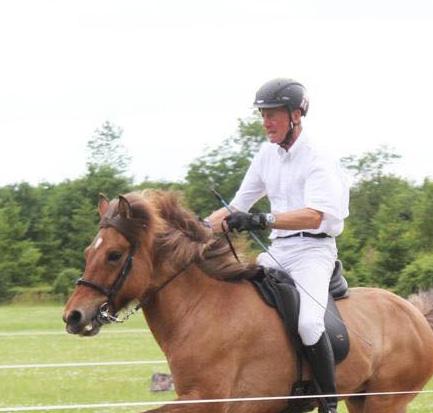

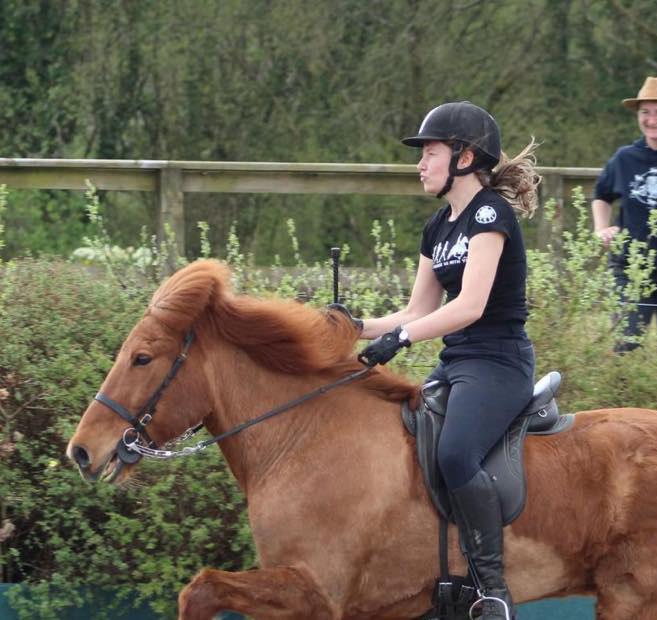
F: Akkur frá Brautarholti
M: Spurning frá Hólabaki
Disciplines & best score:
Four-gait V1: 6.00
Tölt T1
Eiðfaxi International | 107
12th WC
2nd WC
HUNGARY | National team at the World Championship 2023
Veronika Kremmer
Age: 37 | 1st WC
Ísbjörn vom Vindstaðir
Age: 17 | Stallion
F: Aris frá Akureyri
M: Ísing frá Oddhóli
Disciplines & best score: Tölt T1: 8.30
Hungary is the youngest member association within FEIF. Hungary joined in 2020 so this will be the first World Championship that we will see a Hungarian rider compete.


Jacqueline Schmid-Staub
Age: 51 | 3rd WC
Leiftur frá Lækjarbakka
Age: 10 | Stallion
F: Þrumufleygur frá Álfhólum
M: Spurning frá Sörlatungu
Disciplines & best score: Five-gait F1: 7.29
Nathalie Schmid
Age: 20 | 1st WC
Harpa frá Fellskoti
Age: 10 | Mare
F: Álfur frá Selfossi
M: Hnota frá Fellskoti
Disciplines & best score:
Tölt T1: 7.33
Italy joined FEIF in 1993. This time representing Italy is a mother and daugther duo competing at the World Championship. The family runs an Icelandic horse breeding farm in South Tyrol in Italy, Wiedenhof. Team leader is Elisabeth Wehl.
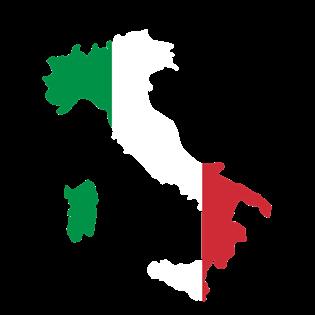

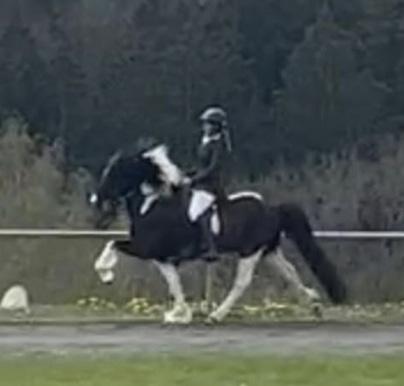


108 | Eiðfaxi International The Teams at the World Championship in 2023
ITALY | National team at the World Championship 2023

– Sumarfarm.is
Sumarliðabær
Teitur Árnason
Age: 32 | 4th WC | 2 titles
big, super fast and knows what she want’s. Our goal is to set a record”
Drottning frá Hömrum II
Age: 11 | Mare
F: Aron frá Strandarhöfði
M: Framtíð frá Hömrum II
Disciplines & best score: Pace 100 m. P2: 7,19”
Reigning World Champion PP1YR
Benjamín Sandur Ingólfsson
Age: 23 | 2nd WC | 1 title YR
The World Championship will be Benjamín’s and Júní’s first competition together.
Júní frá Brúnum
Age: 11 | Stallion

F: Hrannar frá Flugumýri II
M: Birta frá Brúnum
Disciplines & best score: Fivegait F1
Pace test PP1 Tölt T1.
Iceland was one of the six countries that founded FEIF in 1969. Iceland has participated in the European Championships and the World Championships from the start in 1970. The first gold medal was won in 1970 when Reynir Aðalsteinsson won the four-gait riding Stjarni frá Svignaskarði. Iceland is the most successful country in the history of the Championships with a total of 84 gold medals, five more than Germany which is next in line.
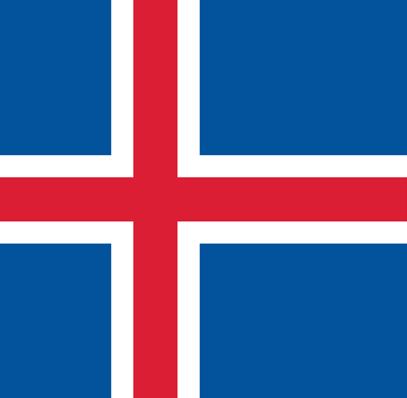
In the beginning Iceland was most successful in disciplines that involved pace but then became stronger in the four-gaited disciplines. Last Championship Iceland won seven gold medals and this year they aim for more.

Competing for Iceland at this World Championship are nine adults and five young adults. Trainer’s are Sigurbjörn Bárðarson and Hekla Katharína Kristinsdóttir.

110 | Eiðfaxi International
ICELAND | National team at the World Championship 2023
“Drottning is sensitive, really
Reigning World Champion in PP1
Daníel Gunnarsson
Age: 36 | 1st WC
Eining frá Einhamri 2
Age: 13 | Mare
F: Fróði frá Staðartungu
M: Björk frá Litla-Kambi
Disciplines & best score:
Pace 100m. P1: 7,50”
Pace 250m. P2: 21,76”
Elvar Þormarsson
Age: 42 | 2nd WC
Fjalladís Fornusöndum
Age: 9 | Mare
F: Spuni frá Vesturkoti
M: Svarta-Nótt frá Fornusöndum
Disciplines & best score:
Pace test PP1: 9.00
Pace 250 m. P2
Pace 100 m. P1
Hans
Þór Hilmarsson
Age: 40 | 1st WC
Jarl f. Þóroddsstöðum
Age: 14 | Gelding
F: Stáli frá Kjarri
M: Gunnur frá Þóroddsstöðum

Disciplines & best score:
Pace 100m. P1: 7,33”
Pace 250m. P2: 21,73”
Jóhanna M. Snorrad.
Age: 27 | 2nd WC
Bárður frá Melabergi
Age: 13 | Gelding

F: Héðinn frá Feti
M: Skrítla frá Grímstungu
Disciplines & best score:
Tölt T1: 8.90
Four-gait V1: 7.90
Reserve: Teitur Árnason riding Njörður frá






Feti. Daníel Gunnarsson was also a reserve but now he’s in the team.
Sara Sigurbjörnsdóttir
Age: 32 | 1st WC
Flóki frá Oddhóli
Age: 14 | Gelding
F: Ás frá Ármóti
M: Fía fra Oddhóli
Disciplines & best score:
Five-gait F1: 7.80
Viðar Ingólfsson
Age: 40 | 4th WC
Þór frá Stóra-Hofi
Age:10 | Stallion
F: Arion frá Eystra-Fróðholti
M: Örk frá Stóra-Hofi
Disciplines & best score:
Tölt T1: 8.40
Four-gait V1
Þorgeir Ólafsson
Age: 26 | 1st WC
Goðasteinn Haukagili , Hv.
Age: 8 | Stallion
F: Óskasteinn frá Íbishóli
M: Katla frá Steinnesi
Disciplines & best score:
Fivegait F1: 7.50
Tölt T2: 7.50
Pace test PP1: 7.33
Eiðfaxi International | 111
YOUNG ADULTS:
Jón Ársæll Bergmann
Age: 17 | 1st WC
Frár frá Sandhól
Age: 12 | Stallion
F: Loki frá Selfossi
M: Freyja frá Hafnarfirði
Disciplines & best score:
Tölt T1: 7.72
Four-gait V1: 7.87
Benedikt Ólafsson
Age: 20 | 1st WC
Leira-Björk Naustum III
Age: 16 | Mare

F: Tindur frá Varmalæk
M: Leira frá Syðstu-Grund
Disciplines & best score: Pace test PP1: 8.50
Five-gait F1, Pace 100m. P2 & Tölt T2
Glódís R Sigurðardóttir

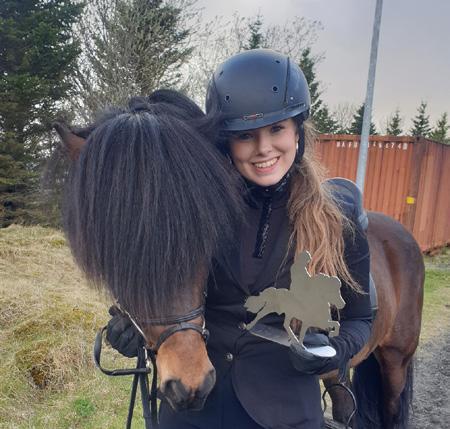

Age: 21 | 2nd WC
Salka frá Efri-Brú
Age: 7 | Mare
F: Vökull frá Efri-Brú
M: Vaka frá Efri-Brú
Disciplines & best score:
Five-gait F1: 7.30
Tölt T1
Herdís B. Jóhannsdóttir
Age: 17 | 1st WC
Kvarði frá Pulu
Age: 9 | Stallion
F: Barði frá Laugarbökkum
M: Kempa frá Austvaðsholti 1
Disciplines & best score:
Tölt T1: 7.72
Sigríður I. Einarsdóttir
Age: 21 | 1st WC
Ylfa
frá Miðengi
Age: 13 | Mare

F: Illingur frá Tóftum
M: Nös frá Stóra-Klofa
Disciplines & best score:
Pace 100 m. P2: 7,34”
Pace 250 m. P1: 24,00”
GOLD MEDALS

1970 V1 Reynir Aðalsteins. Stjarni frá Svignaskarði
1975 T1 Reynir Aðalsteins. Dagur frá Núpum
1975 DB Albert Jónsson Ljóski frá Hofsstöðum
1977 P1 Sigurður Sæmunds. Leiknir Dýrfinnustöðum
1979 F1 Ragnar Hinriksson Fróði f. Ásgeirsbrekku
1979 P1 Ragnar Hinriksson Fróði f. Ásgeirsbrekku
1979 CX Ragnar Hinriksson Fróði f. Ásgeirsbrekku
1981 P1 Sigurbjörn Bárðars. Adam frá Hólum
1981 CX Sigurbjörn Bárðars. Adam frá Hólum
1983 PP1 Aðalsteinn Aðalste. Baldur frá Sandhólum
1983 P1 Tómas Ragnarsson Fjölnir frá Kvíabekk
1983 F1 Aðalsteinn Aðalste. Baldur frá Sandhólum
1983 C5 Tómas Ragnarsson Fjölnir frá Kvíabekk
1985 F1 Benedikt Þorbjörns. Styrmir frá Seli
1987 T1 Sigurbjörn Bárðars. Brjánn
112 | Eiðfaxi International
GOLD MEDALS
1987 PP1 Reynir Aðalsteins. Spói
1987 P1 Reynir Aðalsteins. Spói
1987 C5 Reynir Aðalsteins. Spói
1989 PP1 Jón Pétur Ólafsson Glaumur Sauðárkróki
1991 PP1 Gunnar Arnarson Kolbakur Hvassafelli
1993 F1 Sigurbjörn Bárðars. Höfði frá Húsavík
1993 PP1 Sigurbjörn Bárðars. Höfði frá Húsavík
1993 CX Sigurbjörn Bárðars. Höfði frá Húsavík
1993 P1 Hinrik Bragason Eitill frá Akureyri
1995 PP1 Sigurbjörn Bárðars. Höfði frá Húsavík
1995 F1 Sigurður V.Matthías. Huginn Kjartansst.
1995 CX Sigurður V.Matthías. Huginn Kjartansst
1997 PP1 Sigurbjörn Bárðars. Gordon St-Ásgeirsá
1997 CX Sigurbjörn Bárðars. Gordon St-Ásgeirsá
1997 T1 Vignir Siggeirsson Þyrill frá Vatnsleysu
1997 V1 Styrmir Árnason Boði frá Gerðum
1997 P1 Logi Laxdal Sprengi-Hvellur Efsta
1999 T1 Jóhann R.Skúlason Fengur frá Íbishóli
1999 V1 Olil Amble Kjarkur frá Horni
1999 F1 Auðunn Kristjánsson Baldur frá Bakka
1999 P1 Sigurbjörn Bárðars. Gordon St-Ásgeirsá
1999 CX Sigurbjörn Bárðars. Gordon St-Ásgeirsá
2001 T1 Hafliði Halldórsson Valíant Heggsstöðum
2001 V1 Styrmir Árnason Farsæll frá Arnarhóli
2001 F1 Vignir Jónasson Klakkur frá Búlandi
2001 P2 Sigurbjörn Bárðars. Gordon St-Ásgeirsá
2001 CX Vignir Jónasson Klakkur frá Búlandi
2003 T1 Jóhann R.Skúlason Snarpur Kjartansst.
2003 V1 Berglind Ragnarsd. Bassi Möðruvöllum
2003 F1 Sigurður V.Matthías. Fálki frá Sauðárkróki
2005 T1 Jóhann R.Skúlason Hvinur frá Holtsmúla
2005 V1 Sigurður Sigurðars. Silfurtoppur Lækjamóti
2005 F1 Styrmir Árnason Hlynur Kjarnholtum I
2005 C4 Jóhann R.Skúlason Fengur frá Íbishóli
2005 C5 Styrmir Árnason Hlynur Kjarnholtum I
2007 F1 Þórarinn Eymunds. Kjarkur frá Bringu
2007 PP1 Sigursteinn Sumarl. Kolbeinn Þóroddsst.
2007 P1 Bergþór Eggertsson Lótus frá Aldenghoor
2007 P2 Bergþór Eggertsson Lótus frá Aldenghoor
2007 C5 Þórarinn Eymunds. Kjarkur frá Bringu
GOLD MEDALS


2007 C4 Jóhann R.Skúlason Hvinur frá Holtsmúla
2009 T1 Jóhann R.Skúlason Hvinur frá Holtsmúla
2009 P1 Bergþór Eggertsson Lótus frá Aldenghoor
2009 C4 Jóhann R.Skúlason Hvinur frá Holtsmúla
2009 C5 Rúna Einarsdóttir Freyr Nordsternhof
2011 T1 Jóhann R.Skúlason Hnokki frá Fellskoti
2011 P1 Bergþór Eggertsson Lótus frá Aldenghoor
2011 C4 Eyjólfur Þorsteinss. Ósk frá Þingnesi
2013 T1 Jóhann R.Skúlason Hnokki frá Fellskoti
2013 P1 Bergþór Eggertsson Lótus frá Aldenghoor
2013 C4 Jóhann R.Skúlason Hnokki frá Fellskoti
2013 P1YR Konráð V. Sveinsson Þórdís Lækjarbotnum
2013 P2YR Konráð V. Sveinsson Þórdís Lækjarbotnum
2015 T1 Kristín Lárusdóttir Þokki frá Efstu-Grund
2015 V1 Guðmundur Björgv. Hrímnir frá Ósi
2015 PP1 Teitur Árnason Tumi frá Borgarhóli
2015 C5 Reynir Ö. Pálmason Greifi frá Holtsmúla 1
2017 T1 Jakob Svavar Sig. Gloría frá Skúfslæk
2017 V1YR Gústaf Á. Hinrikss. Pistill frá Litlu-Brekku
2017 F1YR Máni Hilmarsson Prestur frá Borgarnesi
2017 PP1YR Konráð V. Sveinsson Sleipnir frá Skör
2019 T1 Jóhann R.Skúlason Finnbogi Minni-Reyk.
2019 V1 Jóhann R.Skúlason Finnbogi Minni-Reyk.
2019 PP1 Teitur Árnason Dynfari frá Steinnesi

2019 P1 Guðmundur Björgv. Glúmur f. Þóroddsst.
2019 P2 Konráð V. Sveinsson Losti frá Ekru
2019 C4 Jóhann R.Skúlason Finnbogi Minni-Reyk.
2019 PP1YR Benjamín S. Ingólfs. Messa frá Káragerði
LUXEMBOURG | National team at the World Championship 2023


Lena-Marie Baltes
Age: 23 | 1st WC

Elskamin von Erkshausen
Age: 8 | Mare
F: Kar von Amönau
M: Erla von Erkshausen
Disciplines & best score: Tölt T2: 6.83
Luxembourg joined FEIF in 1991, the same time as the Faroe Islands. First time they participated at a Championship was at the World Championship in Telemark, Norway in 1997. Riders Katja Schiltz riding Djöfull von Ellenbach and Marie-Louise Haan riding Skýfari frá Minni-Borg competed in tölt, fourgait and fivegait at that Championship. Luxembourg did not send a rider to the last Championship but this time they have one adult rider representing the country. Team leader is Patricia Fleming

The Teams at the World Championship in 2023

Age: 23 | 3rd WC | 3 titles YR
“Orri is a talented horse with a really good mind, he is eager to learn and always does his best. This is our first year together. I really look forward to the World Championship”

Orri från Ekåsgården
Age: 7 | Stallion
F: Aragon från Ekåsgården
M: Hrafnhildur frá Ármóti
Disciplines & best score:
Fivegait F1: 6.67
Tölt T2: Pace test PP1:
Norway joined FEIF in 1971 and participated in their first European Championship in 1975 in Semriach, Austria.
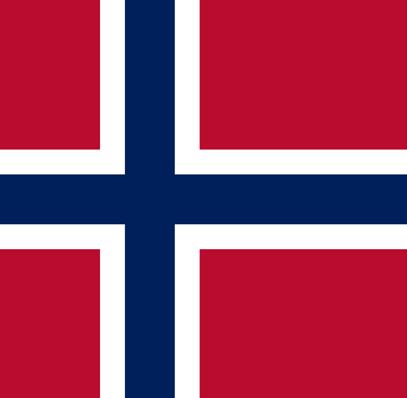

Their first medal was won in 1981 when the championship was held in Larvik in Norway. It was Nils Henning Sonne Andersen who won it in crosscountry riding Rex frá Ártúni.
Since then they have won sixteen more, the latest in 250 m. pace race young riders. Norway has never won more than two golds per event. Most golds have been won in cross-country (3) and over the past few Championships most golds have been won by young riders.
Stian Pedersen has won most gold medals for Norway or five in total and he is the only one who has won the Tölthorn.
Right before the start of the Championship Anne Stine Haugen and Hæmir frá Hyldsbæk had to withdraw from the compeition because of a acute lameness. Anne Stine and Hæmir were one of the strongest couples in tölt and four-gait holding the highest preliminary record this year in four-gait.
Competing for Norway at this World Championship are eight seniors and five young adults. Trainer for Norway is Rune Svendsen and team leader is Anne Pedersen.

116 | Eiðfaxi International
NORWAY | National team at the World Championship 2023
Lona Sneve
Reigning World Champion in P1 YR
Agnes Helga Helgad.
Age: 49 | 4th WC
Sigur fra Jakobsgården
Age: 11 | Stallion
F: Tígull fra Kleiva
M: Aradís fra Jakobsgården
Disciplines & best score:
Tölt T1: 7.61
Four-gait V1: 7.60
Carolin Storebø
Age: 30 | 2nd WC
Arnviður f. Hveragerði
Age: 16 | Stallion
F: Stáli frá Kjarri
M: Hrafntinna frá Hveragerði
Disciplines & best score:
Pace 250 m. P1: 23.31”
Pace 100 m. P2: 8.41”
Pace test PP1: 7.83
Caroline Wangen
Age: 26 | 2nd WC
Ógn frá Bessastöðum
Age: 12 | Mare
F: Héðinn frá Feti

M: Bylting frá Bessastöðum
Disciplines & best score:
Pace 100 m. P2: 7.53”
Christina Lund
Age: 56 | 11th WC
Lukku-Blesi frá Selfossi
Age: 11 | Stallion
F: Lukku-Láki f. Stóra-Vatnssk.
M: Keila frá Steinnesi
Disciplines & best score:
Tölt T2: 8.60
Four-gait V1: 8.00
Reserve: Nils-Christian Larsen riding
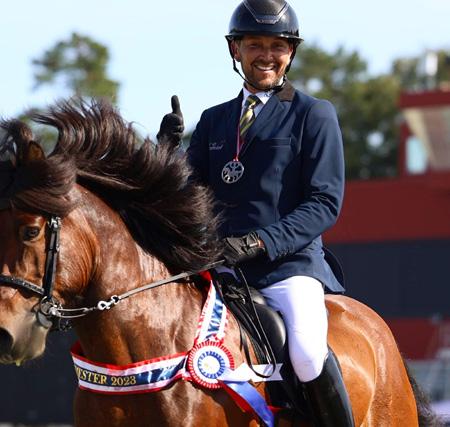

Flaumur frá Sólvangi. YR: Herman Gundersen riding Dimmalimm fra Midtlund




Erik Andersen
Age: 63 | 3rd WC
Farsæll frá Midtlund
Age: 12 | Stallion

F: Örn frá Efri-Gegnishólum
M: Framtid från Götarsvik
Disciplines & best score:
Five-gait F1: 7.78
Tölt T2: 7.90
Pace test PP1: 7.08
Gabrielle Severinsen
Age: 51 | 2nd WC
Tígull fra Kleiva
Age: 17 | Stallion
F: Hrynjandi frá Hrepphólum
M:Von fra Verket
Disciplines & best score:
Tölt T1: 8.57
Four-gait V1: 7.70
Nils Christian Larsen
9th WC
Gustur vom Kronshof
Age: 14 | Stallion
F: Depill frá Votmúla 1
M: Stygg vom Kronshof
Disciplines & best score:
Five-gait F1: 7.60
Tölt T2: 8.10
Eiðfaxi International | 117
YOUNG ADULTS:
Luisa Husby Sem
Age: 20 | 1st WC
Bakkus f. Grundet Hus
Age: 15 | Gelding
F: Kiljan frá Blesastöðum 1A
M: Iðunn frá Þúfu í Landeyjum
Disciplines & best score:
Tölt T1: 7.43
Fourgait V1: 7.10
Frøydis Musdalslien
Age: 18 | 1st WC
Kormákur f. Miðhrauni
Age: 12 | Stallion
F: Glóðafeykir frá Halakoti
M: Limra frá Kirkjubæ 2
Disciplines & best score: Tölt T2: 7.17

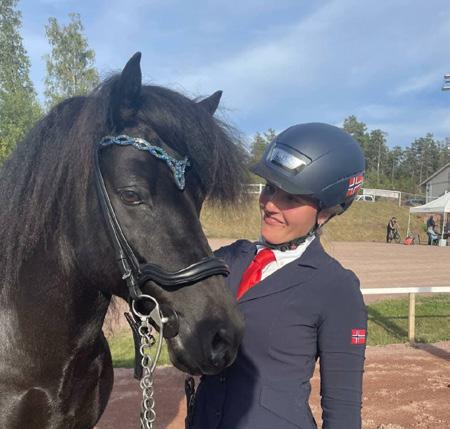

Four-gait V1: 6.70
Idunn Pedersen
Age: 20 | 1st WC
Solon fra Lysholm
Age: 9 | Stallion
F: Gjafar frá Hvoli
M: Sæla frá Þóreyjarnúpi
Disciplines & best score: Fivegait F1: 6.30
Pace test PP1, Tölt T1& pace 100 m. P2
Lill Kirsten Gilja
Age: 19 | 1st WC
Loki fra Tyse
Age: 17 | Gelding
F: Vörður frá Syðri-Gróf 1
M: Selja frá Kirkjubæ
Disciplines & best score:
Pace test PP1: 6.92
Pace 100 m. P2: 7.74”
Pace 250 m. P1: 24.05”
GOLD MEDALS
2019 P1(YR) Lona Sneve Stóri-Dímon f Hraukbæ
2017 P1(YR) Lona Sneve Stóri-Dímon f Hraukbæ
2017 P2(YR) Lona Sneve Stóri-Dímon f Hraukbæ
Maria Gjellestad Bosvik
Age: 19 | 1st WC
Tindur f. Jakobsgården
Age: 10 | Gelding
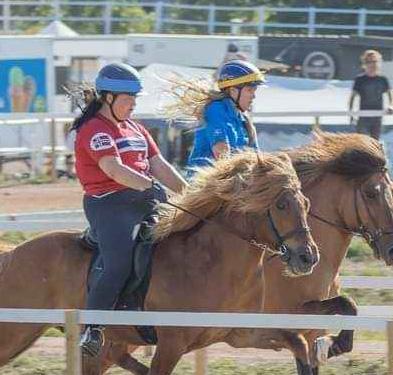

F: Nói fra Jakobsgården
M: Lisa fra Jakobsgården
Disciplines & best score:
Tölt T1: 6.57
Fourgait V1: 6.70
2013 T1(YR) Oda Ugland Hárekur frá Vindási
2013 C4(YR) Oda Ugland Hárekur frá Vindási
2011 T2 Tina K. Pedersen Kolgrimur f. Slätterne
2011 V1 Anne Stine Haugen Muni frá Kvistum
2009 T2 Tina K. Pedersen Kolgrimur f. Slätterne
2009 F1 Stian Pedersen Tindur frá Varmalæk
2007 T1 Stian Pedersen Jarl frá Miðkrika
2007 V1 Stian Pedersen Jarl frá Miðkrika
2005 C4 Stian Pedersen Jarl frá Miðkrika
2003 C4 Stian Pedersen Jarl frá Miðkrika
1989 CX Unn Kroghen Strákur frá Kirkjubæ
1985 CC Line Haugsline Snækollur Eyvindarm.
1983 CC Heidi Nilsen Hera frá Kirkjubæ
1981 CC Nils H. S. Andersen Rex frá Ártún
118 | Eiðfaxi International
Lífland - The Icelandic Equestrian shop









When visiting Iceland be sure to drop by at one of our 6 shops across the country.

We have a great selection of horse products, riding clothes, saddles & bridles.






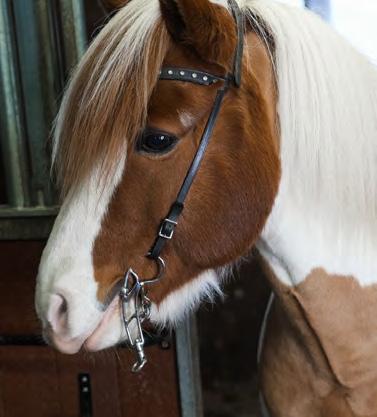

Eiðfaxi International | 119 Website: www.lifland.is Email: lifland@lifland.is Tel: +354 540 1125 Our shops are located in Reykjavik, Borgarnes, Blonduos, Akureyri, Hvolsvollur and Selfoss
Check out our online store at lifland.is
SWEDEN | National team at the World Championship 2023
In 1975 Sweden joined FEIF and participated in their first European Championship in 1977 in Skiveren, Denmark. Sweden’s first gold medal was won in 1991 but it was Ulf Lindgren who won the pace race riding Hrafnketill frá Sauðárkróki. Since then Sweden has won 28 gold medals, most of them (16) won in pace disciplines, six in 250 m. pace, six in PP1 pace test and four in 100 m. pace. Six in five-gait combination, two in five-gait, four in tölt T2 and one in four-gait (YR), counting both adults and young adults medals. Most titles were won in 2015 or six in total; tölt T2, 250 m. pace, four-gait (YR), 250 m. pace race (YR) and 100 m. pace (YR). Competing for Sweden at this World Championship are ten seniors and five young adults. Team leader is Sissel Holmén.
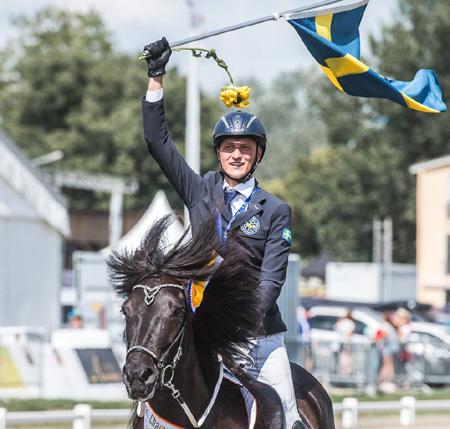




Reigning World Champion in C5
Magnús Skúlason
Age: 60 | 14th WC | 10 titles
“Valsa has a complicated personality and it’s not always easy to get her to cooperate. She has given me a few gray hairs throughout the years but also some of my best moments.”
Valsa från Brösarpsgården
Age: 14 | Mare
F: Askur från Håkansgården
M: Vordís frá Ási I
Disciplines & best score:
Pace test PP1: 9.07
Five-gait: 8.07
100 m. pace P2: 7.60”
250 m. pace P1: 21.60”
Reigning World Champion in C5 YR
Age: 25 | 3rd WC | 1 title YR
“My goal is to have a really nice week and Championship. It will also be fun to make personal records and be in the top 10”
Bíða frá Ríp
Age: 19 | Mare
F: Ísar frá Keldudal
M: Þerna frá Ríp
Disciplines & best score:
100 m. pace P2: 7.80”
250 m. pace P1: 22.88”
Pace test PP1: 6.80.
Reigning World Champion in T2 YR
Jack Eriksson
Age: 23 | 2nd WC | 1 title YR
“Milla is a 16 years old mare with a lot of character who loves to compete. She has many qualities I like and will therefore go to breeding after the WC”
Milla från Ammor
Age: 16 | Mare
F: Dökkvi frá Mosfelli
M: Mynta från Bergshill
Disciplines & best score: Tölt T2: 7.47
120 | Eiðfaxi International
Caspar Logan Hegardt
Age: 33 | 3rd WC
Oddi f. Skeppargården
Age: 15 | Stallion
F: Ægir från Skeppargården
M: Oddrún från Viarpshult
Disciplines & best score:
Tölt T2: 7.80
Five-gait F1: 7.57
Pace test PP1: 7.79
Filippa Helltén
Age: 26 | 3rd WC
Óðinn from Inchree
Age: 16 | Gelding
F: Glotti frá Sveinatungu

M: Mýra frá Hallkelsstaðahlíð
Disciplines & best score:
Pace 250 m. P1: 21,69”
Pace 100 m. P2: 7,35”
Pace test PP1
Guðmundur Einarsson
Age: 62 | 8th WC | 2 titles
Draumur f. Tängmark
Age: 9 | Stallion
F: Döggvi frá Ytri-Bægisá I
M: Vidja från Tavelsjö
Disciplines & best score:
Pace 250 m. P1: 22,18”
Pace 100 m. P2: 7,49”
Pace test PP1: 7.80
Jamila Berg
Age: 35 | 1st WC
Toppur Auðsholtshjáleigu
Age: 16 | Gelding

F: Álfasteinn frá Selfossi
M: Trú frá Auðsholtshjáleigu
Disciplines & best score:
Tölt T1: 8.67
Four-gait V1: 7.60
Reserve: Vignir Jónasson and Eyvindur frá Eyvindarmúla and Jessica Rydin and Rósi frá Litlu-Brekku.

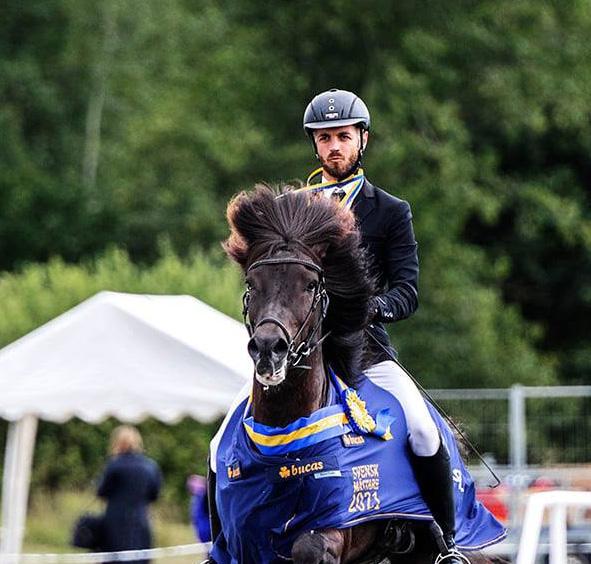
Kristján Magnússon
Age: 37 | 2nd WC
Oskar från Lindeberg
Age: 11 | Stallion
F: Oliver frá Kvistum
M: Fram från Lindeberg
Disciplines & best score:
Tölt T1: 8.07
Four-gait V1: 7.80
Máni Hilmarsson
Age: 26 | 3rd WC | 1 title YR
Gljátoppur f. Miðhrauni
Age: 8 | Stallion
F: Álfarinn f. Syðri-Gegnishólum
M: Salka frá Stuðlum
Disciplines & best score:
Tölt T2: 8.67

Five-gait F1: 7.60
Vignir Jónasson
Age: 52 | 12th WC | 3 titles
Felix från Änghaga
Age: 13 | Stallion
F: Vaki från Österåker
M: Freydís från Killebacken


Disciplines & best score:

Five-gait F1: 7.13
Tölt T1: 7.13
Pace test PP1: 7.88
Pace 100 m. P2
Eiðfaxi International | 121
YOUNG ADULTS:
Alicia Palm
Age: 18 | 1st WC
Ljúfa från Ekeholm
Age: 8 | Mare
F: Mökkvi från Åleby
M: Ástsæl från Majbacka
Disciplines & best score:
Pace 100 m. P2: 7.41”
Pace 250 m. P1: 23.20”
Lowa Walfridsson
Age: 16 | 1st WC
Seifur från Skälleryd
Age: 10 | Stallion
F: Seidur från Gröna Gången
M: Skrítla frá Neðri-Hrepp
Disciplines & best score:
Tölt T2: 7.44
Four-gait V1: 7.0
Amelie Segerström
Age: 17 | 1st WC
GOLD MEDALS
Kopar frá Sunnuhvoli
Age: 17 | Stallion
F: Álfasteinn frá Selfossi
M: Saga frá Litlu-Sandvík
Disciplines & best score:
Tölt T1: 6.80
Fivegait F1: 6.97
Pace test PP1: 7.08
Pace 100 m. P2: 8.47”
2019 C5 Magnús Skúlason Valsa f.Brösarpsgården

2019 T2 (YR) Jack Eriksson Milla från Ammor
2019 C5(YR) Elsa Teverud Kopar frá Sunnuhvoli
2017 PP1 Magnús Skúlason Valsa f.Brösarpsgården
2017 C5 Magnús Skúlason Valsa f.Brösarpsgården
2017 T2 (YR) Clara Olsson Þór frá Kaldbak
2015 T2 Vignir Jónasson Ivan från Hammarby
2015 P1 Guðmundur Einars. Sproti frá Sjávarborg
2015 V1(YR) Pierre S. Hoyos Falki från Karlsro
2015 P1(YR) Annie Ivarsdottir Prins från Wreta

2015 P2(YR) Moa Runnqvist Mökkvi från Åleby
2013 F1 Magnús Skúlason Hraunar f. Efri-Rauðal.
2013 P2 Josefin Birkebro Gná från Dahlgården
2013 C5 Magnús Skúlason Hraunar f. Efri-Rauðal.
2013 PP1(YR)Annie Ivarsdottir Drifa från Myre
2011 F1 Magnús Skúlason Hraunar f. Efri-Rauðal.
2011 C5 Magnús Skúlason Hraunar f. Efri-Rauðal.
Lára Hesselman
Age: 16 | 1st WC
Álfur från Knutshyttan
Age: 12 | Gelding



F: Prins från Knutshyttan
M: Álfadis från Åleby
Disciplines & best score:
Tölt T1: 7.17
Fourgait V1: 6.97
Tekla Petersson
Age: 16 | 1st WC
Vatnadís från Noastallet
Age: 8 | Mare
F: Vaki från Österåker
M: Isold från Hestwite
Disciplines & best score:
Five-gait F1: 7.10
Pace test PP1: Tölt T2:
2009 PP1 Guðmundur Einars. Sproti frá Sjávarborg
2005 PP1 Magnús Skúlason Mjölnir frá Dalbæ
2005 P1 Magnús Skúlason Mjölnir frá Dalbæ
2005 P2 Anna Björnsson Brynja frá Glæsibæ
2003 PP1 Johan Häggberg Askur f. Håkansgården
2003 P1 Magnús Skúlason Mjölnir frá Dalbæ
2003 P2 Magnus Lindquist Thor från Kalvsvik
2003 C5 Johan Häggberg Askur f. Håkansgården
2001 PP1 Johan Häggberg Askur f. Håkansgården
2001 P1 Anna Björnsson Mjölnir frá Dalbæ
1997 T2 Ylva Hagander Mökkur frá Varmálæk
1991 P1 Ulf Lindgren Hrafnketill Sauðárkróki
122 | Eiðfaxi International

SWITZERLAND | National team at the World Championship 2023
Switzerland was one of the six member countries that founded FEIF in 1969. Switzerland has participated in the European Championships and the World Championships from the start in 1970.


The first two gold medals were won at the first Championship. Barla Maissen riding Víkingur won the endurance race and the pace. They did the same thing at the next Championship, two golds, in cross country and pace. Switzerland also won gold in dressage. Rider was Eveline Meier riding Hassan.
Switzerland has won a total of 12 gold medals. At the European Championships in 1970 to 1979 Switzerland was victorious winning nine of these 12 medals. Then riders from Switzerland didn’t win any until 2015 when Lara Balz won two as a young rider riding Trú från Sundäng. The latest gold medal was won in 2017 Markus Albrecht Schoch and Kóngur frá Lækjamóti won the 250 m. pace and it will be fun to see if they do it again this year.
Competing for Switzerland at this World Championship are seven adults and five young adults. Team member Silvia riding Heljar frá Stóra-Hofi will compete in five-gait at the WC and that will be the 53rd preliminaries in five-gait that they participate in. They have been competing together since 2011 and their average score is 6,90 from all preliminaries.
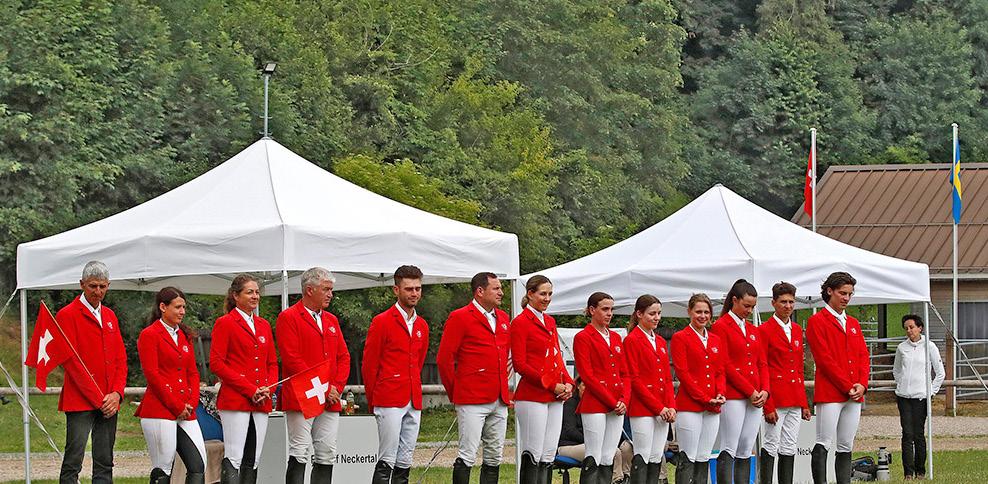
124 | Eiðfaxi International
Photo: Neddens
Flurina Barandun
Age: 38 | 8th WC
Kvaran f. Útnyrðingsst.
Age: 12 | Stallion
F: Markús frá Langholtsparti
M: Andvör frá Breiðumörk 2
Disciplines & best score:
Tölt T2: 8.00
Four-gait V1: 7.37
Linnéa Wydler
Age: 28 | 1st WC
Freymóður Wiesenhof
Age: 15 | Stallion
F: Fagriblakkur f. Efri-Rauðalæk
M: Jalda vom Wiesenhof
Disciplines & best score:
Fivegait F1: 6.87
Tölt T2: 7.40
Pace test
Lisa Staubli
Age: 32 | 5th WC
Viðja frá Feti
Age: 14 | Mare
F: Ómur frá Kvistum
M: Arndís frá Feti
Disciplines & best score: Tölt T2: 8.30

Livio Fruci
Age: 25 | 2nd WC
Jóhannes Kjarval f. Hala
Age: 18 | Gelding
F: Kjarval frá Sauðárkróki
M: Tinna frá Hala
Disciplines & best score:
Pace 100 m. P2: 7.92”
Pace 250 m. P1: 23.33”
Pace test PP1: 7.71
Reserve: Ladina Sigurbjörnsson-Foppa riding Losti frá Ekru, Oliver Egli riding Hrókur frá Hjarðartúni and Josephine Williams riding Kvaran fra Slippen.






Markus Albrecht-Schoch
Age:55 | 9th WC | 1 title
Kóngur frá Lækjamóti
Age: 21 | Gelding
F: Kolfinnur frá Kjarnholtum I
M: Haffa frá Samtúni
Disciplines & best score:
Pace 100 m. P2: 7.13”
Pace 250 m. P1: 21.24”
Oliver Egli
8th WC
Hákon f. Báreksstöðum
Age: 10 | Stallion
F: Hlynur frá Haukatungu Syðri 1
M: Herdís frá Báreksstöðum
Disciplines & best score:
Five-gait F1: 7.07
Tölt T2: 7.93
Pace test PP1:
Silvia Ochsenreiter Egli
Age: 47 | 5th WC
Heljar frá Stóra-Hofi
Age: 20 | Stallion
F: Aron frá Strandarhöfði
M: Morgunstjarna frá Stóra-Hofi
Disciplines & best score:
Five-gait F1: 7.33
Tölt T2:
Pace test PP1:
Pace 100 m. P2:
Eiðfaxi International | 125
YOUNG ADULTS:
Indira Scherrer
Age: 20 | 1st WC
Dugur frá Ketilsstöðum
Age: 9 | Stallion
F: Ljóni frá Ketilsstöðum
M: Djörfung frá Ketilsstöðum
Disciplines & best score:
Tölt T2: 6.93
Fivegait F1
Pace test PP1
Pace 100 m. P2
Dario Julita
1st WC
Rökkvi
Schnorrenberg
Age: 15 | Gelding
F: Farsæll von der Elschenau
M: Fjalladís vom Schnorrenberg
Disciplines & best score:
Pace test PP1: 6.96
Pace 250 m. P1: 22,64”
Pace 100 m. P2:
Eyvar
Albrecht
Age: 16 | 1st WC
Randalín Efri-Rauðalæk
Age: 17 | Mare
F: Þristur frá Feti
M: Kría frá Krithóli
Disciplines & best score: Tölt T2: 6.93
Ilaya Weibel
Age: 20 | 1st WC
Fimur fra Egholm
Age: 17 | Stallion

F: Borði frá Fellskoti
M: Silfra frá Litla-Bergi
Disciplines & best score: Tölt T1: 6.43

Josephine Williams
Age: 18 | 1st WC
Lér frá Valhöll
Age: 10 | Gelding
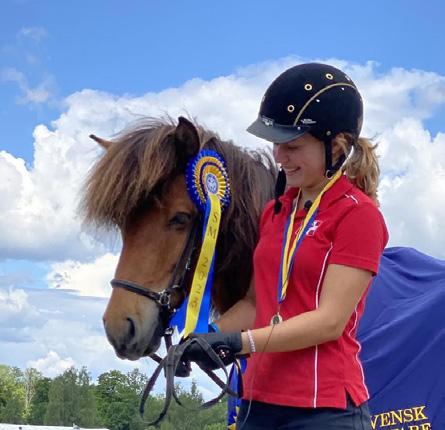


F: Spuni frá Vesturkoti
M: Embla frá Valhöll
Disciplines & best score:
Pace test PP1
Pace 100 m. P2: 7.84”
Pace 250 m. P1: 23.17”
GOLD MEDALS

2017 P1 Markus A. Schoch Kóngur frá Lækjamóti
2015 PP1YR Lara Balz Trú från Sundäng
2015 C5YR Lara Balz Trú från Sundäng
1979 P1 Barla Maissen Víkingur
1977 D2 Birgitte Nagel Goði f. Sandhólaferju
1977 D1 Heinrich Jud Dreyri Ytra-Dalsgerði
1975 J Heinrich Jud Thor fra Middal
1972 DS Eve Meier Hassan
1972 CC Barla Maissen Víkingur
1972 P1 Barla Maissen Víkingur
1970 ER Barla Maissen Víkingur
1970 P1 Barla Maissen Víkingur
126 | Eiðfaxi International

UNITED STATES | National team at the World Championship 2023
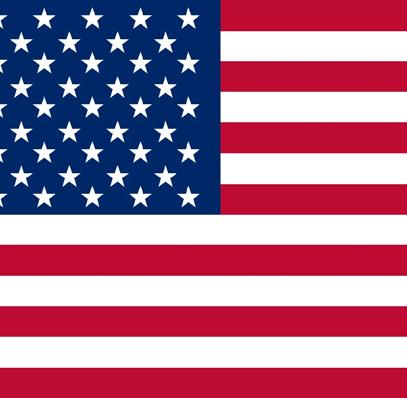

Alexandra Dannenmann
1st WC
Ára frá Langholti
Age: 11 | Mare
F: Álfur frá Selfossi
M: Gletta frá Innri-Skeljabrekku
Disciplines & best score:
Tölt T1: 6.73
Four-gait V1: 6.73
Caeli Cavanagh
Age: 31 | 2nd WC
Þeyr frá Ytra-Vallholti
Age: 16 | Gelding

F: Tígull frá Gýgjarhóli
M: Apríl frá Skeggsstöðum
Disciplines & best score:
Fivegait F1: 6.53
Tölt T2: 6.67
Pace test PP1
Geysir frá Kvistum
Age: 11 | Stallion
F: Glymur frá Flekkudal
M: Gná frá Heiði
Disciplines & best score:
Laura Benson
Age: 39 | 1st WC
Tölt T2: 7.40
Four-gait V1:
Fleur Brown
Age: 22 | 1st WC
Ás Eyfjörð frá Bakka
Age: 15 | Stallion
F: Álfur frá Selfossi
M: Milla frá Bakka
Disciplines & best score:
Tölt T1: 6.57
Four-gait V1:
Jennifer Melville
4th WC
Hljómur Gunnarsst. I
Age: 12 | Stallion


F: Ómur frá Kvistum
M: Alma Rún frá Skarði
Disciplines & best score:
Tölt T2: 6.73
Four-gait V1: 6.20
The USA joined FEIF in 1988 and after that the Championships changed their name from European Championship to World Championship.
Will Covert is the only one who has won a gold medal for the US riding Blær frá Sigluvík to victory in tölt T2. In 2009 Ásta D. Bjarnadóttir-Covert ended in third place in tölt T1 riding Dynjandi frá Dalvík and that is the closest that the US have been to winning the famous Tölthorn


At this Championship five riders will represent the US.
GOLD MEDAL
1999 T2 Will Covert Blær frá Sigluvík
128 | Eiðfaxi International The Teams at the World Championship in 2023


 The breeding track at the WC in 2017 in Oirschot
Photo: Louisa Lilja
The breeding track at the WC in 2017 in Oirschot
Photo: Louisa Lilja
The World Championship

Breeding horses at the Championship
37horses from 11nations
During the World Championships, a Breeding show is organized where each full FEIF member associations may enter a maximum of 2 horses per age group, whereas no reserve horses are possible. The horses may take part in both the breeding and sports classes, but the shoeing may not be changed at all during the World Championships. A horse may only represent the member association in which it was born. Stallions and mares are shown in separate classes in the following age groups: 5 years old, 6 years old and 7 years or older.
It was in 1985 in Vårgårda, Sweden the breeding horses were for the first time judged at a European Championship. That was also the same year that member countries of FEIF started to use the same form for judging breeding horses. At the World Championship in Oirschot 37 horses are registered from eleven different countries, Austria, Denmark, Norway, France, Sweden, Belgium, Finland, Germany, Switzerland, Netherlands and Icelands. Judges will be Elsa Albertsdóttir (IS), Jens Füchtenschnieder (DE) and Þorvaldur Kristjándsson (IS).
At this Championship the horses will not receive a new conformation score and only their riding abilities will be judged. The breeding assessment will begin on Tuesday morning and will be over by Friday.
Last Championship in 2019 in Berlin, Iceland received four golds, Sweden one and Germany one. According to the total that the horses have before the Championship the golds would go to; 7 years old stallions Norway, Sweden or Iceland, 7 years old mares Iceland, 6 years old stallions Denmark, 6 years old mares Germany or Iceland and five years old stallions and mares both to Iceland.
Eiðfaxi International | 131
Hulda Finnsdóttir hulda@eidfaxi.is
AUSTRIA | Breeding horses

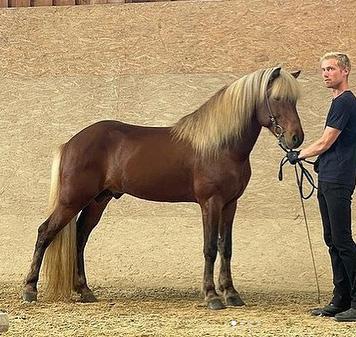
Two horses bred in Austria will be shown at the World Championship in Holland. Breeding horses from Austria are only shown in the oldest age group, 7 years and older.

Photos: ÖIV - Österreichischer Islandpferdeverband
7 YEARS & OLDER STALLIONS
AT2015130101
Sigursson von Hoftúni
F: Sigur frá Hólabaki
M: Birta frá Síðu
Breeder: Bára A. Elíasd. & Bjarki S. Jónss.
Owner: Celina Probst
Rider: Pierre Sandsten Hoyos
7 YEARS & OLDER MARES
AT2013260982
Meyja von St. Radegund
F: Spuni frá Vesturkoti
M: Gleði frá Vakurstöðum Total:
Breeder: Karl Piber
Owner: Carina Piber
Rider: Carina Piber
132 | Eiðfaxi International
8.09
7,5 - 8,0 - 8,5 - 8,5 - 8,0 - 8,5 - 8,0 - 7,0 = 8,14
abilities: 9,0 - 8,5 - 5,0 - 8,5 - 8,0 - 9,0 - 8,5 - 8,0 = 8,06
Conformation:
Riding
Slow tölt: 8,5
7,0 - 8,5 - 8,0 - 8,5 - 8,0 - 8,0 - 8,0 - 7,5 = 8,14 Riding abilities: 8,5 - 8,5 - 5,0 - 8,5 - 9,0 - 8,5 - 9,0 - 8,0 = 8,02 Slow tölt: 9,5
Total: 8.06 Conformation:
One horse bred in Belgium will be shown at the World Championship in Holland. A breeding horse from Belgium is only shown in the oldest age group, 7 years and older. Keilir frá Myllulæk recieved 8.39 when he was shown in june in FIZO which made him the highest judged horse ever bred in Belgium.
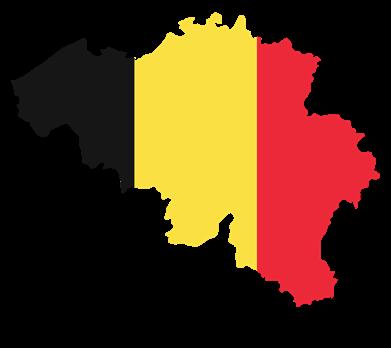

7 YEARS & OLDER STALLIONS
BE2014101922
Keilir frá Myllulæk
F: Hringur frá Fossi

M: Kolgríma Tinnudóttir frá Litla-Húsið
Breeder: Yves Van Peteghem
Owner: Dhr. M. van Leeuwen, Nancy Hofkens
Rider: Eric Winkler
BELGIUM
Breeding horses |
8.39 Conformation: 9,0 - 8,5 - 7,5 - 8,0 - 8,5 - 7,0 - 8,5 - 9,0 = 8,21 Riding abilities: 8,5 - 8,5 - 9,5 - 8,0 - 7,5 - 9,0 - 8,5 - 7,0 = 8,48 Slow tölt: 7.5
Total:
Photo: Neddens
DENMARK | Breeding horses


Five horses bred in Denmark will be shown at the World Championship in Holland. Denmark has representatives in all classes except for 5 year old stallions. Two horses are offsprings of Skinfaxi fra Lysholm but he is also representing Denmark in sport. Dama from Legind who was suppose to be shown in the oldest age group got in a car accident with her rider and breeders on her way to the Championship and had to withdraw from the breeding show
7 YEARS & OLDER STALLIONS
DK2015100181
Hagalín fra Engholm
F: Grímur frá Efsta-Seli
M: Helena Fagra fra Engholm
Total: 8.41
Breeder: Engholm Consult Aps v. Familien Vemming
Owner:Dubs Sylvia, Stald Gavnholt
Rider: Agnar Snorri Stefansson
7 YEARS & OLDER MARES
DK2016200352
Dama from Legind
F: Nökkvi from Glyngøre

M: Get off Legind
Total: 8.29
Conformation:
Slow
Breeder: Bo & Mette Bovbjerg Sørensen
Owner: Bo & Mette Bovbjerg Sørensen
Rider: Mette Bovbjerg Sørensen
134 | Eiðfaxi International
8,5 - 8,0 - 8,0 - 8,0 - 8,5 - 7,0 - 7,5 - 8,5
7,98
abilities: 8,5 - 8,0 - 8,5 - 8,5 - 8,0 - 9,0 - 8,5 - 8,5
8,45
=
Riding
=
tölt: 8,5
Conformation: 8,5 - 9,0 - 9,0 - 9,0 - 7,5 - 8,0 - 7,5 - 9,5 = 8,55 Riding abilities: 8,5 - 8,0 - 8,5 - 8,5 - 8,5 - 8,5 - 8,5 - 7,5 = 8,34 Slow tölt: 8,0
Photos: Tölt.dk
6 YEARS OLD STALLIONS
DK2017100389
Hraði fra Skovhuset
F: Feykir frá Háholti
M: Særún frá Sauðárkróki
Breeder: Skovhuset Islandsheste
Owner: Skovhuset Islandsheste
Rider: Þórður Þorgeirsson



6 YEARS OLD MARES
DK2017200254
Guðrún from Bredgaard
F: Skinfaxi fra Lysholm
M: Iða frá Holtsmúla 1
Total: 8.23
Breeder: Christina Bredgaard Husum,Per Rasmussen
Owner: Christina Bredgaard Husum,Per Rasmussen
Rider: Søren Madsen
5 YEARS OLD MARES
DK2018200398
List from Bendstrup
F: Skinfaxi from Lysholm
M: Minning from Bendstrup
Total: 8.20
Breeder: Søren Madsen & Birgitta Guðnason
Owner: Debelmose Isheste v. Søren Madsen
Rider: Søren Madsen
Slow
Eiðfaxi International | 135
8,5 - 8,5 - 9,0 - 8,0 - 8,0 - 7,5 - 8,5 - 8,0 = 8,34 Riding abilities: 8,5 - 8,5 - 6,0 - 8,5 - 8,5 - 9,0 - 8,5 - 8,0 = 8,12
Conformation:
tölt: 8,5
Conformation: 8,5 - 8,5 - 8,5 - 8,0 - 8,0 - 7,5 - 8,0 - 8,0 = 8,19 Riding abilities: 8,5 - 8,5 - 6,5 - 8,5 - 8,5 - 9,0 - 8,5 - 8,5 = 8,25 Slow tölt: 8,5
Conformation: 7,5 - 8,0 - 9,0 - 8,5 - 8,0 - 7,5 - 8,5 - 8,5 = 8,29 Riding abilities: 8,5 - 8,5 - 9,5 - 8,5 - 8,0 - 9,0 - 8,5 - 8,0 = 8,63 Slow tölt: 8,0
Total: 8.51
FINLAND | Breeding horses

Two horses bred in France will be shown at the World Championship in Holland and both are from the same breeding, du Langeren. This is the first time since 2013 that there will be breeding horses from France at the World Championship and it was the mother of these two, Tillit du Langeren that was shown in 2013.

7 YEARS & OLDER MARES
FI2016202002
Ísprinsessa fra Tallbo

F: Grásteinn frá Brekku, Fljótsdal
M: Vaka frá Hólabaki
Breeder: Ann-Christine Väyrynen
Owner: Ann-Christine Väyrynen
Rider: Máni Hilmarsson
8,5 - 8,0 - 8,0 - 8,5 - 7,5 - 7,5 - 8,0 - 8,0 = 8,04
abilities: 8,5 - 8,0 - 5,0 - 9,0 - 8,0 - 8,5 - 8,5 - 8,5 = 7,88
Total: 7.94 Conformation:
Riding
Slow tölt: 8.0
Photo: Ridsport
Breeding horses | FRANCE
Two horses bred in France will be shown at the World Championship in Holland and both are from the same breeding, du Langeren. This is the first time since 2013 that there will be breeding horses from France at the World Championship and it was the mother of these two, Tillit du Langeren that was shown in 2013.


Photos: Islandais du Langeren Facebook
6 YEARS OLD MARES
FR2017268440
Harka du Langeren
F: Bjarkar frá Langholti
M: Tillit du Langeren Total:
Breeder: Kugler Pascale
Owner: Kugler Pascale
Rider: Erlingur Erlingsson
7 YEARS & OLDER STALLIONS
FR2016168428
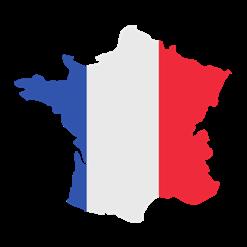
Gyllir du Langeren
F: Dalvar frá Auðsholtshjáleigu
M: Tillit du Langeren
Total: 7.90 Conformation:
Slow tölt: 8,5
Breeder: Kugler Pascale
Owner: Kugler Pascale
Rider: Erlingur Erlingsson
Eiðfaxi International | 137
Conformation: 8,5 - 8,5 - 8,0 - 8,0 - 7,5 - 8,0 - 7,5 - 8,5 = 8.04 Riding abilities: 8,5 - 8,0 - 7,0 - 8,5 - 8,5 - 8,5 - 8,5 - 6,5 = 8,02 Slow tölt: 8,5
8.02
9,0 - 8,5 - 7,5 - 8,5 - 8,0 - 7,0 - 7,0 - 9,0 = 8,04
9,0 - 8,0 - 5,0 - 8,0 - 8,0 - 8,5 - 8,5 - 7,0
Riding abilities:
= 7,82
GERMANY | Breeding horses



Representing Germany in FIZO at the World Championship are six horses in all age groups with two mares in the 6 year old group. Four of these horses are bred by Kronshof and the rider is Frauke Schenzel. Last Championship the German born Óðinn vom Habichtswald won the group of 7 years and older stallions and he has two offspring representing German this year, Pála and Reynir vom Kronshof. Náttdís vom Kronshof is also after a World Champion, Óskadís vom Habichtswald, who was the highest ranking 7 year old mare at the WC in 2013.
7 YEARS & OLDER STALLIONS
DE2014163010
Óskasteinn vom Habichtswald
F: Teigur vom Kronshof
M: Ósk frá Klængsseli
Total: 8.56
Breeder: Maria-Magdalena Siepe-Gunkel
Owner: Elisa Graf, Phillip Graf
Rider: Elisa Graf
7 YEARS & OLDER MARES
DE2015234422
Náttdís vom Kronshof
F: Garri frá Reykjavík
M: Óskadís vom Habichtswald
Total: 8.61
Conformation:
Breeder: Kronshof GbR
Owner: Kronshof GbR
Rider: Frauke Schenzel
138 | Eiðfaxi International
8,0 - 8,5 - 9,0 - 8,5 - 7,5 - 7,0 - 8,0 - 8,5 = 8,28
abilities: 9,0 - 9,0 - 8,5 - 8,5 - 9,5 - 9,0 - 9,0 - 7,5
8,79
tölt: 9.0
Riding
=
Slow
8,0 - 8,5 - 9,0 - 9,0 - 8,0 - 8,0 - 8,5 - 8,0 = 8,54 Riding abilities: 8,5 - 8,5 - 8,5 - 8,0 - 8,5 - 9,0 - 9,0 - 8,0 = 8,56 Slow tölt: 8.5
Conformation:
Photo: Neddens
Photos: Kronshof
6 YEARS OLD MARES
SE2017122918
Þrúða von der Dresdnerheide
F: Álfasteinn frá Selfossi
M: Þraut frá Þingeyrum Total:
6 YEARS OLD MARES
DE2017234955
Pála vom Kronshof
F: Óðinn vom Habichtswald
M: Jódís vom Kronshof
Total: 8.55
5 YEARS OLD STALLIONS
DE2018134274
Reynir vom Kronshof
F: Óðinn vom Habichtswald
M: Gígja vom Kronshof II Total: 8.11
Breeder: Angelika Persin
Owner: Angelika Persin
Rider: Þórður Þorgeirsson
Breeder: Kronshof GbR
Owner: Egger-Meier Anja, Kronshof GbR
Rider: Frauke Schenzel
Breeder: Kronshof GbR
Owner: Egger-Meier Anja, Kronshof GbR
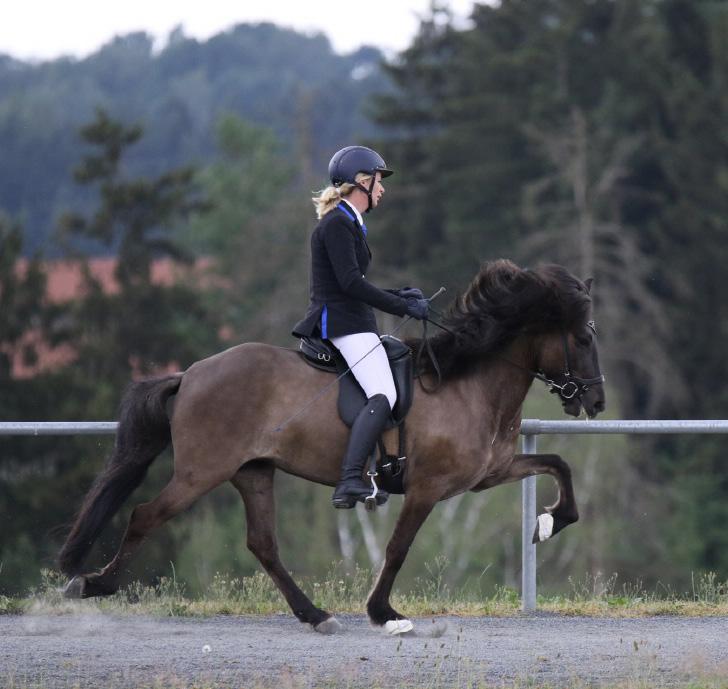

Rider: Frauke Schenzel
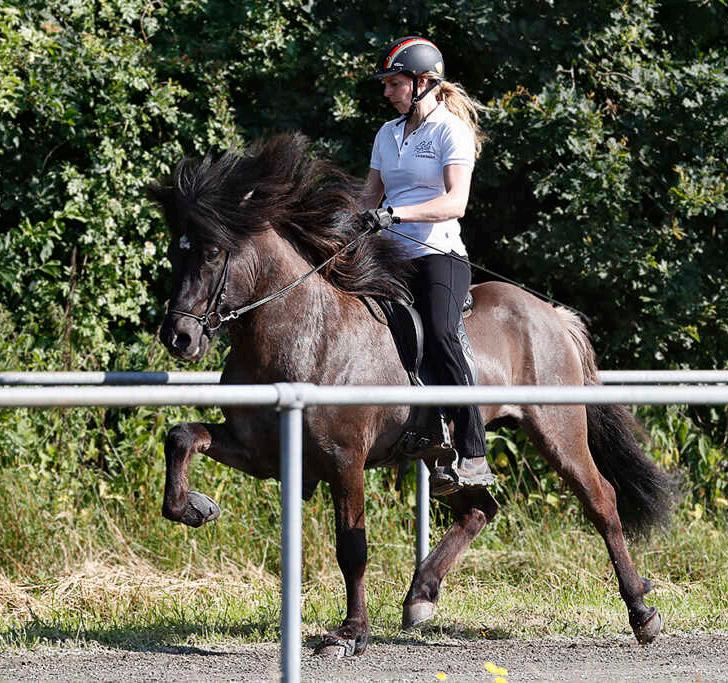
Eiðfaxi International | 139
Conformation: 7,5 - 8,5 - 8,0 - 8,5 - 9,0 - 7,5 - 8,5 - 7,5 = 8,32 Riding abilities: 8,0 - 8,5 - 7,0 - 8,0 - 8,0 - 8,0 - 8,5 - 8,0 = 7,99
tölt: 8,0
Slow
Conformation: 8,5 - 8,5 - 8,0 - 8,5 - 8,0 - 7,5 - 8,0 - 8,0 = 8,21 Riding abilities: 9,0 - 9,0 - 8,5 - 8,5 - 8,5 - 9,0 - 9,0 - 7,5 = 8,73 Slow tölt: 9.0
Conformation: 8,0 - 8,5 - 8,0 - 8,0 - 8,0 - 8,0 - 7,5 - 7,0 = 8,00 Riding abilities: 9,0 - 8,5 - 8,0 - 8,5 - 8,5 - 9,0 - 9,0 - 8,0 = 8,63 Slow tölt: 9.0
8.41
5 YEARS OLD MARES
DE2018234170
Rebekka vom Kronshof
F: Óðinn vom Habichtswald

M: Emma vom Kronshof
8.10
Breeder: Kronshof GbR
Owner: Kronshof GbR
Rider: Frauke Schenzel
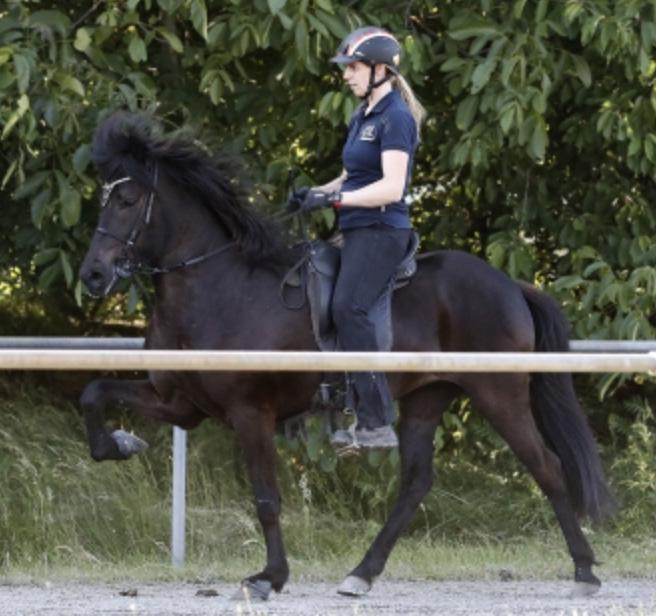
Conformation: 9,0 - 8,5 - 8,0 - 8,5 - 8,0 - 8,5 - 8,0 - 7,0 = 8,26 Riding abilities: 8,5 - 8,0 - 7,0 - 8,5 - 8,5 - 8,5 - 8,5 - 6,5 = 8,02 Slow tölt: 8.5
Total:
Representing Iceland at this Championship are six horses, three stallions and three mares all in different age groups. Last Championship in Berlin Icelandic breeding horses were at the top of four out of six groups. Looking at the total score of the Icelandic bred horses versus the other breeding horses Iceland has the highest scoring 5 year old mare and stallion, six year old mare just as Germany and the highest scoring 7 year old mare and stallion but he has the same total as the stallions representing Norway and Sweden.
7 YEARS & OLDER STALLIONS
IS2015166640
Hersir frá Húsavík
F: Vökull frá Efri-Brú
M: Hrauna frá Húsavík
Total:
Breeder: Einar Gíslason, Gísli Haraldsson
Owner: Nils Christian Larsen Rider: Teitur Árnason
7 YEARS & OLDER MARES
SE2014106695
Katla frá Hemlu II

F: Skýr frá Skálakoti
M: Spyrna frá Síðu Total:
Conformation:
Slow tölt: 8,5
Breeder: Anna Kristín Geirsdóttir, Vignir Siggeirsson


Owner: Anja Egger-Meier
Rider: Árni Björn Pálsson
Eiðfaxi International | 141 Breeding horses | ICELAND
8.79
9,0 - 9,0 - 8,0 - 9,0 - 8,5 - 8,0 - 8,5 - 9,0
8,66
abilities: 9,0 - 8,5 - 9,0 - 8,0 - 8,5 - 9,5 - 9,0 - 8,5 = 8,86
=
Riding
8.62 Conformation: 8,5 - 9,5 - 8,0 - 9,5 - 8,5 - 8,5 - 9,5 - 8,5 = 8,99 Riding abilities: 9,0 - 9,5 - 5,0 - 8,5 - 9,0 - 9,0 - 9,5 - 8,0 = 8,42 Slow tölt: 8.5
Photo: Nicki Pfau
6 YEARS OLD STALLIONS
IS2017186936
Geisli frá Árbæ
F: Ölnir frá Akranesi M:
Breeder: Gunnar A. Jóhannss., Vigdís Þórarinsd.
Owner: G. Jóhannsson ehf.
Rider: Árni Björn Pálsson
6 YEARS OLD MARES
IS2017281424
Hrönn frá Fákshólum
F: Kiljan frá Steinnesi
M: Adama frá Búrfelli
Breeder:HelgaU.Björnsd.,JónEiríkss.,SigurbjörgGeirsd.
Owner: Anja Egger-Meier, Kronshof.GbR

Rider: Jakob Svavar Sigurðsson
5 YEARS OLD STALLIONS
IS2018137486
Höfði frá Bergi
F: Apollo frá Haukholtum
M: Hilda frá Bjarnarhöfn
Breeder: Anna Dóra Markúsdóttir
Owner: Anna Dóra Markúsdóttir
Rider: Þorgeir Ólafsson


142 | Eiðfaxi International
8.35 Conformation: 8,5 - 8,5 - 8,5 - 8,5 - 7,0 - 7,5 - 8,5 - 7,5 = 8,23 Riding abilities: 8,5 - 8,5 - 8,5 - 8,5 - 7,5 - 9,0 - 8,0 - 8,5 = 8,42
tölt: 8,0
Total:
Slow
Total: 8.55 Conformation:7,5 - 9,0 - 9,0 - 9,0 - 8,0 - 8,0 - 8,5 - 7,0 = 8,59 Riding abilities: 8,5 - 8,5 - 7,5 - 9,0 - 9,0 - 9,0 - 9,0 - 8,5 = 8,53 Slow tölt: 8,5
Total: 8.49 Conformation: 8,0 - 9,0 - 9,5 - 9,0 - 8,5 - 7,5 - 8,5 - 8,0 = 8,76 Riding abilities: 8,5 - 8,0 - 8,5 - 8,5 - 8,5 - 8,5 - 8,5 - 7,5 = 8,34 Slow tölt: 8,0
Gleði frá Árbæ
5 YEARS OLD MARES
IS2018267175
Ársól frá Sauðanesi
F: Spuni frá Vesturkoti
M: Sóllilja frá Sauðanesi
8.51
Breeder: Kronshof GbR
Owner:JensP.Sonne,MajaL.Groth,MarianneSonne Rider: Aðalheiður Anna Guðjónsdóttir

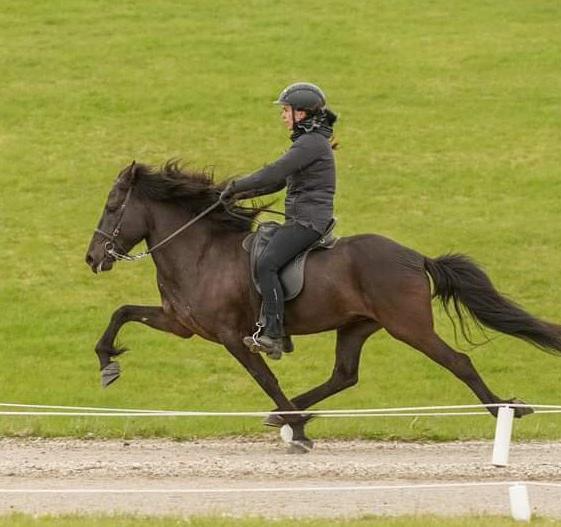
Conformation: 8,0 - 8,5 - 8,0 - 8,5 - 8,0 - 8,0 - 8,5 - 7,0 = 8,24 Riding abilities: 8,5 - 8,5 - 9,0 - 8,0 - 8,5 - 9,0 - 8,5 - 9,0 = 8,65 Slow tölt: 8.0
Total:
Photo: Nicki Pfau
NORWAY | Breeding horses
Four horses bred in Norway will be shown at the World Championship in Holland. Two of them are from Inge Kringeland’s breeding, Kringeland. Norway has representatives in all classes except for 5 year old stallions and 6 year old mares.


7 YEARS & OLDER STALLIONS
NO2014104293
Svanur fra Kringeland

F: Sævar frá Hæli
M: Alda fra Kringeland
Total: 8.62
Breeder: Inge Kringeland
Owner: Inge Kringeland
Rider: Eyjólfur Þorsteinsson
7 YEARS & OLDER MARES
NO2016208079
Milljón fra Bergkåsa
F: Framherji frá Flagbjarnarholti
M: Skíma fra Bujord
Total: 8.27 Conformation:
Breeder: Liv Runa Sigtryggsdottir
Owner: Liv Runa Sigtryggsdottir
Rider: Liv Runa Sigtryggsdottir
144 | Eiðfaxi International
9,0 - 8,5 - 7,5 - 8,5 - 8,0 - 7,0 - 7,0 - 9,0 = 8,04
abilities: 9,0 - 9,0 - 5,0 - 8,5 - 9,0 - 9,0 - 9,0 - 9,0 = 8,36
tölt:
Riding
Slow
8,5
7,0 - 8,5 - 9,0 - 9,0 - 8,0 - 8,5 - 8,5 - 7,5 = 8,49 Riding abilities: 9,0 - 8,0 - 9.0 - 8.5 - 8,5 - 9.0 - 8,5 - 8,5 = 8.68 Slow tölt: 8.5
Conformation:
6 YEAR OLD STALLIONS
NO2017104027
Golíat fra Dysterud
F: Viking från Österåker
M: Garún frá Árbæ
Breeder: Dysterud Breeding AS

Owner: Dysterud Breeding AS

Rider: Kristin Elise Andersen
5 YEAR OLD MARES
NO2018204259
Alexandra fra Kringeland
F: Álfasteinn frá Selfossi
M: Veröld frá Blönduósi
Breeder: Inge Kringeland
Owner: Inge Kringeland
Rider: Erlingur Erlingsson

Conformation: 8,0 - 8,5 - 8,0 - 8,5 - 7,5 - 8,0 - 8,5 - 6,5 = 8,16 Riding abilities: 9,0 - 7,5 - 5,0 - 8,0 - 8,5 - 8,5 - 8,5 - 7,0 = 7,78 Slow tölt:
Total: 7.90
9.0
Conformation: 8,0 - 8,5 - 8,5 - 8,5 - 8,5 - 7,5 - 8,0 - 7,0 = 8,28 Riding abilities: 8,5 - 8,0 - 8,0 - 8,0 - 8,0 - 8,5 - 8,0 - 7,5 = 8,13 Slow tölt: 8.0
Total: 8.18
SWEDEN | Breeding horses

Six horses bred in Sweden will be shown at the World Championship in Holland. Denmark has representatives in all classes with the exception that they have two stallions in the oldest age group and no mare. In the group is a World Champion from last WC, Kolgrímur Grímsson från Gunvarbyn, he was the highest judged 5 year old stallion.


7 YEARS & OLDER STALLIONS
SE2014106693
Náttfari från Gunvarbyn
F: Grímur frá Efsta-Seli
M: Nótt fra Ørskog
Total:
Breeder: Þorleifur Sigfússon
Owner:Alf Bjørseth
Rider: Agnar Snorri Stefansson
7
YEARS & OLDER STALLIONS
SE2014106695
Kolgrímur Grímsson från Gunvarbyn
F: Grímur frá Efsta-Seli
M: Kolskör från Kolungens Gård 2
Breeder: Þorleifur Sigfússon
Owner: Stald Gavnholt v/ Agnar Snorri Stefánsson
Rider: Agnar Snorri Stefansson
146 | Eiðfaxi International
7,5 - 8,5 - 9,0 - 9,0 - 9,0 - 8,0 - 8,5 - 8,0 = 8,63
abilities: ,5 - 8,5 - 8,0 - 8,5 - 8,5 - 8,5 - 8,5 - 9,5 = 8,52
Total: 8.56 Conformation:
Riding
Slow tölt: 8,5
8.62 Conformation: 8,5 - 9,0 - 9,0 - 9,0 - 9,5 - 8,0 - 8,5 - 9,0 = 8,90 Riding abilities: 8,5 - 8,5 - 8,5 - 8,5 - 8,0 - 8,5 - 8,5 - 8,5 = 8,47 Slow tölt: 8.0
Photo: Krijn Buijtelaar
6 YEARS OLD STALLIONS
SE2017122918
Merkúr från Smedjan
F: Álfur frá Selfossi
M: Minning från Margaretehof
Breeder: Jesper Eurenius
Owner: Jesper Eurenius, Josefin Birkebro
Rider: Josefin Birkebro
6 YEARS OLD MARES
SE2017223903
Karólína från Backome
F: Viking från Österåker
M: Kvika vom Forstwald
Total: 8.26
Breeder: Backome Islandshästar AB
Owner: Karly Zingsheim
Rider: Karly Zingsheim
5 YEARS OLD STALLIONS

SE2018122021
Mótor från Smedjan
F: Viking från Österåker
M: Minning från Margaretehof Total: 8.17
Breeder: Jesper Eurenius, Pernilla Eurenius

Owner: Jesper Eurenius, Pernilla Eurenius
Rider: Vignir Jonasson

Eiðfaxi International | 147
Conformation: 8,0 - 8,5 - 8,0 - 9,0 - 8,0 - 7,0 - 8,5 - 8,0 = 8,33 Riding abilities: 8,0 - 8,0 - 8,0 - 8,0 - 8,0 - 8,5 - 8,5 - 7,5 = 8,08
tölt: 8,0
Slow
Conformation: 7,5 - 8,0 - 7,5 - 8,5 - 7,5 - 7,5 - 8,0 - 7,5 = 7,89 Riding abilities: 9,0 - 8,0 - 7,5 - 8,5 - 8,5 - 9,0 - 8,5 - 8,5 = 8,45 Slow tölt: 8,5
Conformation: 7,5 - 8,5 - 8,0 - 8,0 - 8,0 - 8,0 - 9,0 - 9,5 = 8,29 Riding abilities: 8,0 - 8,0 - 8,0 - 8,5 - 8,0 - 8,5 - 8,5 - 8,5 = 8,20 Slow tölt: 8,0
Total: 8.23
5 YEARS OLD MARES
SE2018224041
Náttfaradís från Raudhetta gård
F: Dagfari frá Eylandi

M: Lilja från Lindvallen
Breeder: Raudhetta Islandshästar AB
Owner: Raudhetta Islandshästar AB
Rider: Sebastian Benje

Conformation: 7,5 - 8,0 - 8,5 - 8,0 - 7,5 - 7,5 - 8,0 - 7,0 = 7,92 Riding abilities: 8,0 - 8,0 - 8,0 - 8,5 - 7,5 - 8,5 - 8,5 - 7,0 = 8,03 Slow tölt: 8.5
Total: 7.99
Three horses will represent the Netherlands at the World Championship in Holland. Mare and a stallion in the 7 years and older groups and a six year old mare. At the last Championship the Netherlands had one breeding horse representing them.
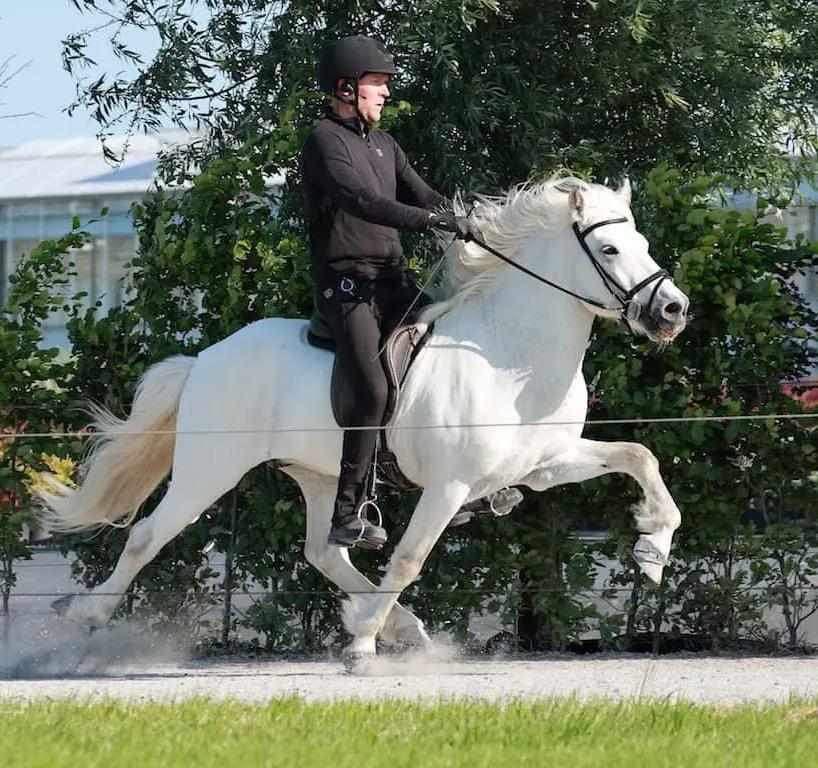

7 YEARS & OLDER STALLIONS
NL2007100126

Hausti van’t Groote Veld
F: Jarl frá Miðkrika
M: Sara frá Oddhóli
Total:
Breeder: Mw. Livien Eversen
Owner: Dhr. Fr. Buijtelaar, Mw. M. de Haan
Rider: Tom Buijtelaar
7 YEARS & OLDER MARES
NL2015200019
Þokkadís frá Telmustöðum
F: Hnokki frá Fellskoti
M: Telma frá Auðsholtshjáleigu Total:
Breeder: Dr. M.A. MacKenzie
Owner: Anne Frank Andresen
Rider: Agnar Snorri Stefánsson
Eiðfaxi International | 149 Breeding horses | NETHERLANDS
8.22 Conformation: 8,0 - 8,5 - 8,0 - 8,5 - 7,5 - 7,5 - 7,5 - 7,0 = 8,01 Riding abilities:8,5 - 8,0 - 7,5 - 9,0 - 8,0 - 9,0 - 8,5 - 8,5 = 8,32
Slow tölt: 8,5
8.16 Conformation: 8,5 - 8,5 - 7,5 - 8,5 - 8,0 - 7,0 - 8,0 - 8,0 = 8,11 Riding abilities: 8,0 - 8,0 - 8,0 - 8,5 - 8,5 - 8,5 - 8,5 - 8,0 = 8,18 Slow tölt: 8.5
Mynd: Deens Stamboek
Mynd: Henk Peterse
6 YEAR OLD MARES
NL2017200107
Aría frá Álftakoti
F: Skýr frá Skálakoti
M: Arna frá Holtsmúla 1 Total: 8.06
Breeder: Dhr.T.G. Hoogenboom, Mw. S. Philipsen
Owner:Dhr.B.Vervest,Dhr.T.G.Hoogenboom,Mw.M.J.Pe
Rider: Þórður Þorgeirsson
One breeding horse will represent Switzerland at the World Championship in Holland. It’s the 9 year old Væna von Wallenschwill. Two horses represented Switzerland at the last Championship in 2019.



7 YEARS & OLDER MARES
CH2014202752
Væna von Wallenschwil
F: Baltasar vom Freyelhof
M: Von fra Vigra Total: 8.36 Conformation:
Slow tölt: 8.0
Breeder: Wyss Hedi
Owner: Livio Fruci
Rider: Livio Fruci
150 | Eiðfaxi International
Conformation: 8,0 - 8,0 - 7,5 - 8,0 - 8,0 - 8,0 - 8,0 - 7,5 = 7,90 Riding abilities: 8,5 - 8,5 - 6,5 - 8,0 - 8,0 - 8,5 - 8,5 - 8,5 = 8,14 Slow tölt: 8.5
Mynd: Henk Peterse
8,0 - 8,0 - 8,5 - 8,5 - 7,5 - 7,5 - 8,0 - 7,0 = 8,05
abilities: 8,5 - 8,5 - 9,0 - 8,0 - 8,0 - 8,5 - 8,5 - 8,5 = 8,52
Riding
SWITZERLAND | Breeding horses

Number of gold medals by country
*Titles won by young adults start to count to
DE CH IS NL FI AT FR NO DK SE USA GB 1970 5 2 1 1972 5 3 1975 6 1 2 1 1977 4 2 2 1 1979 4 1 3 1 1 1981 4 2 1 1983 4 4 1 1985 3 1 1 1 2 1987 3 4 1 1 1989 5 1 1 1 1991 3 1 3 1 1993 3 4 1 1995 3 3 1 1 1 1997 1 5 1 1 1999 1 5 1 1 2001 1 5 1 2 2003 1 3 1 4 2005 1 5 1 3 2007 1 6 2 2009 1 4 2 1 1 2011 3 1 2 1 2 2013* 4 5 1 2 1 4 2015 4 2 4 3 5 2017 7 1 4 2 3 1 2019 5 7 1 2 3 2023 ??? Total: 79 12 84 6 1 10 1 17 12 29 1 1
TITLES
WORLD CHAMPIONS
TÖLT - The victory goes to Iceland
Jóhann with seven titles
Year Rider Horse
2019 Jóhann R. Skúlason Finnbogi frá Minni-Reykjum IS
2017 Jakob S. Sigurðsson Gloría frá Skúfslæk IS
2015 Kristín Lárusdóttir Þokki frá Efstu-Grund IS
2013 Jóhann R. Skúlason Hnokki frá Fellskoti IS
2011 Jóhann R. Skúlason Hnokki frá Fellskoti IS
2009 Jóhann R. Skúlason Hvinur frá Holtsmúla 1 IS
2007 Stian Pedersen Jarl frá Miðkrika NO
2005 Jóhann R. Skúlason Hvinur frá Holtsmúla 1 IS
2003 Jóhann R. Skúlason Snarpur frá Kjartansstöðum IS
2001 Hafliði Halldórsson Valíant frá Heggsstöðum IS
1999 Jóhann R. Skúlason Fengur frá Íbishóli IS
1997 Vignir Sigeirsson Þyrill frá Vatnsleysu IS
1995 Jolly Schrenk Ofeigur DE
1993 Jolly Schrenk Ofeigur DE
1991 Andreas Trappe Tyr f. Rappenhof DE
1989 Bernd Vith Rödur f. Ellenbach DE
1987 Sigurbjörn Bárðarson Brjánn IS
1985 Wolfgang Berg Funi DE
1983 Hans Georg Gundlach Skolli DE
1981 Christiane Mathiesen Gammur frá Hofsstöðum DE
1979 Christiane Mathiesen Gammur frá Hofsstöðum DE
1977 Bernd Vith Fagri-Blakkur frá Hvítárbakka DE
1975 Reynir Aðalsteinsson Dagur frá Núpum IS
1972 Bruno Podlech Stjarni frá Svignaskarði DE
1970 Walter Feldmann jr. Funi frá Kaupvangi DE
Tölthornið
The Tölthorn is the most prestigious award at the Championships. Iceland won the Tölthorn for the first time in 1975 and then twelve times more, the most of all nations, followed by Germany with eleven titles. No rider has won it more than Jóhann R. Skúlason or seven times.

The award was given by the Icelandic Ministry of Agriculture and it was an initiative of Gunnar Bjarnason. The horn is made by the goldsmith Halldór Sigurðsson.

FIVE-GAIT F1 - Most titles to Iceland
Victorious Walter
Year Rider Horse
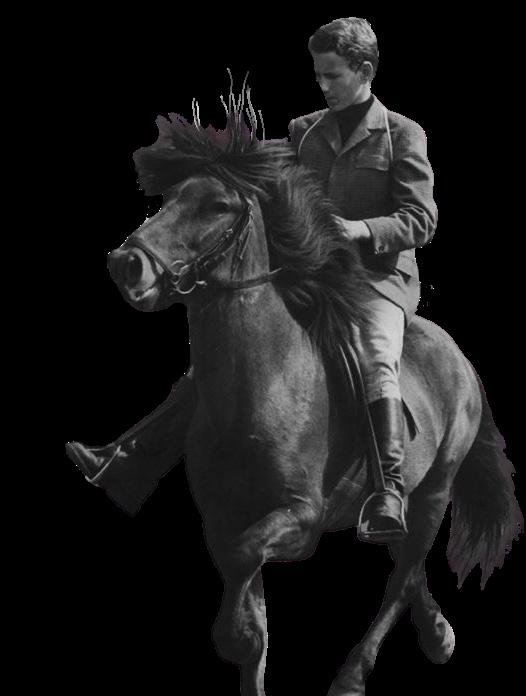
2019 Jón Stenild Eilífur fra Teglborg DK
2017 Frauke Schenzel Gustur vom Kronshof DE
2015 Julie Christiansen Hugur frá Flugumýri II DK
2013 Magnús Skúlason Hraunar frá Efri-Rauðalæk SE
2011 Magnús Skúlason Hraunar frá Efri-Rauðalæk SE
2009 Stian Pedersen Tindur frá Varmalæk NO
2007 Þórarinn Eymundsson Kraftur frá Bringu IS
2005 Styrmir Árnason Hlynur frá Kjarnholtum I IS
2003 Sigurður V. Matthíasson Fálki frá Sauðárkróki IS
2001 Vignir Jónasson Klakkur frá Búlandi IS
1999 Auðunn Kristjánsson Baldur frá Bakki IS
1997 Karly Zingsheim Feykir von Rinkscheid DE
FIVE-GAIT F1
Of the first five European Championships, Walter Feldmann jr. won the five-gait four Championships. He has won the most titles in five-gait out of all other riders.
Magnús Skúlason is the only one who has won it two Championships in a row after it was called the World Championship.
Icelanders haven’t won the five-gait since 2007 when Þórarinn riding Kraftur won.

1995 Sigurður V. Matthíasson Huginn frá Kjartansstöðum IS
1993 Sigurbjörn Bárðarson Höfdi f. Húskavík IS
1991 Carina Heller Glaumur frá Sauðárkrókur DE
1989 Andreas Trappe Gnyr frá Bjørnli DE
1987 Peter Schröder Ásta AT
1985 Benedikt Þorbjörnsson Styrmir frá Seli IS
1983 Aðalsteinn Aðalsteinsson Baldur frá Sandhólum IS
1981 Walter Feldmann jr.
Eldjárn frá Langelandsgården DE
1979 Ragnar Hinriksson Fróði frá Ásgeirsbrekku IS
1977 Walter Feldmann jr.
Eldjárn frá Langelandsgården DE
1972 Walter Feldmann jr. Funi frá Kaupvangi DE
1970 Walter Feldmann jr.
Eldjárn frá Langelandsgården DE
Out of 23 times Germany has won the four-gait 14 times -

Bernd with four titles
Year Rider
Horse
2019 Jóhann R. Skúlason Finnbogi frá Minni-Reykjum IS 2017 Jolly Schrenk Glæsir von Gut Wertheim DE
Guðmundur F. Björgvinsson Hrímnir frá Ósi IS
Frauke Schenzel Tígull vom Kronshof DE
Anne Stine Haugen Muni frá Kvistum NO
Lena Trappe Vaskur vom Lindenhof DE
Stian Pedersen Jarl frá Miðkrika NO
Sigurður Sigurðarson Silfurtoppur frá Lækjamóti IS
Berglind Ragnarsdóttir Bassi frá Möðruvöllum IS
2001 Styrmir Árnason Farsaell frá Arnarhóll IS
1999 Olil Amble Kjarkur frá Horni IS
1997 Styrmir Árnason Boði frá Gerðum IS 1995 Jolly Schrenk Ofeigur DE 1993 Jolly Schrenk Ofeigur DE 1991 Andreas Trappe Tyr f. Rappenhof DE 1989 Sandra Schutzbach Glampi f. Erbeldinger Hof DE
1987 Bernd Vith Örvar DE
1985 Daniela Schmitz Seifur frá Kirkjubæ DE
1983 Hans Georg Gundlach Skolli DE
1981 Bernd Vith Fagri-Blakkur frá Hvítárbakka DE
1979 Bernd Vith Fagri-Blakkur frá Hvítárbakka DE
1977 Bernd Vith Fagri-Blakkur frá Hvítárbakka DE
1975 Janneke Faber Léttir frá Innrihólmi NL
1972 Wolfgang Berg Gáski DE
1970 Reynir Aðalsteinsson Stjarni frá Svignaskarði IS
1970 Walter Feldmann jr. Funi fra Kaupvangi DE
FOUR-GAIT V1
No one has won the four-gait as often as Bernd Vith. He won it four times, three times in a row riding FagriBlakkur frá Hvítárbakka. They are the only ones who achieved it. The fourth time Bernd was riding Örvar.
Bernd rode Icelandic horses since 1967. He worked at Aegidienberg among other places and from 1999 he worked at the Böddinger Horse Center. Bernd died suddenly in January 2006, aged 49.
In 1975 riders competed in multi-gait discipline instead of four- and five-gait. The multi-gait discipline was split in two groups, one with trot the other with pace.

2009
2007
2005
2015
2013
2011
2003
FOUR-GAIT
TÖLT T2 - Most titles have gone to Germany

The only gold medal for the US
TÖLT T2
Riders started to compete in tölt T2 in 1991 at the Championships.
The only gold for the US has been won in this discipline.
Julie Christiansen is the reigning world champion and has won the discipline twice. Tina Kalmo Pedersen and Silke Feuchthofen have also won it twice.
Icelanders have never won gold in tölt T2 at the Championships.

Year Rider Horse
2019 Julie Christiansen Stormur frá Hemlu I DK
2017 Johanna Tryggvason Fönix frá Syðra-Holti DE
2015 Vignir Jónasson Ivan från Hammarby SE
2013 Julie Christiansen Straumur frá Seljabrekku DK
2011 Tina Kalmo Pedersen Kolgrimur från Slätterne NO
2009 Tina Kalmo Pedersen Kolgrimur från Slätterne NO
2007 Jolly Schrenk Laxnes vom Störtal DE 2005 Silke Feuchthofen Hrafnkatla vom Mühlenbach DE
2003 Silke Feuchthofen Hrafnkatla vom Mühlenbach DE
2001 Anne Balslev
Hrammur frá Þóreyjarnúpi DK
1999 Will Covert Blær frá Sigluvik US
1997 Ylva Hagander Mökkur frá Varmálæk SE
1995 Gaby Füchtenschnieder Mergur vom Wendalinushof DE
1993 Gerrit Schurl Kórak f. Nedra-Ási AT
1991 Johannes Hoyos Fjölnir f. Kivíabekk AT

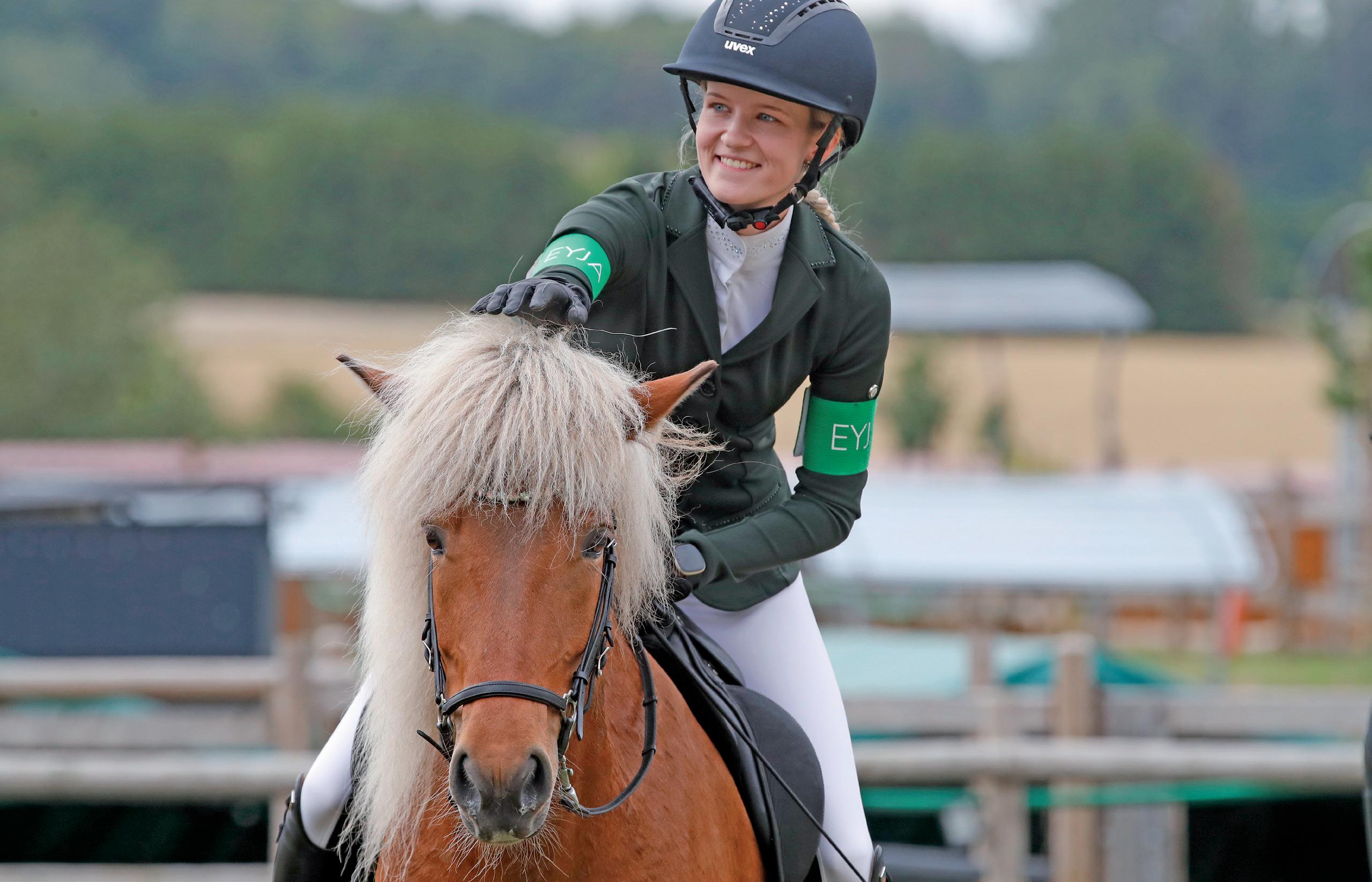
Web. Magazine. Live Events. Podcasts. Social Media. 100% Icelandic Horses. All the time. www.eyja.net @eyja.live News & Information from around the World.
Photo: Ulrich Neddens
PACE TEST PP1 - Iceland with ten titles out of nineteen
Triple victory for Sigurbjörn
PACE TEST PP1
Sigurbjörn Bárðarson has won the most titles. Seen in the photo with Gordon frá Stóra-Ásgeirsá, but together they became multiple world champions and world record holders in pace disciplines.

The photo was taken in 2013 when they met again at the World Championship, 16 years after they won their title in the pace test.
Riders have competed in PP1 nineteen times and ten times the title has gone to Iceland.
Year Rider Horse Land
2019 Teitur Árnason Dynfari frá Steinnesi IS

2017 Magnús Skúlason Valsa från Brösarpsgården SE
2015 Teitur Árnason Tumi frá Borgarhóli IS
2013 Sigurður Marinusson Atli frá Norður-Hvammi NL
2011 Sigurður Marinusson Eilimi vom Lindenhof NL
2009 Guðmundur Einarsson Sproti frá Sjávarborg SE
2007 Sigursteinn Sumarliðason Kolbeinn frá Þóroddsstöðum IS
2005 Magnús Skúlason Mjölnir frá Dalbæ SE
2003 Johan Häggberg Askur från Håkansgården SE
2001 Johan Häggberg Askur från Håkansgården SE
1999 Höskuldur Aðalsteinsson Ketill frá Glæsibæ II AT
1997 Sigurbjörn Bárðarson Gordon frá Stóru-Ásgeirsá IS
1995 Sigurbjörn Bárðarson Höfði frá Húskavík IS
1993 Sigurbjörn Bárðarson Höfði frá Húskavík IS
1991 Gunnar Arnarson Kolbakur f. Hvassafell IS
1989 Jón Pétur Ólafsson Glaumur frá Sauðárkróki IS
1987 Reynir Aðalsteinsson Spói IS
1985 Vera Reber Frosti f. Fáskrúðabakki DE
1983 Aðalsteinn Aðalsteinsson Baldur frá Sandhólum IS
250 METERS PACE P1 - Icelanders have won the 250 m. pace most often
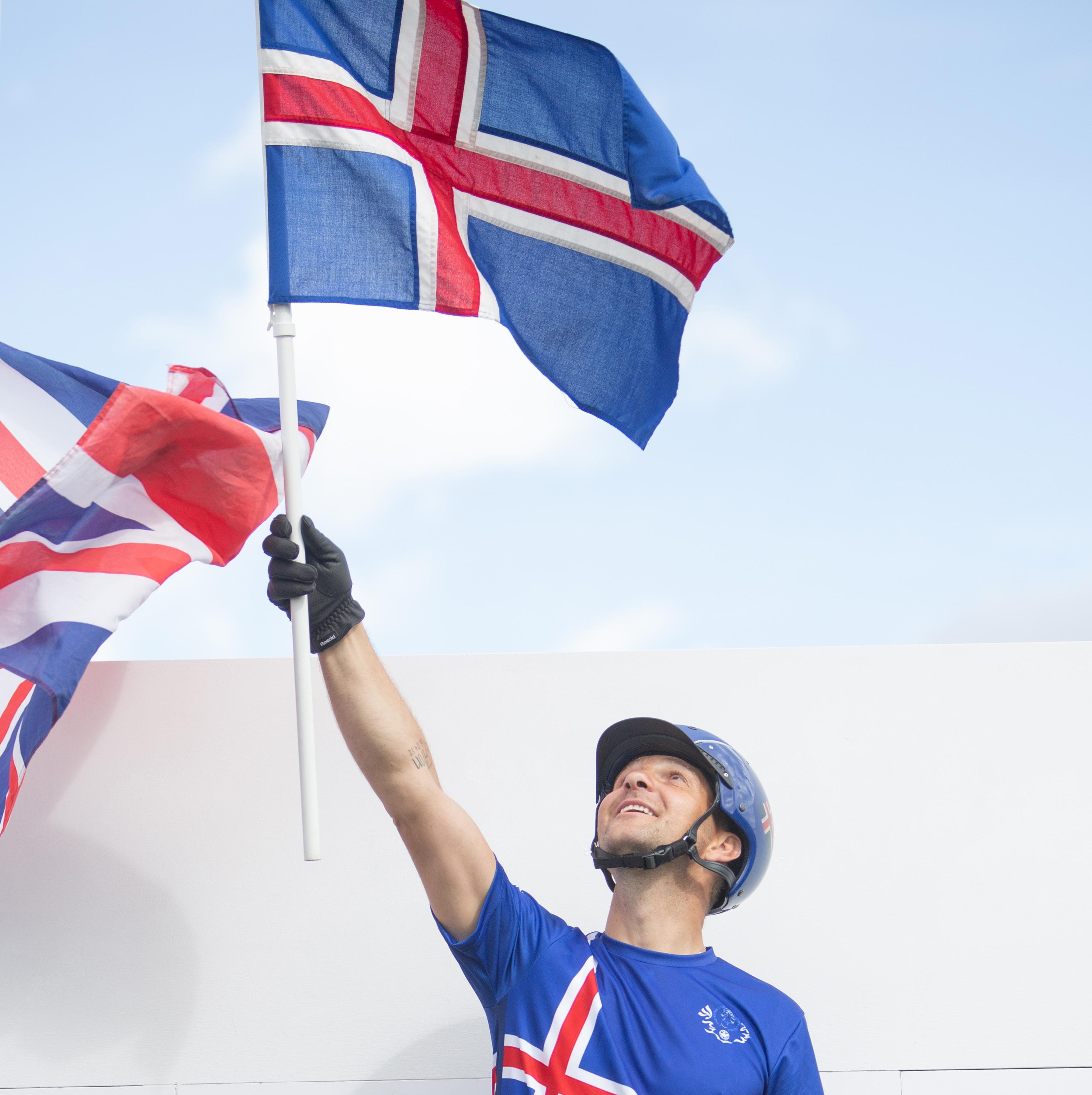
Beggi won four times in a row
Year Rider
Horse
2019 Guðmundur Björgvinsson Glúmur frá Þóroddsstöðum IS
2017 Markus Albrecht Schoch Kóngur frá Lækjamóti CH
2015 Guðmundur Einarsson Sproti frá Sjávarborg SE
2013 Bergþór Eggertsson Lótus frá Aldenghoor IS
2011 Bergþór Eggertsson Lótus frá Aldenghoor IS
2009 Bergþór Eggertsson Lótus frá Aldenghoor IS
2007 Bergþór Eggertsson Lótus frá Aldenghoor IS
2005 Magnús Skúlason Mjölnir frá Dalbæ SE
2003 Magnús Skúlason Mjölnir frá Dalbæ SE
2001 Anna Björnsson Mjölnir frá Dalbæ SE
1999 Sigurbjörn Bárðarson Gordon frá Stóru-Ásgeirsá IS
1997 Logi Laxdal Sprengi-Hvellur frá Efstadal IS
1995 Rikke Jensen Baldur frá Sandhólar DK
1993 Hinrik Bragason Eitill f. Akureyri IS
1991 Ulf Lindgren Hrafnketill frá Sauðárkróki SE
1989 Vera Reber Frosti f. Fáskrúðabakki DE
1987 Reynir Aðalsteinsson Spói IS
1985 Dorte Rasmussen Blossi fra Endrup Hegn DK
1983 Tómas Ragnarsson Fjölnir frá Kvíabekk IS
1981 Sigurbjörn Bárðarson Adam frá Hólum IS
1979 Barla Barandun Vikingur CH
1977 Sigurður Sæmundsson Leiknir frá Dýrfinnustöðum IS
1975 Bruno Podlech Hreinn frá Gullberastöðum DE
1972 Barla Maissen Vikingur CH
1970 Barla Maissen Vikingur CH
250 METERS PACE P1
Pace racing has been contested since the beginning of the Championships. First the track was 200 m. then it was changed to 250 m. in 1989.
Bergthór Eggertsson has won this event the most times, four Championships in a row, riding Lotus frá Aldenghoor. In the picture, he is sitting Besti frá Upphafi, on which he competed at the last World Championship.
Icelanders have won the 250 m. pace twelve times out of 25. Sweden comes next with five titles.
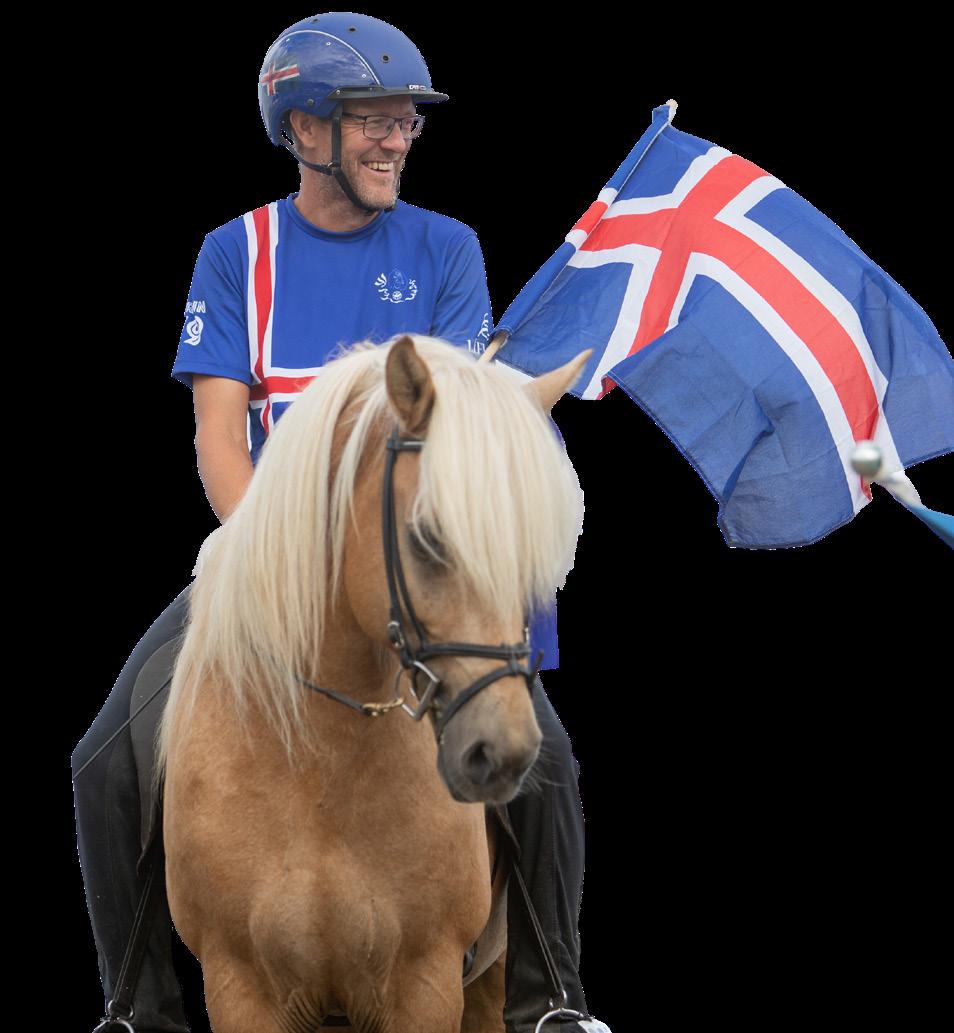
100 M. PACE - Sweden and Iceland with the same number of titles
The youngest discipline
100 M. PACE P1
Riders and horses have paced 100 m. at ten World Championships. Of these ten events, the Icelanders have won three times and so have the Swedes.

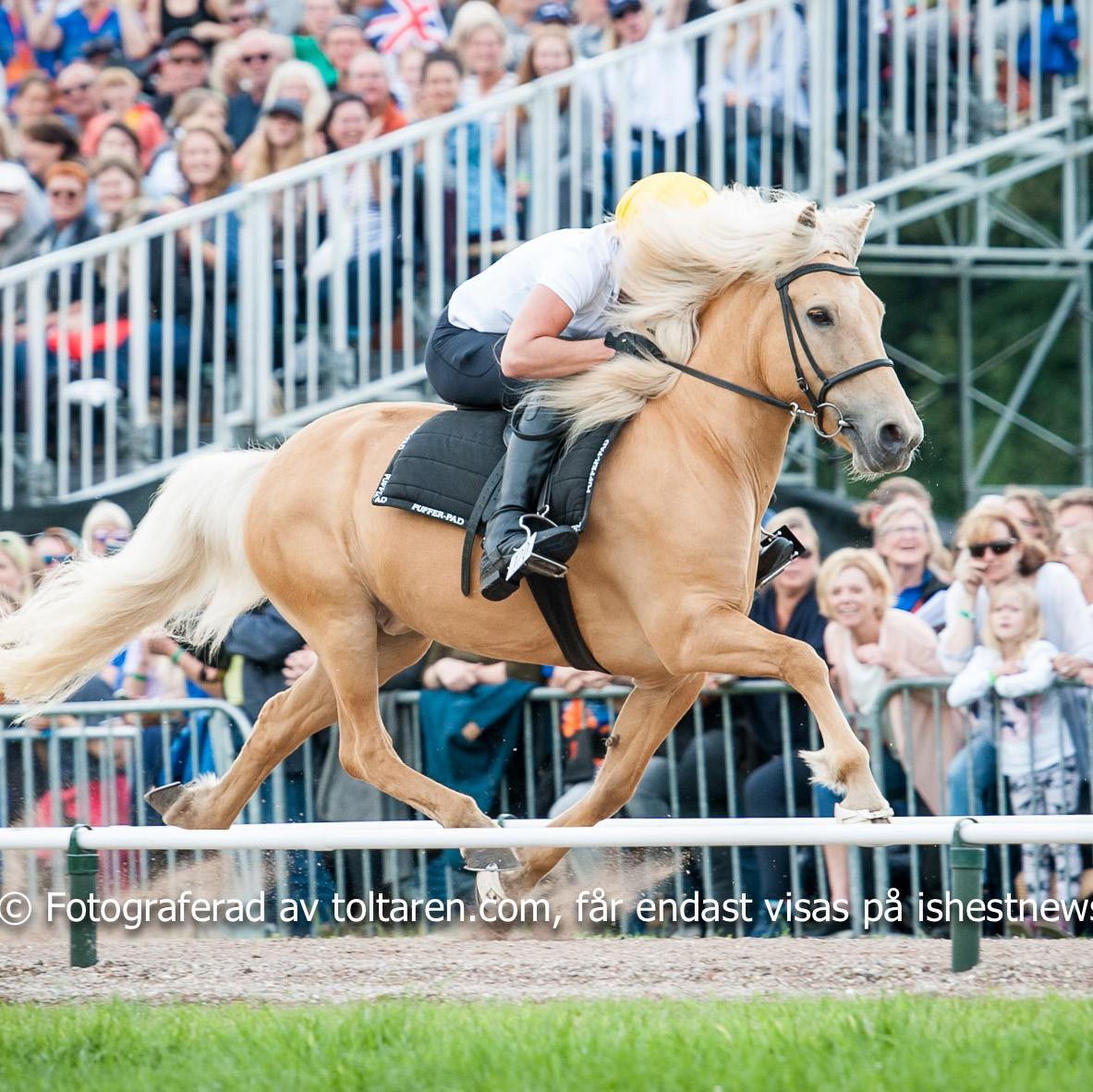
Britain’s first and only gold was won in this event. Charlotte Cook riding Sæla frá Þóreyjarnúpi, a memorable performance.
Year Rider Hestur Land
2019 Konráð Valur Sveinsson Losti frá Ekru IS
2017 Charlotte Cook Sæla frá Þóreyjarnúpi GB
2015 Helmut Bramesfeld Blöndal vom Störtal DE
2013 Josefin Birkebro Gná från Dahlgården SE
2011 Tania Højvang Olsen Sólon fra Strø DK
2009 Tania Højvang Olsen Sólon fra Strø DK
2007 Bergþór Eggertsson Lótus frá Aldenghoor IS
2005 Anna Björnsson Brynja frá Glæsibæ SE
2003 Magnus Lindquist Thor från Kalvsvik SE
2001 Sigurbjörn Bárðarson Gordon frá Stóru-Ásgeirsá IS
Other disciplines
Disciplines at the Championships have been of all kinds, many were tried once and never competed in again, while others were successful and became future disciplines at the Championships. For a long time riders competed in dressage and cross-country but those disciplines are no longer part of the Championships. Since 2003, there has been no changes in what disciplines riders compete in, the only thing that has been added is that since 2013 young riders have competed in their own age class.
Year Rider Horse Disciplines
2001 Karly Zingsheim Dökkvi frá Mosfelli DE FS1 Free Style
1999 Jolly Schrenk Ofeigur DE FS1 Free Style
1997 Doris Kainzbauer Kópar frá Hrepphólum AT FS1 Free Style
1995 Doris Kainzbauer Kópar frá Hrepphólum AT FS1 Free Style
1993 Sandra Feldmann Glamp f. Erbeldinger Hof DE FS1 Free Style
1991 Brigitte Karmus Þridi f. Hausruckhof AT FS1 Free Style
1989 Karly Zingsheim Loftfari f. Basselthof DE FS1 Free Style
1987 Carla van Nunen Frodi frá Breidablik NL Cross-country
1987 Helmut Lange Bjort DE FS1 Free Style
1985 Lone Jensen Grani fra Nymindegab DK FS1 Free Style
1985 Line Haugslien Snækollur frá Eyvindarmúla NO Cross-country

1983 Walter Feldmann jr. Magnús von Grenzland DE FS1 Free Style
1983 Heidi Nilsen Hera frá Kirkjubæ NO Cross-country
1981 Walter Feldmann jr. Eldjárn frá Langelandsgården DE Dressage
1981 Nils Henning Sonne Andersen Rex frá Ártún NO Cross-country
1979 Walter Schmitz Baldur frá Stokkhólma DE Dressage
1979 Christiane Mathiesen Gammur frá Hofsstöðum DE Dressage
1979 Jeanette Vring Kópur frá Hólmi NL Cross-country
1977 Heinrich Jud Dreyri frá Ytra-Dalsgerði CH Dressage
1977 Brigitte Nagel Goði frá Sandhólaferju CH Dressage
1977 Walter Feldmann jr. Eldjárn frá Langelandsgården DE Dressage
1977 Martin Dischinger Kópur frá Velli FR Cross-country
1975 Albert Jónsson Ljóski frá Hofsstöðum IS Dressage B
1975 Walter Feldmann jr. Funi frá Kaupvangi DE Dressage C
1975 Walter Feldmann jr. Funi frá Kaupvangi DE Cross-country
1975 Heinrich Jud Þór frá Miðal CH Jumping
1972 Eveline Meier Hassan CH Dressage C
1972 Barla Maissen Vikingur CH Cross-country
1972 Joachim Berg Vafi DE Endurance race
1970 Barla Maissen Vikingur CH Endurance race
1970 Walter Feldmann jr. Funi frá Kaupvangi DE Dressage
AWARDS - Over the years riders have been awarded for their combined performance
Combination winners
FOUR GAIT COMBINATION
Ár Knapi
Hestur
2019 Jóhann R. Skúlason Finnbogi frá Minni-Reykjum IS

2017 Johanna Tryggvason Fönix frá Syðra-Holti DE
2015 Johanna Tryggvason Fönix frá Syðra-Holti DE
2013 Jóhann R. Skúlason Hnokki frá Fellskoti IS
2011 Eyjólfur Þorsteinsson Ósk frá Þingnesi IS
2009 Jóhann R. Skúlason Hvinur frá Holtsmúla 1 IS
2007 Jóhann R. Skúlason Hvinur frá Holtsmúla 1 IS
2005 Jóhann R. Skúlason Hvinur frá Holtsmúla 1 IS
2003 Stian Pedersen Jarl frá Miðkrika NO
1987 Karly Zingsheim Loftfari DE
1985 Johannes Hoyos Fjölnir frá Kvíabekk AT
FIVE GAIT COMBINATION
Ár Knapi Hestur
2019 Magnús Skúlason Valsa från Brösarpsgården SE
2017 Magnús Skúlason Valsa från Brösarpsgården SE
2015 Reynir Örn Pálmason Greifi frá Holtsmúla 1 IS
2013 Magnús Skúlason Hraunar frá Efri-Rauðalæk SE
2011 Magnús Skúlason Hraunar frá Efri-Rauðalæk SE
2009 Rúna Einarsdóttir-Zingsheim Freyr vom Nordsternhof IS
2007 Þórarinn Eymundsson Kraftur frá Bringu IS
2005 Styrmir Árnason Hlynur frá Kjarnholtum I IS
2003 Johan Häggberg Askur från Håkansgården SE
1987 Reynir Aðalsteinsson Spói IS
1983 Tómas Ragnarsson Fjölnir frá Kvíabekk IS
Combination winners
The implementation of the combined winners has been different over the years at the Championships. Today, separate awards are given for the combined four- and five-gaited displines. In the beginning, a prize was awarded for the rider with the highest score and over the years it has evolved. Which disciplines counted varied, but here are the tables of the overall winners and winners in the four-gait and five-gait combinations.
Jóhann R. Skúlason has most often won the four-gait combination prize, with five titles. Magnús Skúlason has most often won the five-gait combination with four titles, and Sigurbjörn Bárðarson and Walter Feldmann jr. have been combined winners four times each.
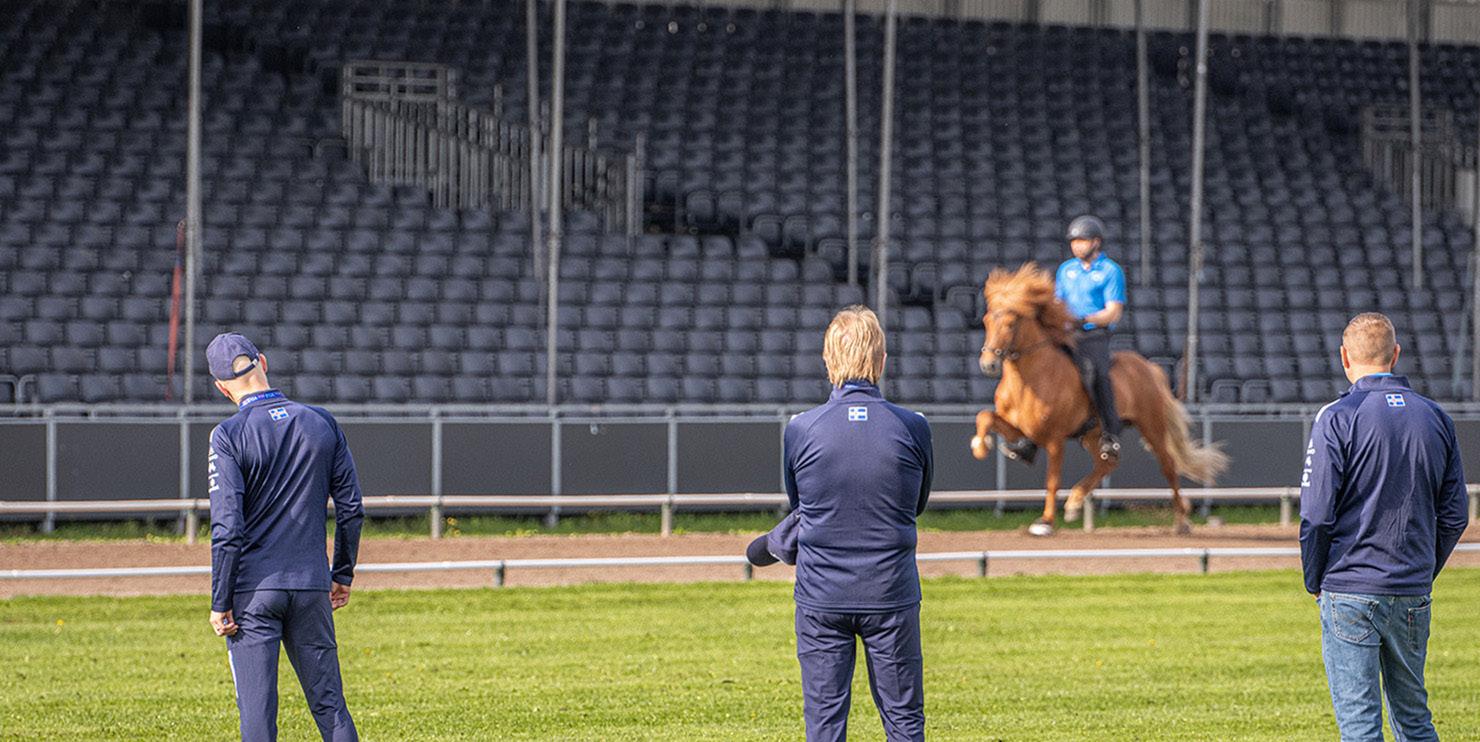


COMBINED WINNERS
Year Rider Horse
2001 Vignir Jónasson Klakkur frá Búlandi IS
1999 Sigurbjörn Bárðarson Gordon frá Stóru-Ásgeirsá IS
1997 Sigurbjörn Bárðarson Gordon frá Stóru-Ásgeirsá IS
1995 Sigurður V. Matthíasson Huginn frá Sauðárkróki IS
1993 Sigurbjörn Bárðarson Höfði frá Húsavík IS
1991 Johannes Hoyos Fjölnir frá Kvíabekk AT
1989 Unn Kroghen Strákur frá Kirkjubæ NO
1981 Sigurbjörn Bárðarson Adam frá Hólum IS IS
1979 Ragnar Hinriksson Fróði frá Ásgeirsbrekku IS
1977 Walter Feldmann jr. Eldjárn frá Langelandsgarden DE
1975 Walter Feldmann jr. Funi frá Kaupvangi DE
1972 Walter Feldmann jr. Funi frá Kaupvangi DE
1970 Walter Feldmann jr. Funi frá Kaupvangi DE
Photo: IrisVanVelzenFotografie
From an Idea to Reality
The inception of HorseDay was a result of Ólafur H. Einarsson’s longstanding contemplation. Ólafur, better known as Óli Haddi, had been a horse farmer at Hvoll in Ölfus for nearly three decades. Despite his involvement in the equestrian industry, he had also pursued studies in computer science and engaged in programming and teaching. Throughout his years, Ólafur often pondered ways to enhance efficiency in working with horses, improve communication with clients, and maintain a comprehensive record of each horse’s care and training. He expressed, “The ability to revisit training histories, track their careers, and observe periods of progress has always been a recurring thought.” In 2009, he formulated the concept for a program and penned an article with intentions to publish it in Eidfaxi, but it seemingly never made its way into print.
When the Covid pandemic struck, the entire tourism industry, includingÓlafur’s family at Hvoll, was brought to a halt. This prompted Ólafur to
resurrect his old idea and engage in discussions with his children, Oddur and Marta Rut. Both had grown up on the Hvoll horse farm, with Oddur pursuing a master’s degree in business administration at that time and Marta working in the field of engineering, specifically on artificial intelligence, following the completion of her studies. Together, they formed a capable team equipped with extensive knowledge of the Icelandic horse community and technical expertise, which they harnessed to bring the HorseDay project to life.
Started out as a family business
Following thoughtful consideration
within the family, it became evident that they were determined to give their idea a shot. They took the initiative to apply for a grant from SASS (Association of Southern Municipalities) to embark on their initial endeavors. Securing the necessary funding propelled them to advance their concept to the next stage. Thus, HorseDay was founded by Oddur Ólafsson, Marta Rut Ólafsdóttir, and Ólafur H. Einarsson. Since then, additional investors have joined their ranks, with the Business Innovation Fund (Nýsköpunarsjóður Atvinnulífsins) playing a prominent role. Financial support has also been received from the Technical Development

164 | Eiðfaxi International
Ásta Björk Friðjónsdóttir
It started as a family business, lft. Marta, Ingibjörg, Margrét, Ólafur og Oddur. The HorseDay project came to life during the Covid pandemic and last year the first version of the app became a reality.
Fund (Tækniþróunarsjóður) and the Professional Council for Horse Breeding in Iceland (Fagráð í hrossarækt). The HorseDay team has been expanding, currently comprising seven dedicated individuals. Oddur assumes the role of CEO, while Ólafur oversees product development. Additionally, three programmers and two marketing and sales representatives contribute their expertise to the venture.
Efficient horse management
After devoting approximately two years to developing and designing the app, followed by extensive engagement with equestrian enthusiasts, receiving invaluable feedback and suggestions, the HorseDay app was finally deemed ready for release. The app, introduced in the spring of 2022, caters specifically to the Icelandic horse community and
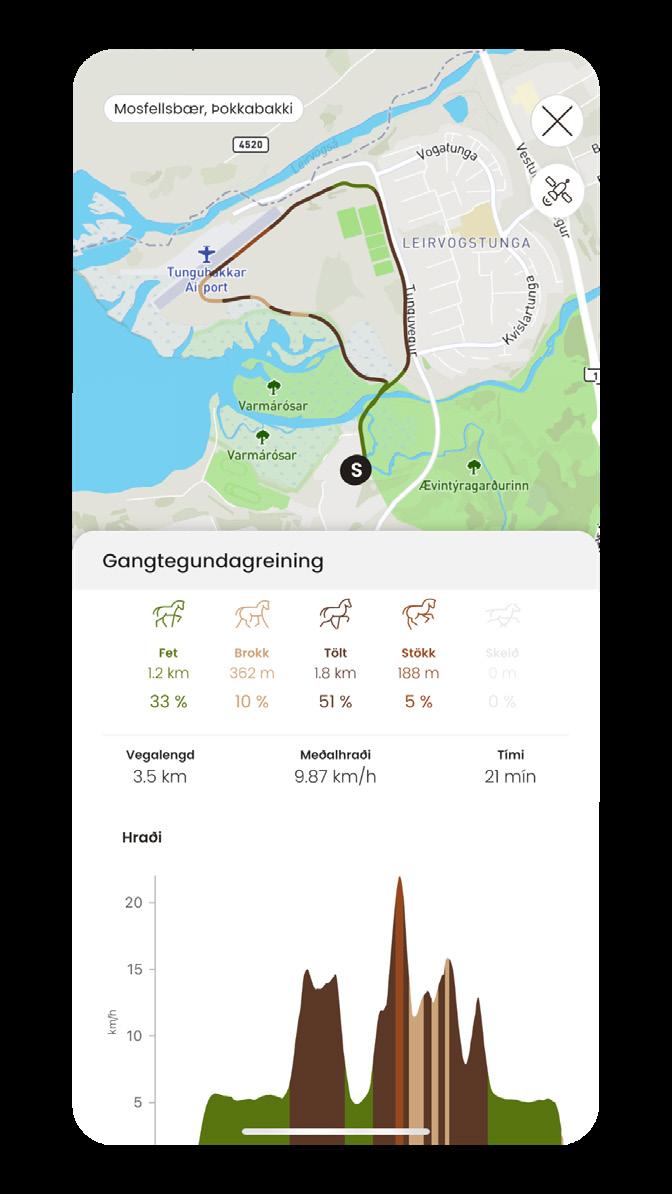

its associated network. Its primary purpose is to facilitate efficient horse management by providing users with a comprehensive tool to record various activities pertaining to their horses. These include training sessions, farrier visits, veterinary care and more. HorseDay employs a ride tracking and logging system reminiscent of outdoor enthusiast programs like Strava. Moreover, the team has incorporated artificial intelligence technology that leverages

Eiðfaxi International | 165 Þórður Þorgeirsson
Screen-shots from the HorseDay app which primary purpose is to facilitate efficient horse management by providing users with a comprehensive tool to record various activities pertaining to their horses. HorseDay employs a ride tracking and logging system reminiscent of outdoor enthusiast programs like Strava.





Distance Sessions Time


168 | Eiðfaxi International
Siblings on a career track Interview
Easy going but very competitive“
„
Hulda Finnsdóttir hulda@eidfaxi.is
Translations: Berglind Margo
Sól Snorradóttir are known by most people following competitions in Iceland. The siblings have all become successful riders and have in common the facts that they started riding very young on the pommel of their parents’ saddle, walked between stables with their saddle on the back to tame horses and are now all part of the national team group. A journalist sat down with them at Árbakki where Jóhanna Margrét works and discussed with them to find out the recipe to successful riders.

Eiðfaxi International | 169
Ásmundur Ernir Snorrason, Jóhanna Margrét Snorradóttir and Signý
The siblings all inherited the horse bacteria from their parents Snorri Ólason and Hrönn Ásmundsdóttir. They grew up in Keflavík and were all young when they started riding with their parents in the riding club Máni. Ásmundur or Ási as he is often called is the oldest and born 1992. Three years separate him from Jóhanna Margrét (born 1995), most often called Hanna Magga and twelve years separate him from Signý (born 2004).
“Mom and dad were both into horses but when I started riding, mom was spending time at home with little Hanna Magga so she was much less in the stables. I do not remember her being there until Hanna Magga started riding” says Ásmundur. He soon started to walk between stables with his father who has always been taming horses in the area. “Yes, I was not old when I started stumbling around with my dad with my saddle on my back. We were all doing it and Signý still is today” says Ásmundur and looks at his sisters.
It was similar for me except that mom was with us more. She used to lead me, usually on some of Ási’s horses and he was not happy about it” says Jóhanna Margrét and laughs. “I don’t remember that, the memories must have been stronger for her” says Ási sarcastically.
The sibling all started to compete early, their parents were good at finding them horses so they started early as in toddlers class. “I remember the first time I competed in toddlers class, I was maybe 7 years old, and we were all placed in different seats. When they read the results and my name came last I got very angry because I thought I had lost. Mom and dad corrected that and I was a little happier with having won” says Ásmundur, his competitiveness came to light early.
Djákni frá Feti was Ásmundur and Jóhanna Margrét’s first competition horse. At 11 years old, Ásmundur started training Djákni who was then 5 years old. In 2004, he competed with him at Landsmót in children’s class and ended up in third position. At Landsmót 2006, Hanna Magga competed on him and also ended in third place. Even though the siblings had to share horses, it was never an arguing point to decide who got which horse.


170 | Eiðfaxi International
Ásmundur Ernir and Glóð frá Keflavík
Jóhanna Margrét 7 years old and Krákur frá Skarði í Landsveit
“It was all rather clear. There were never any problems with this. Maybe I was a little upset but I just don’t remember that. I started with one horse, then got a new one and Hanna Magga then got the old one. Mom and dad didn’t necessarily have the means to buy very good horses that were ready for us. For example, Djákni was bought rather raw, young, and cheap. It was up to us to get things out of him” says Ásmundur; After Djákni, he got to work with the mare Djásn frá Hlemmiskeiði which became his competition horse and Djákni went to Hanna Magga.
“Dad and I were training in
the club’s riding hall, Sigurður Ragnarsson was also there and very angry with the mare and wanted to get rid of her. Dad buys her from him on the spot and the decision was made that I would take this mare, Djásn, and make her my new competition horse and Hanna Magga would get Djákni” says Ásmundur and Hanna Magga adds “yes, we were rather easy going with this. Maybe there was a little annoyance when Djásn changed riders”
Djásn and Ási did well on the competition track and were always in A finals in tölt and four-gait at the Icelandic Championships and in A

finals at Landsmót 2008. After the 2008 summer, Ásmundur had gotten enough of horses and wanted to start doing something else. He had been helping his father taming every day after school and on all weekends and wanted to try something new.
“At that time, I was full on into boxing and going to the gym and told our parents that I was quitting and went to work at a cash register in Samkaup (a local shop). I think I quit horse riding for 2 months when I could not work at a cash register anymore and wanted to go back to riding. Mom and Dad then told me that Hanna Magga now had Djásn
Eiðfaxi International | 171 Siblings on a career track
Signý Sól and Strengur frá Arnarhól
„
I was not old when I started stumbling around with my dad with my saddle on my back
since I had quit. I was not happy about that,” says Ásmundur but Hanna Magga corrects him; “they told you before you quit that if you did then I would get Djásn. They just stood firm on their decision and I had Djásn. I remember that I celebrated a little bit the fact that he had quit and I now had the mare.”
Ásmundur was not without a horse for a long time though as a beautiful red horse with whom Ásmundur would do well on the competition track was in the stable. “I had to
start over again and make the next competition horse ready. We went over what was in the stable and most horses inside came from our own breeding. That’s when I started on Reyr frá Melabergi, he had a beautiful color, was very nice but that was pretty much it” he says but Reyr and Ásmundur became, in between other things, Icelandic champions in tölt in young rider’s class.
Like her siblings, Signý Sól was very young when she started riding and she remembers her first horse,
Strengur, which she thinks was not really a children’s horse. “He was very afraid of things and always putting his head down so I sometimes just rolled off on his neck” she says and her brother adds “he was actually a great children’s horse. He was incredibly nice to Signý but when an adult rode him then he was not very nice. A man came to try him for his wife once. The horse bucked him off on the curb. Typical children’s horse, super nice to the kids – otherwise not so nice.”

172 | Eiðfaxi International

When Signý Sól starts riding, Ásmundur and Jóhanna Margrét had moved out of the house so they did not follow their sister much in her riding.

“I think Mom and Dad’s stable is full of Signý’s horses. We only got one box each,” says Hanna Magga and Ásmundur adds “Yes, there is a slight difference. Everything is done for Signý but we only had one box each and had to tame horses after school to be allowed to have them,” the sibling laughed heartily and added that things are maybe not exactly like that and that their sister is very hardworking and helps their parents a lot. “These are just different times”.
Ási and Hanna Magga went to work on training in other places during the summer and Hanna Magga went east of the mountains a lot until she went to Hólar in 2015 which is when she moved out of the family home indefinitely. Today, she works at Árbakki with her boyfriend, Gústaf Ásgeir Hinriksson. Ásmundur stayed a long time with Sigurður Sigurðarson at Þjóðólfshagi, then went to Efsti-Dalur and on to Skeiðvellir. Ásmundur was then training in Keflavík for two years with his wife Stella Sólveig Pálmarsdóttir before they moved to Strandahöfuð in the summer of 2014 where they still are today.
“I am just riding out at home and also training for others. I will finish high school around Christmas of 2023 and plan on going to Hólar after that” says Signý and adds that
174 | Eiðfaxi International
she has worked one summer for each of her sibling which was very fun.
“She has so many horses that it’s hard for her to find a place to work at because she’d like to bring so many horses with her as well” adds Hanna Magga.
What’s the recipe?
What is it that made you all decide to stick to horse riding and made you this successful?
“I don’t really know. I remember that Mom and Dad never pushed us into this. It wasn’t mandatory, riding was completely a choice we had. I always remember that. Going on horseback was always very open for us if we wanted to and we apparently all got infected with the horse bacteria” says Ásmundur and his sisters agree.
They probably got what made them such successful riders from their parents who are different in a fun way.
“Dad is very much a horseman and he taught us all the basics,” says Ásmundur and Hanna Magga adds that their mother also did. “Yes, but it was different. Ok, the reason for which we’re all successful riders is maybe the mix of them. Dad is extremely calm and much of a feeling man when it comes to horses and then comes Mom with a competitive attitude and pours that over us. She was always a little…” he continues, and Hanna Magga cuts in “In it to win it. She made the competitiveness in us”.
They all agree that the competitiveness comes from their mother who had a special tactic to pep them up before they entered the track.
“I remember when I was warming up in children’s class. Mom always said to me: Ási, are you really going to have the mare like this. She’s not special to look at. She knew I’d get in the mood, she knew exactly what she had to say to us so we’d get the best results,” says Ási and adds that the recipe is probably this good mix of their mother and father. “He was completely calm and then Mom is on the other side crazy about competition, pushing us over the line.” Sígný Sól is starting to worry that their Mom is going to look bad in this interview but Ási comforts her by saying that this is only the truth.
All in
All three agree that their parents poured their life and soul into doing everything for them and they are very thankful to them.
They sacrificed a lot for us. They
bought horses who ended up beijing ours instead of theirs. Before we came to the picture they enjoyed competing. They completely put the priority on us,” says Hanna Magga and Ásmundur agrees “they were always willing to help and motivate us. I remember when I was once training Glóð frá Keflavík on Máni’s (the riding club) oval track, she was not very nice and Dad was talking to some man who was there in a car. Believe it or not, the mare starts running with me up to the car, stops in front of the hood where I fly off onto the windshield. Dad and the man just looked at me and asked if everything was ok. By then, I was really good at steering myself up in the air to find out how to land when I fell because I fell so often. Dad always came with this great sentence; You have to fall off a hundred times before you become a horseman. I took it very seriously and celebrated each time – yes number 76, it’s getting closer.”
“I remember this sentence too,” adds Hanna Magga. “Each time was celebrated to keep us motivated.
Eiðfaxi International | 175 Siblings on a career track
„
The mare starts running with me up to the car, stops in front of the hood where I fly off onto the windshield
I also remember that they never differentiated between us. We were once together on the track. Ási was preparing for a competition and I was rather small and just riding along. Mom and Dad were giving him instructions in a rather decided way and then looked at me from time to time and complimented me. After a few rounds around the track, I asked them when they were going to start screaming at me like that. So dad started to scream at me too and it made me really happy.”
Snorri, their father, is an international sport judge and it has served them well and they still seek advice from him regularly.
“He can always come with the judge’s eye. Give us all kinds of advice
regarding speed and various finishing touches, rules and more,” says Signý and Ási adds that they all really look up to him. “I send him a video of all my training sessions and get him to have a look at them,” he adds. Hanna Magga says that sometimes there can be disagreements about the marks he gives, that the siblings can be demanding and do not always agree when they feel he is giving them a too low mark. “He never gives in. He stands his ground, and then you’ll hear: I’ll hear from you later, and he hangs up,” she adds and they all start laughing.
If we were horses?
The siblings are around horses day
and night and are very fascinated by the creature, its nature and character. It might therefore be interesting, just for fun, to imagine what kind of horses they would be if they were to metamorphose overnight.
“I think Ási would be like Spölur frá Njarðvík. He could be very calm and easy-going but was always ready to perform, do you disagree?,” says Hanna Magga and looks at her brother. “No, no, If I had to describe myself as a horse I would say calm with a great character but very powerful,” he adds and they burst out laughing.

“No, let’s see, if I had to describe us then we are actually very similar. We are all calm, we got that from Dad, and all a little shy although it has gotten better with age for us two but Signý is still dealing with that,” hes says and laughs before adding; “It would be a very similar horse that would come out of us three. Calm most of the time with strong competitiveness and extremely stubborn. When I analyze us I realize how really alike we are,” he continues. “You would be a horse that could throw someone off all of a sudden though” shoots Signý cheerfully and means her brother, “Hanna Magga would be sweeter”.
Helpful siblings
Having grown up in a stable together, Ásmundur and Jóhanna Margrét have always helped each other a lot. “Today we do not train together but we do discuss things and
176 | Eiðfaxi International
Ásmundur Ernir and Hlökk frá Strandarhöfði
Photo: Gísli Guðjósson
think about things together,” says Hanna Magga and Signý add “they have helped me a lot with my main competition horses. I have tried to go to other riding instructors but they suit me best. When I had Þokkadís frá Strandarhöfði, Ási and Stella were helping me a lot with her and are the reason why I had her. Then I competed on Kolbeinn frá Horni from Hanna Magga and Gústi and she has helped me with him since.”
Signý Sol became triple Icelandic Champion in teenage class in 2022 on the following three horses: Þokkadís in tölt, Kolbeinn in fourgait and Rafn frá Melabergi in loose rein tölt. A great achievement that this young rider will remember for a long time. “Icelandic champion on three

horses in three tests the same day. I think that was the best day of my life.”
The adventure with Bárður
We start to reminisce about the biggest moments in horsemanship and Hanna Magga brings up Bárður frá Melabergi as they became, among other things, Icelandic Champions and winners of Landsmót in fourgait in 2022 and triple Icelandic Champions this summer and will maybe be adding to their collection. Bárður, even though he is “from Melabergi”, is not from their parents’ breeding; it was Gunnar Auðunsson

Eiðfaxi International | 177 Siblings on a career track
Jóhanna Margrét and Bárður frá Melabergi
Photo: Jón Björnsson
Signý Sól and Kolbeinn frá Horni I
Photo: Brynja Gná Hreiðarsdóttir Bergmann
that bred the horse as he and the siblings’ parents have had good collaboration over the years.
“Mom and Dad then buy half of him when he is a young horse. Mom starts to ride him and Signý takes him from time to time with Mom. I am up North at Hólar and Signý was about to compete on him in loose rein tölt in the Youth Champions’ League. I am watching them and I really like him. I decide to call Mom after the competition and tell her jokingly that they won’t get to have him for much longer. She takes me seriously and brings him over to me in the spring of 2018 and he has never left since,” says Hanna Magga.
“Yes, but we may not forget that I taught him how to tölt,” adds Ásmundur. “I had him in training and the story around that is, looking back, annoying and sad. I was offered to buy him for a small amount of
money. I just did not have a small amount of money to buy him. I really wanted to buy him, it’s sad, I think about it often. Why didn’t I just borrow the money somewhere and sort this out.”
Happy for each other
Yes, opportunities can often slip through one’s fingers, but the journalist asks whether it was not painful to watch him go, especially once he and Hanna Magga started doing so well. “I myself had Spölur frá Njarðvík at that time and then Frægur frá Strandarhöfði. I think it’s fantastic that Hanna Magga got him and has done what she has done with him. It’s not a given either,” he answers and it’s obvious that there is a lot of mutual support among the siblings.
Spölur and Frægur are Ási’s
adventures as they represented Iceland at two World Championships together, in 2017 in the Netherlands riding Spölur and in 2019 in Germany riding Frægur.

“The build-up and the journeys to the World Championships with Spölur and Frægur are my favorite moments in my career even though they are only very short moments. To ride onto the track at the World Championships is a special experience that cannot be described. A whole crowd of cheering Icelanders. It’s an absolute goosebump moment. The build-up and the journeys to the World Championships with these two horses are my favorite moments. Even though I did not become World Champion, it taught me the most in my life,” he says and Hanna Magga agrees with him, but despite the fact that competing at the World Championships is a an incredible experience, the adventure with Bárður always stands out along with everything he has given her.
Even though the siblings are very competitive, they are happy for each other and especially for their little sister in the Young Rider’s class.
“Yes, there we can truly rejoice,” says Hanna Magga with a sense of certainty. “No but Ási and I are happy for each other even though we compete in the same class,” and Ási adds “it has probably been fortunate that when I was with Spölur and Frægur at the highest level, Bárður was being built up and when he gets to his top, the two others are gone, and I have something else building
178 | Eiðfaxi International
up. So, we haven’t directly competed against each other, - yet”
Hanna Magga adds that the relationship between siblings is also a little different since Ási and her grow up together more but since Signý is quite a lot younger they feel more responsible for her. “We grew up together and are best friends. We fight and have all the traditional sibling things and then she comes a little bit later and we are more taking care of her. It’s a different bond.”
All in the national team group
All three siblings are in the national team group. Hanna Magga and Ási in the A team and Signý in the younger team. Hanna Magga was aiming for the World Championship in Oirschot riding Bárður, Ási with Ás frá Strandarhöfði and Signý with Kolbeinn. Hanna Magga is now in the Icelandic team and will be competing at the World Championship in Oirschot with Bárður in tölt T1 and four-gait V1.

Who is most likely not to answer the phone?
Ásmundur Ernir answer both sisters at the same time.
Who is most likely not to keep a secret?
Á: Me
S: Hanna Magga
Á: What? Ok fine Hanna Magga
Who is most likely to break a world record?
All: Me
Who is most likely to eat something off the ground?
Á: Signý, that’s the first thing that comes to mind
SS: Ási, you’ve probably done it
Who is the most likely to get an ugly tattoo?
JM: Ásmundur has it
SS: Ási
Who is the most likely to win a Nobel prize?
Á: Isn’t that something for intelligent people? Not me.
SS: Hanna Magga
JM: I was the best of us in school
Who is the most likely to inadvertently poison someone with bad cooking?
Á: Definitely not me
SS: Me
Who is the most likely to cry over a movie?
JM: Signý
Who is the most likely to win the lottery?
Á: I buy the most tickets, Signý is the luckiest one of us though
Who is the most likely to negotiate something with your parents?
SS: Hanna Magga
Á: Really? Yes, maybe if we take the average.
SS: Yes, at least I was always told, if I did something negative that I was exactly like my brother and that I should be more like Hanna Magga.
Who is the most likely to run a marathon?
Á: Am I not crazy enough to take that up?
JM: Yes you are Ási.


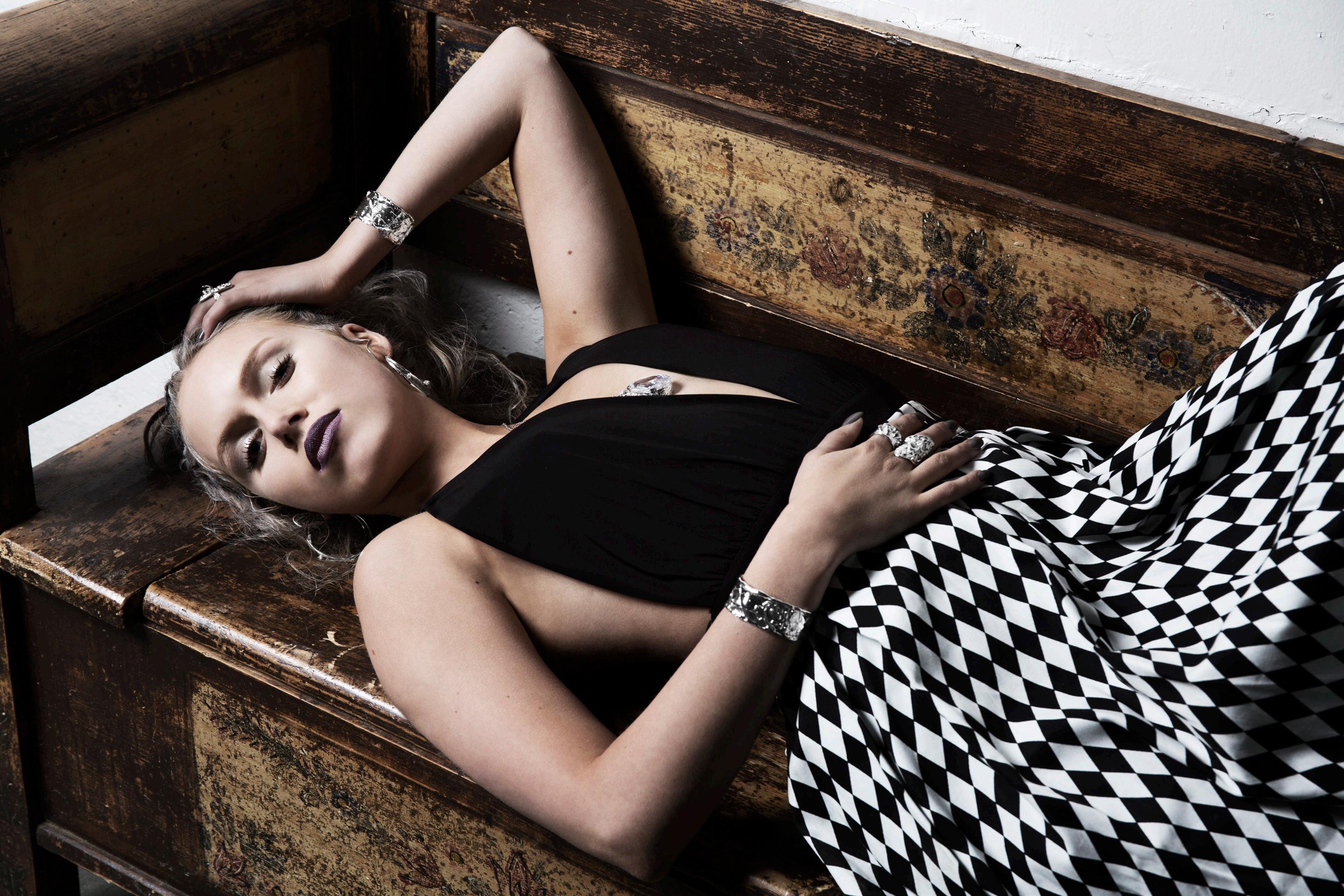


SIGN EHF | HAFNARFIRÐI | S:555 0800 | SIGN@SIGN.IS
































 Breeding farm of the year
Interview with Olil Amble & Bergur Jónsson
Hulda Finnsdóttir hulda@eidfaxi.is
Translation: Berglind Margo
Breeding farm of the year
Interview with Olil Amble & Bergur Jónsson
Hulda Finnsdóttir hulda@eidfaxi.is
Translation: Berglind Margo











































































































































































































































































































































 The breeding track at the WC in 2017 in Oirschot
Photo: Louisa Lilja
The breeding track at the WC in 2017 in Oirschot
Photo: Louisa Lilja















































































































